
Hydrogeologic Setting and Conceptual
Hydrologic Model of the Spring Creek
Basin, Centre County, Pennsylvania,
June 2005
By John W. Fulton, Edward H. Koerkle, Steven D. McAuley, Scott A. Hoffman, and
Linda F. Zarr
U.S. Department of the Interior
U.S. Geological Survey
In cooperation with the ClearWater Conservancy
Scientific Investigations Report 2005-5091

U.S. Department of the Interior
Gale A. Norton, Secretary
U.S. Geological Survey
P. Patrick Leahy, Acting Director
U.S. Geological Survey, Reston, Virginia: 2005
For sale by U.S. Geological Survey, Information Services
Box 25286, Denver Federal Center
Denver, CO 80225
For more information about the USGS and its products:
Telephone: 1-888-ASK-USGS
World Wide Web: http://www.usgs.gov/
Any use of trade, product, or firm names in this publication is for descriptive purposes only and does not imply
endorsement by the U.S. Government.
Although this report is in the public domain, permission must be secured from the individual copyright owners to repro-
duce any copyrighted materials contained within this report.
Suggested citation:
Fulton, J.W., Koerkle, E.H., McAuley, S.D., Hoffman, S.A., and Zarr, L.F., 2005, Hydrogeologic setting and conceptual
hydrologic model of the Spring Creek Basin, Centre County, Pennsylvania, June 2005:
U.S. Geological Survey Scientific
Investigations Report 2005-5091, 83 p.

iii
Contents
Abstract. . . . . . . . . . . . . . . . . . . . . . . . . . . . . . . . . . . . . . . . . . . . . . . . . . . . . . . . . . . . . . . . . . . . . . . . . . . . . . . . . . . . . . . . . . . . . . . . . . . . . 1
Introduction . . . . . . . . . . . . . . . . . . . . . . . . . . . . . . . . . . . . . . . . . . . . . . . . . . . . . . . . . . . . . . . . . . . . . . . . . . . . . . . . . . . . . . . . . . . . . . . . . 1
Purpose and Scope . . . . . . . . . . . . . . . . . . . . . . . . . . . . . . . . . . . . . . . . . . . . . . . . . . . . . . . . . . . . . . . . . . . . . . . . . . . . . . . . . . . 1
Description of Study Area . . . . . . . . . . . . . . . . . . . . . . . . . . . . . . . . . . . . . . . . . . . . . . . . . . . . . . . . . . . . . . . . . . . . . . . . . . . . . 1
Physical Characteristics of Spring Creek Basin . . . . . . . . . . . . . . . . . . . . . . . . . . . . . . . . . . . . . . . . . . . . . . . . . . . . . . . . . . . . . . 3
Climate . . . . . . . . . . . . . . . . . . . . . . . . . . . . . . . . . . . . . . . . . . . . . . . . . . . . . . . . . . . . . . . . . . . . . . . . . . . . . . . . . . . . . . . . . . . . . . . 7
Precipitation. . . . . . . . . . . . . . . . . . . . . . . . . . . . . . . . . . . . . . . . . . . . . . . . . . . . . . . . . . . . . . . . . . . . . . . . . . . . . . . . . . . . . 7
Air Temperature . . . . . . . . . . . . . . . . . . . . . . . . . . . . . . . . . . . . . . . . . . . . . . . . . . . . . . . . . . . . . . . . . . . . . . . . . . . . . . . . 12
Humidity. . . . . . . . . . . . . . . . . . . . . . . . . . . . . . . . . . . . . . . . . . . . . . . . . . . . . . . . . . . . . . . . . . . . . . . . . . . . . . . . . . . . . . . . 12
Solar Radiation . . . . . . . . . . . . . . . . . . . . . . . . . . . . . . . . . . . . . . . . . . . . . . . . . . . . . . . . . . . . . . . . . . . . . . . . . . . . . . . . . 12
Evaporation . . . . . . . . . . . . . . . . . . . . . . . . . . . . . . . . . . . . . . . . . . . . . . . . . . . . . . . . . . . . . . . . . . . . . . . . . . . . . . . . . . . . 12
Physiography . . . . . . . . . . . . . . . . . . . . . . . . . . . . . . . . . . . . . . . . . . . . . . . . . . . . . . . . . . . . . . . . . . . . . . . . . . . . . . . . . . . . . . . . 13
Topography . . . . . . . . . . . . . . . . . . . . . . . . . . . . . . . . . . . . . . . . . . . . . . . . . . . . . . . . . . . . . . . . . . . . . . . . . . . . . . . . . . . . . . . . . . 13
Land Use. . . . . . . . . . . . . . . . . . . . . . . . . . . . . . . . . . . . . . . . . . . . . . . . . . . . . . . . . . . . . . . . . . . . . . . . . . . . . . . . . . . . . . . . . . . . . 15
Hydrogeologic Setting of Spring Creek Basin . . . . . . . . . . . . . . . . . . . . . . . . . . . . . . . . . . . . . . . . . . . . . . . . . . . . . . . . . . . . . . . 18
Soils . . . . . . . . . . . . . . . . . . . . . . . . . . . . . . . . . . . . . . . . . . . . . . . . . . . . . . . . . . . . . . . . . . . . . . . . . . . . . . . . . . . . . . . . . . . . . . . . . 18
Geology. . . . . . . . . . . . . . . . . . . . . . . . . . . . . . . . . . . . . . . . . . . . . . . . . . . . . . . . . . . . . . . . . . . . . . . . . . . . . . . . . . . . . . . . . . . . . . 18
Surface Water . . . . . . . . . . . . . . . . . . . . . . . . . . . . . . . . . . . . . . . . . . . . . . . . . . . . . . . . . . . . . . . . . . . . . . . . . . . . . . . . . . . . . . . 28
Ground Water. . . . . . . . . . . . . . . . . . . . . . . . . . . . . . . . . . . . . . . . . . . . . . . . . . . . . . . . . . . . . . . . . . . . . . . . . . . . . . . . . . . . . . . . 34
Aquifer Properties . . . . . . . . . . . . . . . . . . . . . . . . . . . . . . . . . . . . . . . . . . . . . . . . . . . . . . . . . . . . . . . . . . . . . . . . . . . . . . 34
Water Levels. . . . . . . . . . . . . . . . . . . . . . . . . . . . . . . . . . . . . . . . . . . . . . . . . . . . . . . . . . . . . . . . . . . . . . . . . . . . . . 38
Wells and Springs . . . . . . . . . . . . . . . . . . . . . . . . . . . . . . . . . . . . . . . . . . . . . . . . . . . . . . . . . . . . . . . . . . . . . . . . 38
Water Quality. . . . . . . . . . . . . . . . . . . . . . . . . . . . . . . . . . . . . . . . . . . . . . . . . . . . . . . . . . . . . . . . . . . . . . . . . . . . . . . . . . . 44
Surface Water . . . . . . . . . . . . . . . . . . . . . . . . . . . . . . . . . . . . . . . . . . . . . . . . . . . . . . . . . . . . . . . . . . . . . . . . . . . . 46
Ground Water . . . . . . . . . . . . . . . . . . . . . . . . . . . . . . . . . . . . . . . . . . . . . . . . . . . . . . . . . . . . . . . . . . . . . . . . . . . . 46
Conceptual Hydrologic Model of Spring Creek Basin . . . . . . . . . . . . . . . . . . . . . . . . . . . . . . . . . . . . . . . . . . . . . . . . . . . . . . . 47
Precipitation, Runoff, Infiltration, and Streamflow . . . . . . . . . . . . . . . . . . . . . . . . . . . . . . . . . . . . . . . . . . . . . . . . . . . . . 49
Siliciclastic-Bedrock Uplands . . . . . . . . . . . . . . . . . . . . . . . . . . . . . . . . . . . . . . . . . . . . . . . . . . . . . . . . . . . . . . . . . . . . . . . . 49
Hydrologic Boundaries . . . . . . . . . . . . . . . . . . . . . . . . . . . . . . . . . . . . . . . . . . . . . . . . . . . . . . . . . . . . . . . . . . . . . . . . . 49
Surface Water . . . . . . . . . . . . . . . . . . . . . . . . . . . . . . . . . . . . . . . . . . . . . . . . . . . . . . . . . . . . . . . . . . . . . . . . . . . . . . . . . 50
Ground Water . . . . . . . . . . . . . . . . . . . . . . . . . . . . . . . . . . . . . . . . . . . . . . . . . . . . . . . . . . . . . . . . . . . . . . . . . . . . . . . . . . 50
Carbonate-Bedrock Valleys . . . . . . . . . . . . . . . . . . . . . . . . . . . . . . . . . . . . . . . . . . . . . . . . . . . . . . . . . . . . . . . . . . . . . . . . . . 50
Hydrologic Boundaries . . . . . . . . . . . . . . . . . . . . . . . . . . . . . . . . . . . . . . . . . . . . . . . . . . . . . . . . . . . . . . . . . . . . . . . . . 50
Surface Water . . . . . . . . . . . . . . . . . . . . . . . . . . . . . . . . . . . . . . . . . . . . . . . . . . . . . . . . . . . . . . . . . . . . . . . . . . . . . . . . . 53
Ground Water . . . . . . . . . . . . . . . . . . . . . . . . . . . . . . . . . . . . . . . . . . . . . . . . . . . . . . . . . . . . . . . . . . . . . . . . . . . . . . . . . . 53
Suggestions for Future Work . . . . . . . . . . . . . . . . . . . . . . . . . . . . . . . . . . . . . . . . . . . . . . . . . . . . . . . . . . . . . . . . . . . . . . . . . . . . . . . 57
Summary and Conclusions . . . . . . . . . . . . . . . . . . . . . . . . . . . . . . . . . . . . . . . . . . . . . . . . . . . . . . . . . . . . . . . . . . . . . . . . . . . . . . . . . 57
Acknowledgments . . . . . . . . . . . . . . . . . . . . . . . . . . . . . . . . . . . . . . . . . . . . . . . . . . . . . . . . . . . . . . . . . . . . . . . . . . . . . . . . . . . . . . . . . 58
References Cited. . . . . . . . . . . . . . . . . . . . . . . . . . . . . . . . . . . . . . . . . . . . . . . . . . . . . . . . . . . . . . . . . . . . . . . . . . . . . . . . . . . . . . . . . . . 58

iv
Appendixes
[On CD-ROM in pocket]
1. Spring Creek project Geographic Information System (GIS) data sets
2. Relational database
Figures
1. Location of Spring Creek Basin, Centre County, Pennsylvania . . . . . . . . . . . . . . . . . . . . . . . . . . . . . . . . . . . . . 2
2. Location of meteorological data-collection stations in and within 15 miles of the
Spring Creek Basin, Centre County, Pennsylvania . . . . . . . . . . . . . . . . . . . . . . . . . . . . . . . . . . . . . . . . . . . . 8
3. Average monthly precipitation for Centre County, Pennsylvania . . . . . . . . . . . . . . . . . . . . . . . . . . . . . . . . . . 10
4. Average monthly snowfall at State College, Pennsylvania . . . . . . . . . . . . . . . . . . . . . . . . . . . . . . . . . . . . . . . . 10
5. Example of a 4-kilometer square cell grid of radar-derived precipitation data for the
Spring Creek Basin, Centre County, Pennsylvania . . . . . . . . . . . . . . . . . . . . . . . . . . . . . . . . . . . . . . . . . . . 11
6. Average minimum and maximum daily air temperature at State College, Pennsylvania . . . . . . . . . . . 12
7. Topography of Spring Creek Basin, Centre County, Pennsylvania. . . . . . . . . . . . . . . . . . . . . . . . . . . . . . . . . 14
8. Land use in the Spring Creek Basin, Centre County, Pennsylvania . . . . . . . . . . . . . . . . . . . . . . . . . . . . . . . . 17
9. Soil associations in the Spring Creek Basin, Centre County, Pennsylvania . . . . . . . . . . . . . . . . . . . . . . . . 19
10. Geologic map of Spring Creek Basin, Centre County, Pennsylvania . . . . . . . . . . . . . . . . . . . . . . . . . . . . . . . 22
11. Geologic section and generalized water table through line A-A’, Spring Creek Basin
and adjacent area. . . . . . . . . . . . . . . . . . . . . . . . . . . . . . . . . . . . . . . . . . . . . . . . . . . . . . . . . . . . . . . . . . . . . . . . . . . 25
12. Geologic section and generalized water table through line B-B’, Spring Creek Basin
and adjacent area . . . . . . . . . . . . . . . . . . . . . . . . . . . . . . . . . . . . . . . . . . . . . . . . . . . . . . . . . . . . . . . . . . . . . . . . . . 26
13. Areas of high-density fracture traces in the Spring Creek Basin, Centre County, Pennsylvania . . . . 27
14. Location of streamflow-gaging stations and springs in the Spring Creek
surface-water basin, Centre County, Pennsylvania . . . . . . . . . . . . . . . . . . . . . . . . . . . . . . . . . . . . . . . . . . 29
15. Stream base-flow exceedence probabilities at streamflow-gaging stations 01547100,
Spring Creek at Milesburg, Pa., and 01547950, Beech Creek at Monument, Pa.,
for October 1, 1968, through September 30, 2002 . . . . . . . . . . . . . . . . . . . . . . . . . . . . . . . . . . . . . . . . . . . . . 31
16. Locations of selected wells and springs in the Spring Creek Basin, Centre County,
Pennsylvania . . . . . . . . . . . . . . . . . . . . . . . . . . . . . . . . . . . . . . . . . . . . . . . . . . . . . . . . . . . . . . . . . . . . . . . . . . . . . . . 35
17. Transmissivity values determined from aquifer tests in the Spring Creek Basin,
Centre County, Pennsylvania . . . . . . . . . . . . . . . . . . . . . . . . . . . . . . . . . . . . . . . . . . . . . . . . . . . . . . . . . . . . . . . . 37
18. Water-table map of the Spring Creek Basin, Centre County, Pennsylvania, 1969 . . . . . . . . . . . . . . . . . . 39
19. Water-table map of the Spring Creek Basin, Centre County, Pennsylvania, and
generalized direction of ground-water flow, 1994 . . . . . . . . . . . . . . . . . . . . . . . . . . . . . . . . . . . . . . . . . . . . 40
20. Location and average discharge of major springs in the Spring Creek Basin, Centre
County, Pennsylvania . . . . . . . . . . . . . . . . . . . . . . . . . . . . . . . . . . . . . . . . . . . . . . . . . . . . . . . . . . . . . . . . . . . . . . . 41
21. Discharge at Big Spring in Bellefonte, Pennsylvania. . . . . . . . . . . . . . . . . . . . . . . . . . . . . . . . . . . . . . . . . . . . . . 43
22. Average annual rate of ground-water withdrawals for public supply and average
annual base-flow rate at Milesburg for Spring Creek Basin, Centre County, Pennsylvania. . . . 43
23. Average monthly ground-water withdrawals for public supply in Spring Creek Basin,
Centre County, Pennsylvania, 1980-2002 . . . . . . . . . . . . . . . . . . . . . . . . . . . . . . . . . . . . . . . . . . . . . . . . . . . . . 44
24. Ground-water withdrawal rates for public supply wells in Spring Creek Basin, Centre
County, Pennsylvania, 2002. . . . . . . . . . . . . . . . . . . . . . . . . . . . . . . . . . . . . . . . . . . . . . . . . . . . . . . . . . . . . . . . . . 45
25. Major hydrologic settings, boundaries, and generalized direction of ground-water
movement in Spring Creek Basin, Centre County, Pennsylvania . . . . . . . . . . . . . . . . . . . . . . . . . . . . . 47

v
26. Water-budget components showing exchange of water from siliciclastic-bedrock
uplands to carbonate-bedrock valley. . . . . . . . . . . . . . . . . . . . . . . . . . . . . . . . . . . . . . . . . . . . . . . . . . . . . . . . 48
27. Conceptualized major sources of ground-water recharge to the carbonate-bedrock valley. . . . . . . 51
28. Generalized aquifer types in the Spring Creek Basin, Centre County, Pennsylvania . . . . . . . . . . . . . . . 52
29. Ground-water/surface-water relations in two areas within the carbonate-bedrock valley
where surface-water and ground-water divides do not coincide, Spring Creek
Basin, Centre County, Pennsylvania . . . . . . . . . . . . . . . . . . . . . . . . . . . . . . . . . . . . . . . . . . . . . . . . . . . . . . . . . 53
30. Geologic cross section A-A’ and generalized aquifer types, Spring Creek Basin, Centre
County, Pennsylvania . . . . . . . . . . . . . . . . . . . . . . . . . . . . . . . . . . . . . . . . . . . . . . . . . . . . . . . . . . . . . . . . . . . . . . . 54
31. Schematic diagram of cross-valley section in the Spring Creek Basin . . . . . . . . . . . . . . . . . . . . . . . . . . . . 56
Tables
1. GIS data sets provided on CD-ROM in Appendix 1. . . . . . . . . . . . . . . . . . . . . . . . . . . . . . . . . . . . . . . . . . . . . . . . . .3
2. Tables included in the relational database provided on CD-ROM in Appendix 2. . . . . . . . . . . . . . . . . . . . .6
3. Meteorological data-collection stations in and within 15 miles of the Spring Creek Basin,
Centre County, Pennsylvania. . . . . . . . . . . . . . . . . . . . . . . . . . . . . . . . . . . . . . . . . . . . . . . . . . . . . . . . . . . . . . . . . .9
4. Average daily pan evaporation for the growing season, in inches, at Raystown Lake,
Huntingdon County, Pennsylvania. . . . . . . . . . . . . . . . . . . . . . . . . . . . . . . . . . . . . . . . . . . . . . . . . . . . . . . . . . . 13
5. Elevation, slope, and aspect, by subbasin, of the Spring Creek surface-water basin,
Centre County, Pennsylvania. . . . . . . . . . . . . . . . . . . . . . . . . . . . . . . . . . . . . . . . . . . . . . . . . . . . . . . . . . . . . . . . 14
6. Selected data for surface depressions, sinkholes, caves, and surface mines reported
for the Julian quadrangle, Spring Creek Basin, Centre County, Pennsylvania. . . . . . . . . . . . . . . . . 15
7. Summary of multiresolution land-cover classes, by subbasin, in Spring Creek
surface-water basin, Centre County, Pennsylvania . . . . . . . . . . . . . . . . . . . . . . . . . . . . . . . . . . . . . . . . . . 16
8. Inventory and extent of soil associations, by subbasin, in Spring Creek surface-water
basin, Centre County, Pennsylvania . . . . . . . . . . . . . . . . . . . . . . . . . . . . . . . . . . . . . . . . . . . . . . . . . . . . . . . . . 20
9. Inventory and extent of soil associations in the ground-water drainage basin for
Spring Creek, Centre County, Pennsylvania . . . . . . . . . . . . . . . . . . . . . . . . . . . . . . . . . . . . . . . . . . . . . . . . . 20
10. Selected physical properties of soil associations in Spring Creek Basin, Centre
County, Pennsylvania . . . . . . . . . . . . . . . . . . . . . . . . . . . . . . . . . . . . . . . . . . . . . . . . . . . . . . . . . . . . . . . . . . . . . . . 21
11. Stratigraphy and aquifer types for the Spring Creek Basin . . . . . . . . . . . . . . . . . . . . . . . . . . . . . . . . . . . . . . . . 23
12. Active streamflow-gaging stations in the Spring Creek Basin, Centre County, Pennsylvania . . . . . . 30
13. Period-of-record statistics for streamflow and base flow at U.S. Geological Survey
streamflow-gaging stations in Spring Creek Basin, Centre County, Pennsylvania . . . . . . . . . . . . 31
14. Inventory of permitted surface-water withdrawals and discharges to Spring Creek
Basin, Centre County, Pennsylvania . . . . . . . . . . . . . . . . . . . . . . . . . . . . . . . . . . . . . . . . . . . . . . . . . . . . . . . . . 32
15. Transmissivity and storativity values for the carbonate- and siliciclastic-rock aquifers in the Spring
Creek Basin, Centre County, Pennsylvania . . . . . . . . . . . . . . . . . . . . . . . . . . . . . . . . . . . . . . . . . . . . . . . . . . 36
16. Inventory of water withdrawals for public use from springs in the Spring Creek Basin,
Centre County, Pennsylvania. . . . . . . . . . . . . . . . . . . . . . . . . . . . . . . . . . . . . . . . . . . . . . . . . . . . . . . . . . . . . . . . 38
17. Average annual base flow of Spring Creek at Milesburg, Pennsylvania, 1968-2002, and
average annual ground-water withdrawals from public supply wells in the Spring
Creek Basin, 1980-2002. . . . . . . . . . . . . . . . . . . . . . . . . . . . . . . . . . . . . . . . . . . . . . . . . . . . . . . . . . . . . . . . . . . . . . 42
18. Summary of surface-water quality data through May 2003 for the Spring Creek Basin,
Centre County, Pennsylvania. . . . . . . . . . . . . . . . . . . . . . . . . . . . . . . . . . . . . . . . . . . . . . . . . . . . . . . . . . . . . . . . 62
19. Inventory of surface-water-quality data for the Spring Creek Basin, Centre County,
Pennsylvania . . . . . . . . . . . . . . . . . . . . . . . . . . . . . . . . . . . . . . . . . . . . . . . . . . . . . . . . . . . . . . . . . . . . . . . . . . . . . . . 68
20. Summary of inorganic ground-water-quality data for the Spring Creek Basin. . . . . . . . . . . . . . . . . . . . . 72

vi
21. Summary of metals and radon concentrations in ground water for the Spring Creek Basin . . . . . . . 74
22. Summary of organic pesticides measured in ground water for the Spring Creek Basin . . . . . . . . . . . 76
23. Summary of general ground-water-quality data for the Spring Creek Basin. . . . . . . . . . . . . . . . . . . . . . . 77
24. Summary of fecal-indicator bacteria measured in ground water for the Spring Creek Basin . . . . . . 78
25. Summary of water-quality data for selected springs in the Spring Creek Basin, Centre
County, Pennsylvania . . . . . . . . . . . . . . . . . . . . . . . . . . . . . . . . . . . . . . . . . . . . . . . . . . . . . . . . . . . . . . . . . . . . . . . 79

Conversion Factors and Datum
Temperature in degrees Celsius (˚C) may be converted to degrees Fahrenheit (˚F) as follows:
˚F = (1.8 x ˚C) + 32
Temperature in degrees Fahrenheit (˚F) may be converted to degrees Celsius (˚C) as follows:
˚C = (˚F - 32) / 1.8
Vertical coordinate information is referenced to the North American Vertical Datum of 1988
(NAVD 88) except where noted in the text.
Horizontal coordinate information is referenced to the North American Datum of 1983 (NAD 83)
except where noted in the text.
Altitude, as used in this report, refers to distance above the vertical datum.
*Transmissivity: The standard unit for transmissivity is cubic foot per day per square foot times
foot of aquifer thickness [(ft
3/
d)/ft
2
]ft. In this report, the mathematically reduced form, foot
squared per day (ft
2
/d), is used for convenience.
Specific conductance is given in microsiemens per centimeter at 25 degrees Celsius (µS/cm at
25˚C).
Concentrations of chemical constituents in water are given either in milligrams per liter (mg/L) or
micrograms per liter (µg/L).
Multiply
By
To obtain
Length
inch (in.) 2.54 centimeter (cm)
foot (ft) 0.3048 meter (m)
mile (mi) 1.609 kilometer (km)
Area
acre 4,047 square meter (m
2
)
square mile (mi
2
) 2.590 square kilometer (km
2
)
Flow rate
cubic foot per second (ft
3
/s) 0.02832 cubic meter per second (m
3
/s)
million gallons per day (Mgal/d) 0.04381 cubic meter per second (m
3
/s)
million gallons per day per square mile
[(Mgal/d)/mi
2
] 1,461
cubic meter per day per square kilo-
meter [(m
3
/d)/km
2
]
inch per year (in/yr) 25.4 millimeter per year (mm/yr)
Specific capacity
gallon per minute per foot [(gal/min)/ft)] 0.2070 liter per second per meter [(L/s/m]
Transmissivity*
foot squared per day (ft
2
/d) 0.09290 meter squared per day (m
2
/d)


Hydrogeologic Setting and Conceptual Hydrologic Model of
the Spring Creek Basin, Centre County, Pennsylvania,
June 2005
By John W. Fulton, Edward H. Koerkle, Steven D. McAuley, Scott A. Hoffman, and Linda F. Zarr
Abstract
The Spring Creek Basin, Centre County, Pa., is experienc-
ing some of the most rapid growth and development within the
Commonwealth. This trend has resulted in land-use changes
and increased water use, which will affect the quantity and qual-
ity of stormwater runoff, surface water, ground water, and
aquatic resources within the basin. The U.S. Geological Survey
(USGS), in cooperation with the ClearWater Conservancy
(CWC), Spring Creek Watershed Community (SCWC), and
Spring Creek Watershed Commission (SCWCm), has devel-
oped a Watershed Plan (Plan) to assist decision makers in
water-resources planning. One element of the Plan is to provide
a summary of the basin characteristics and a conceptual model
that incorporates the hydrogeologic characteristics of the basin.
The report presents hydrogeologic data for the basin and
presents a conceptual model that can be used as the basis for
simulating surface-water and ground-water flow within the
basin. Basin characteristics; sources of data referenced in this
text; physical characteristics such as climate, physiography,
topography, and land use; hydrogeologic characteristics; and
water-quality characteristics are discussed. A conceptual model
is a simplified description of the physical components and inter-
action of the surface- and ground-water systems. The purpose
for constructing a conceptual model is to simplify the problem
and to organize the available data so that the system can be ana-
lyzed accurately. Simplification is necessary, because a com-
plete accounting of a system, such as Spring Creek, is not pos-
sible. The data and the conceptual model could be used in
development of a fully coupled numerical model that dynami-
cally links surface water, ground water, and land-use changes.
The model could be used by decision makers to manage water
resources within the basin and as a prototype that is transferable
to other watersheds.
Introduction
The Spring Creek Basin lies entirely within Centre
County, Pa. (fig. 1), and drains an area of approximately
175 mi
2
. The basin is undergoing rapid growth and develop-
ment that is expected to continue in the future. As a result, land-
use changes and increased demand for water will have an effect
on the quality and quantity of water resources within the basin.
To evaluate these effects, the U.S. Geological Survey (USGS),
in cooperation with the ClearWater Conservancy (CWC) and
with assistance from the Spring Creek Watershed Community
(SCWC) and the Spring Creek Watershed Commission
(SCWCm), has developed a Watershed Plan (Plan) to assist
decision makers with water-resources planning and forecasting.
This Plan includes future development of a fully coupled
numerical model that dynamically links surface water, ground
water, and land-use changes. The Plan includes completion of
the following tasks before development of the numerical
model: compilation and evaluation of existing data sets con-
cerning the physical and hydrogeologic characteristics of the
basin, development of a conceptual hydrologic model of the
basin, and formulation of suggestions for additional data collec-
tion and other future work.
Purpose and Scope
This report (1) provides a summary of available data
describing the physical and hydrogeologic characteristics of the
basin; (2) presents a conceptual model of the surface-water and
ground-water system; and (3) identifies additional data needs
and tasks to define the interaction of surface water and ground
water within the basin. Basin characteristics such as climate,
physiography, topography, land use, soils, and geology are pre-
sented; surface-water and ground-water systems are described;
and a summary of surface- and ground-water-quality character-
istics is presented. The conceptual model is presented as a sim-
plified representation of the hydrologic system and is illustrated
with block diagrams, generalized cross sections, and schematic
illustrations.
Description of Study Area
The study area includes the combined area of the Spring
Creek surface-water and ground-water basins (fig. 1). Although
surface-water and ground-water basins may coincide in some
basins, this is not the case for the Spring Creek Basin. In this

2 Hydrogeologic Setting and Conceptual Hydrologic Model of the Spring Creek Basin, Centre County, Pennsylvania
Figure 1. Location of Spring Creek Basin, Centre County, Pennsylvania.

Physical Characteristics of Spring Creek Basin 3
report, the term “Spring Creek Basin” refers to the area encom-
passed by both the ground-water and surface-water basins. The
ground-water basin refers to the 175-mi
2
area delineated by the
ground-water divide. The surface-water basin occupies approx-
imately 146 mi
2
and is delineated by the surface-water divide.
The surface-water basin is further subdivided into eight surface-
water subbasins that include Big Hollow, Buffalo Run, Cedar
Run, Galbraith Gap Run, Logan Branch, Roaring Run, Slab
Cabin Run, and Spring Creek (fig. 1).
The Spring Creek Basin lies entirely within Centre County
and includes all or part of the Boroughs of Bellefonte, Centre
Hall, Milesburg, and State College. The Spring Creek surface-
water basin is part of Sub-basin 9C as defined by Pennsylvania's
State Water Plan (Pennsylvania Department of Environmental
Protection, 2003). Spring Creek discharges into Bald Eagle
Creek, a tributary to the West Branch Susquehanna River. The
region supports a wide range of land-use activities that makes
this basin particularly susceptible to increased nonpoint-source
pollution from stormwater runoff, construction activities,
increased traffic, and degeneration of wetland sites.
The main stem of Spring Creek is designated as a Class A
high quality, cold-water fishery (Commonwealth of Pennsylva-
nia, 2001; Commonwealth of Pennsylvania, Fish and Boat
Commission, 2005). Because ground-water discharges contrib-
ute approximately 86 percent of the streamflow to Spring Creek
(Gannett Flemming, 2000), any changes in ground-water quan-
tity and quality will be reflected to some degree in streams
within the basin.
Physical Characteristics of Spring Creek
Basin
This section summarizes the available data describing the
physical and hydrologic characteristics of the Spring Creek
Basin. Basin characteristics such as climate, physiography,
topography, land use, soils, and geology are presented; surface-
water and ground-water systems are described; and water-qual-
ity characteristics are summarized. To make the available data
readily accessible from a single source, the data have been
included as Appendixes 1 and 2 on a CD-ROM in a pocket at
the back of the report. Appendix 1 contains spatial information
on CD-ROM as Geographic Information System (GIS) data
sets. GIS coverages for the basin include roads, streams, politi-
cal subdivisions, and other geographic features that can be rep-
resented by spatial coordinates. Included in these coverages are
interpreted data such as drainage-basin divides and subbasin
slope that are derived from other sources such as aerial photog-
raphy (table 1). Appendix 2 consists of a relational database
containing data and other attributes for wells, springs, streams,
meteorological stations, and miscellaneous geologic features. A
description of the tables in the relational database is provided in
table 2.
Table 1. GIS data sets provided on CD-ROM in Appendix 1.
[---, data not available on disk; ~, approximately]
Theme Data provider
Source
scale
Folder
name
Data set
name
File type
Athletic fields Centre County Planning 1:2,400 ccp ---
Black and white aerial photography Centre County Planning 1:2,400 ccp ---
Borough wells State College Borough Water Authority 1:24,000 scbwa ---
Building footprints Centre County Planning 1:2,400 ccp ---
Census blocks (1990) U.S. Bureau of Census 1:100,000 census census90 Coverage
Census blocks (2000) U.S. Bureau of Census 1:100,000 census census00 Coverage
Color aerial photography Centre County Planning 1:2,400 ccp ---
Depth to ground water Pennsylvania State University 1:100,000 psu gwdepth Grid
Digital Elevation Model (DEM) U.S. Geological Survey 1:24,000 usgs/dem
Hydrologically enforced DEM hydrodem Grid
National Elevation Database (NED) studydem30 Grid
Digital Ortho Quarter Quad (DOQQ) U.S. Geological Survey 1:12,000 usgs/doqq
Barrville barrville_pa Image
Bear Knob bear_knob_pa Image
Bellefonte bellefonte_pa Image
Centre Hall centre_hall_pa Image
Franklinville franklinville_pa Image
Julian julian_pa Image
McAlevys Fort mcalevys_fort_pa Image
Mingoville mingoville_pa Image
Pine Grove Mills pine_grove_mills_pa Image
Port Matilda port_matilda_pa Image
State College state_college_pa Image

4 Hydrogeologic Setting and Conceptual Hydrologic Model of the Spring Creek Basin, Centre County, Pennsylvania
Digital Raster Graphic (DRG) U.S. Geological Survey 1:24,000 usgs/drg
Barrville barrville Image
Bear Knob bear_knob Image
Bellefonte bellefonte Image
Centre Hall centre_hall Image
Franklinville franklinville Image
Julian julian Image
McAlevys Fort mcalevys_fort Image
Mingoville mingoville Image
Pine Grove Mills pine_grove_mills Image
Port Matilda port_matilda Image
State College state_college Image
Drainage basins U.S. Geological Survey 1:24,000 usgs swbasins Coverage
Edge of pavement Centre County Planning 1:2,400 ccp ---
Faults Pennsylvania Department of Conservation
and Natural Resources, Bureau of Topo-
graphic and Geologic Survey
1:250,000 dcnr faults Coverage
Floodplains Federal Emergency Management Agency 1:24,000 fema floodp Coverage
Fracture trace intersections Pennsylvania State University, Nittany
Geoscience, Inc.
1:24,000 psu fti Coverage
Geology Centre County Planning 1:250,000 ccp ---
Pennsylvania Department of Conservation
and Natural Resources, Bureau of Topo-
graphic and Geologic Survey
1:250,000 dcnr geology Coverage
Geology and physiography Pennsylvania State University 1:250,000 psu geolphys Shapefile
Golf courses Centre County Planning 1:2,400 ccp ---
GWSI wells and springs U.S. Geological Survey 1:24,000 usgs gwsi Shapefile
Hydrography Centre County Planning 1:2,400 ccp ---
U.S. Geological Survey 1:24,000 usgs cl_flow Coverage
Hydrologic soil grouping Natural Resources Conservation Service 1:250,000 nrcs pa_hsgpct.dat Info table
Land use Centre County Planning 1:2,400 ccp ---
U.S. Geological Survey/U.S. Environmen-
tal Protection Agency
1:100,000 epa mrlc Grid
Mines and quarries Centre County Planning 1:2,400 ccp ---
National wetland inventory U.S. Fish and Wildlife Service 1:24,000 usfw
Barrville barrville Coverage
Bear Knob bear_knob Coverage
Bellefonte bellefonte Coverage
Centre Hall centre_hall Coverage
Franklinville franklv Coverage
Julian julian Coverage
McAlevys Fort mcalev_fort Coverage
Mingoville mingoville Coverage
Pine Grove Mills pine_gr_mills Coverage
Port Matilda portmat Coverage
State College state_coll Coverage
Obscured areas Centre County Planning 1:2,400 ccp ---
Parking areas Centre County Planning 1:2,400 ccp ---
Ponds, lakes, reservoirs U.S. Geological Survey 1:24,000 usgs lakepond Coverage
Public water supply Pennsylvania State University 1:24,000 psu ---
Rain gages National Weather Service 1:24,000 nws rgage Coverage
Table 1. GIS data sets provided on CD-ROM in Appendix 1.—Continued
[---, data not available on disk; ~, approximately]
Theme Data provider
Source
scale
Folder
name
Data set
name
File type

Physical Characteristics of Spring Creek Basin 5
Sampling basins ClearWater Conservancy 1:24,000 cwc
Spring Creek above Axeman axeman Coverage
Spring Creek above Houserville houser Coverage
Lower Buffalo Run lobuff Coverage
Lower Cedar Run locedar Coverage
Lower Logan Branch lologan Coverage
Lower Slab Cabin Run loslab Coverage
Spring Creek above Milesburg milesb Coverage
Thompson Run thompson Coverage
Upper Buffalo Run upbuff Coverage
Upper Logan Branch uplogan Coverage
Upper Slab Cabin Run upslab Coverage
Upper Spring Creek upspring Coverage
Sampling locations ClearWater Conservancy 1:24,000 cwc s_sites Coverage
Sewer lines Centre County Planning 1:2,400 ccp ---
Sewer service areas Centre County Planning 1:2,400 ccp ---
Siddiqui wells S.H. Siddiqui 1:24,000 sid sidiwell Coverage
Sinkholes and closed depressions Pennsylvania Department of Conservation
and Natural Resources, Bureau of Topo-
graphic and Geologic Survey
1:24,000 dcnr sinks Coverage
Soils Natural Resources Conservation Service 1:24,000 nrcs
Available water capacity awc Coverage
Soil associations from Braker
(1981)
braker Coverage
Sand, silt, clay fraction fract Coverage
State Soil Geographic database mupoly Coverage
Mean permeability perm Coverage
Porosity poros Coverage
Soil Survey Geographic database ssurgo Coverage
Springs Pennsylvania Department of Conservation
and Natural Resources, Bureau of Topo-
graphic and Geologic Survey
1:24,000 dcnr springs Coverage
Study area U.S. Geological Survey 1:24,000 usgs studyarea Coverage
Streamflow-gaging stations U.S. Geological Survey 1:24,000 usgs scgages Coverage
Street centerlines Centre County Planning 1:2,400 ccp ---
Treatment plants Pennsylvania State University 1:24,000 psu treatplt Shapefile
Water levels (1969) C.R. Wood and Todd Giddings ~ 1:50,000 wg wlevel69 Shapefile
Water levels (1997) Susquehanna River Basin Commission ~ 1:24,000 srbc watlev97 Coverage
Water lines Pennsylvania State University Unknown psu waterlns Shapefile
Water users Pennsylvania State University 1:24,000 psu wudsal Shapefile
Water-quality sites U.S. Geological Survey 1:24,000 usgs qw_sites Shapefile
Well Water Inventory Pa. Department of Conservation and Natu-
ral Resources, Bureau of Topographic
and Geologic Survey
1:24,000 dcnr wwi Coverage
Wooded areas Centre County Planning 1:2,400 ccp ---
Table 1. GIS data sets provided on CD-ROM in Appendix 1.—Continued
[---, data not available on disk; ~, approximately]
Theme Data provider
Source
scale
Folder
name
Data set
name
File type

6 Hydrogeologic Setting and Conceptual Hydrologic Model of the Spring Creek Basin, Centre County, Pennsylvania
Table 2. Tables included in the relational database provided on CD-ROM in Appendix 2.
[USGS, U.S. Geological Survey; DCNR, Department of Conservation and Natural Resources; PaDEP, Pennsylvania Department of Environmental Protection]
Table name Table description
tblSCMain Main table of Spring Creek database
tblLineData Table consisting of line-data information
tblPointData Table consisting of point-data information
tblPolyData Spring Creek data consisting of municipalities, boroughs, basins, and watershed information
tblGWInv Ground Water Inventory Data-USGS/DCNR/PaDEP
tblSPInv Spring Inventory Data-USGS/DCNR
tblSWQWsites USGS water-quality surface-water sites for Centre County
tblUSGSSpringPump USGS Spring Pump – PaDEP Well Data
tblCConStations ClearWater Conservancy monitoring stations data
tblCConaxe00 ClearWater Conservancy flow data for Axemann-Spring Creek
tblCConFlow ClearWater Conservancy flow data for Spring Creek Watershed
tblCConSamples ClearWater Conservancy stream sample information
tblCConParamData ClearWater Conservancy parameter information
tblCConInstruments ClearWater Conservancy instruments information
tblCConTemperature ClearWater Conservancy temperature data
tblCConStorms ClearWater Conservancy storm information
tblCConLabConc ClearWater Conservancy sample information
tblCConStormLoads ClearWater Conservancy storm load information
tblPumpage Well pumpage data collected by College Township, Pennsylvania State University, and State
College Borough Water Authority
tblSprFlowRates Bellefonte Spring Data
tblReservoirWD State College Water Authority Reservoir withdrawals
tblDataSource Sources of data for Spring Creek database
tblSC_Gages Spring Creek streamflow-gaging station data
tblUSGS_SWQWdata USGS surface-water-quality data
tblWQN_QWdata Water-quality data for Spring Creek near Axemann, Pa.
tblParamData-USGS USGS parameter data from ClearWater Conservancy database
tblCCon-USGS USGS water-quality data from ClearWater Conservancy database
tblParamcodes Names and units of parameter codes
tblGWQW1, tblGWQW2, tblGWQW3 USGS ground-water-quality sites/data for Centre County
tblJulian Sinkhole, depression, mine, cave locations in the Julian Quadrangle
tblPineGrove Sinkhole, depression, mine, cave locations in the Pine Grove Quadrangle
tblStateCollege Sinkhole, depression, mine, cave locations in the State College Quadrangle
tblPAMetData Information on 23 meteorological stations in and near the Spring Creek Watershed
tblBeavertown1NEMet Beavertown meteorological data
tblBellefonteMet Bellefonte meteorological data
tblCampKlineMet Camp Kline meteorological data
tblClarenceMet Clarence meteorological data
tblClearfieldMet Clearfield meteorological data
tblHuntingdonMet Huntingdon meteorological data
tblJerseyShoreMet Jersey Shore meteorological data
tblKarthausMet Karthaus River meteorological data
tblLaureltonMet Laurelton Center meteorological data
tblLewistownMet Lewistown meteorological data
tblLockHavenMet Lock Haven meteorological data
tblLockHavenSewageMet Lock Haven Sewage Plant meteorological data
tblMaderaMet Madera meteorological data
tblMapletonMet Mapleton Depot meteorological data
tblMillheimMet Millheim meteorological data
tblMilroy2Met Milroy meteorological data
tblPhilipsburg8EMet Philipsburg meteorological data
tblRaystownLk2Met Raystown Lake meteorological data
tblRenovoMet Renovo meteorological data

Physical Characteristics of Spring Creek Basin 7
The physical characteristics of the Spring Creek Basin
include climate, physiography, topography, land use, soils, and
geology. Each of these topics is discussed below and is used in
the conceptual model to describe evapotranspiration, direct run-
off, and ground-water recharge in the basin.
Climate
The Spring Creek Basin has a temperate climate character-
ized by hot, humid summers and cold winters (Giddings, 1974).
The climate on the floor of the basin typically is milder than the
surrounding higher elevations but is influenced by cold air
drainage from the bordering ridges, which contributes to
reduced minimum temperatures (Giddings, 1974).
Climatologic data available for hydrologic modeling of
Spring Creek Basin include precipitation, air temperature,
humidity, solar radiation, and evaporation. These data are avail-
able from 18 meteorological stations in and within 15 mi of the
basin (fig. 2). Descriptions of the stations and type of meteoro-
logical data available are summarized in table 3.
Precipitation
Precipitation is the ultimate source of water in the Spring
Creek Basin; therefore, the volume and spatial distribution of
precipitation are needed to develop an accurate hydrologic
model.
Precipitation data are available from 18 meteorological
stations in and near the Spring Creek Basin (fig. 2 and table 3).
Sixteen stations currently are collecting data and two are dis-
continued. Ten stations report daily totals and have the longest
periods of record. Eight stations report hourly totals but data
collection began in 1995 and later. One of the hourly stations,
the National Weather Service radar in Centre County (State
College), reports areal estimates of rainfall. Daily snowfall is
available for eight current and two discontinued stations. Data
from one station (Rock Springs) also is available in 1-minute
reporting intervals beginning in June 1999. On the basis of data
from daily reporting stations in Centre County, the average
annual precipitation for Centre County for the period 1961
through 1990 is 41.7 in. The average monthly precipitation is
shown in figure 3. The average monthly snowfall for State Col-
lege is shown in figure 4.
Radar-derived rainfall is reported for individual 4 km by
4 km cells. The cells are spatially fixed, and their locations are
known, which allows input to the spatial dataset GIS. The radar
cell network covering Spring Creek Basin is shown in figure 5.
The spatial resolution of radar-derived rainfall is finer than can
be derived from a typical network of rain gages. If each cell is
considered a virtual rain gage, the equivalent network for the
Spring Creek Basin would consist of 24 rain gages. Because the
radar system is optimized for rainfall measurement, estimates of
snowfall are not considered reliable (National Weather Service,
2002). Current radar-derived rainfall values use multisensor
precipitation estimates (MPE) and are available for October
1999 to the present. Non-MPE radar-derived rainfall estimates
are available for January 1996 to the present. The quality of the
earlier data is highly variable (National Weather Service, 2002),
and continuity is poor because of the large amount of missing
data (up to 35 percent for the period of record).
tblStateCollegeMet State College meteorological data
tblTyron4BaldEagleMet Tyrone/Bald Eagle meteorological data
tblTyroneMet Tyrone meteorological data
tblWilliamsburgMet Williamsburg meteorological data
tblSPQWSites Water-quality data for selected springs in the Spring Creek Basin
Table 2. Tables included in the relational database provided on CD-ROM in Appendix 2.—Continued
[USGS, U.S. Geological Survey; DCNR, Department of Conservation and Natural Resources; PaDEP, Pennsylvania Department of Environmental Protection]
Table name Table description
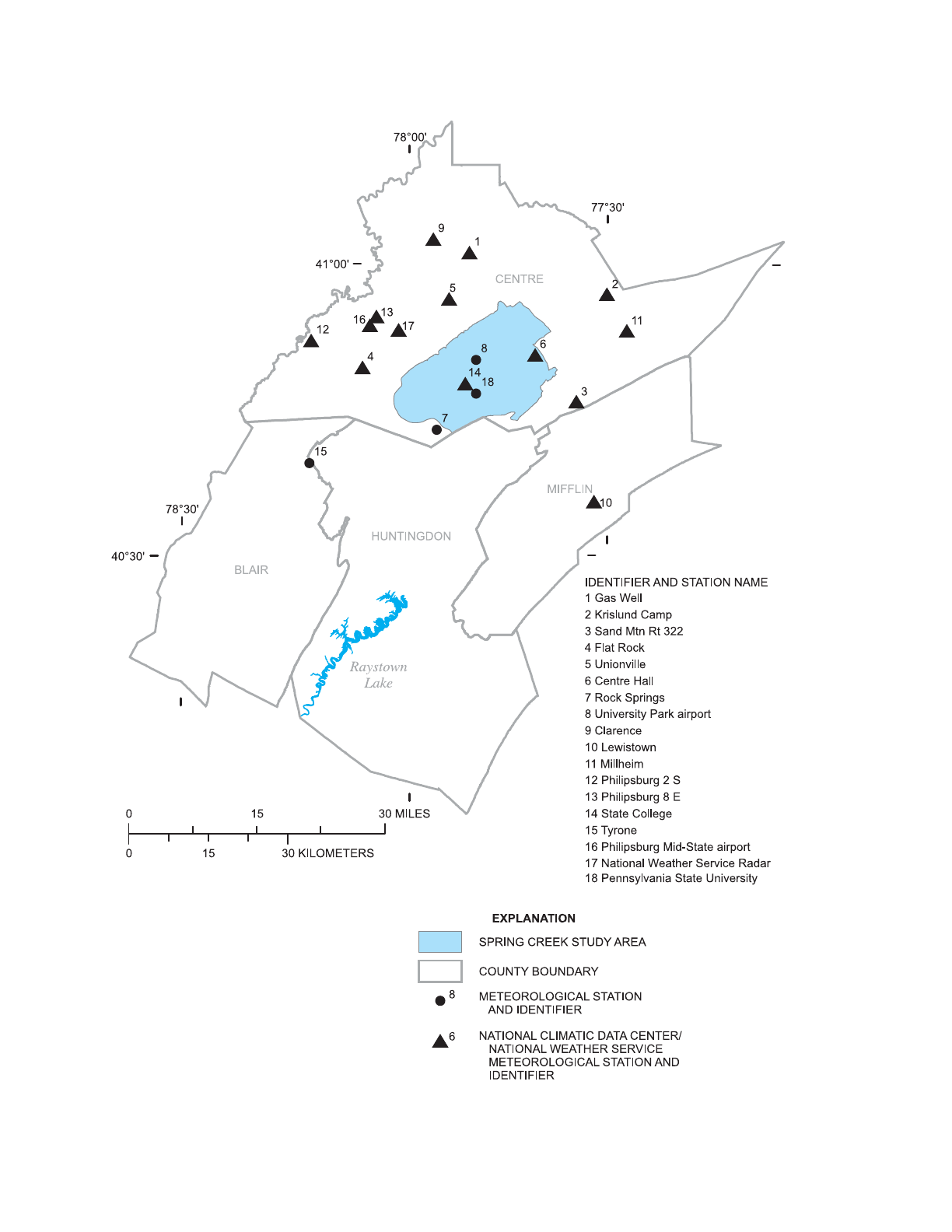
8 Hydrogeologic Setting and Conceptual Hydrologic Model of the Spring Creek Basin, Centre County, Pennsylvania
Figure 2. Location of meteorological data-collection stations in and within 15 miles of the Spring Creek Basin, Centre
County, Pennsylvania.

Physical Characteristics of Spring Creek Basin 9
Table 3. Meteorological data-collection stations in and within 15 miles of the Spring Creek Basin, Centre County, Pennsylvania.
[NAD 83, North American Datum of 1983; NAVD 88, North American Vertical Datum of 1988; na, not applicable; Y, yes; N, no; --, no data]
Station name
Latitude
(degrees,
minutes,
seconds,
NAD 83)
Longitude
(degrees,
minutes,
seconds,
NAD 83)
Elevation
(feet above
NAVD 88)
Period of record
Obser-
vation
interval
Obser-
vation
time
Rain-
fall
Snow
Air
temper-
ature
Humid-
ity
Sky
cover
Wind
speed
Wind
direc-
tion
Data source
Gas Well 410132 775131 2,050 1/1/2000 to present Hourly na YNNNNNNIFLOWS
1
Krislund Camp 405708 773246 1,270 1/1/2000 to present Hourly na YNNNNNNIFLOWS
Sand Mtn Rt 322 404604 773700 1,780 1/1/2000 to present Hourly na YNNNNNNIFLOWS
Flat Rock 404940 780600 1,600 1/1/2000 to present Hourly na YNNNNNNIFLOWS
Unionville 405644 775417 1,500 1/1/2000 to present Hourly na YNNNNNNIFLOWS
Centre Hall 405058 774236 2,150 1/1/2000 to present Hourly na YNNNNNNIFLOWS
Rock Springs 404319.2 775555.2 1,210 9/10/1999 to present Hourly na YNYYYYYPSU
2
University Park
airport
405031.2 775034.8 1,239.8 1/1/2003 to present Daily na YYYYYYYPACLIM
3
Clarence 410300 775700 1,389.7 8/1/1950 to present Daily 0700 YYNNNNNNCDC
4
Lewistown 403500 773400 459.9 5/1/1948 to present Daily 0800 YYYNNNNNCDC
Millheim 405300 772800 1,119.8 6/1/1949 to present Daily 0700 YYNNNNNNCDC
Philipsburg 2 S 405200 781300 1,719.7 4/1/1998 to present Daily Unknown YYYNNNNNCDC
Philipsburg 8 E 405500 780400 1,944.4 10/1/1986 to 1/31/1997 Daily Unknown YYYNNNNNCDC
State College 404800 775200 1,169.6 1/1/1926 to present Daily 0700 YYYNNNNNCDC
Tyrone 404000 781300 889.9 9/1/1972 to present Daily 0700 YYNNNNNPACLIM
Philipsburg Mid-
State airport
405400 780500 1,941.4 1/1948 to 8/1996 Daily Unknown YYYNNNNNCDC
National Weather
Service radar
405500 780000 2,404.2 4/6/1995 to present Hourly na YNNNNNNNHDS
5
Pennsylvania State
University
404735 755202 -- 1/1/1896 to present Daily 0700 YYYNNNN PSU
1
National Weather Service, 2005.
2
Pennsylvania State University, 2005.
3
Pennsylvania State Climatologist, 2005.
4
U.S. Department of Commerce, 2005.
5
National Oceanic and Atmospheric Administration, 2005.
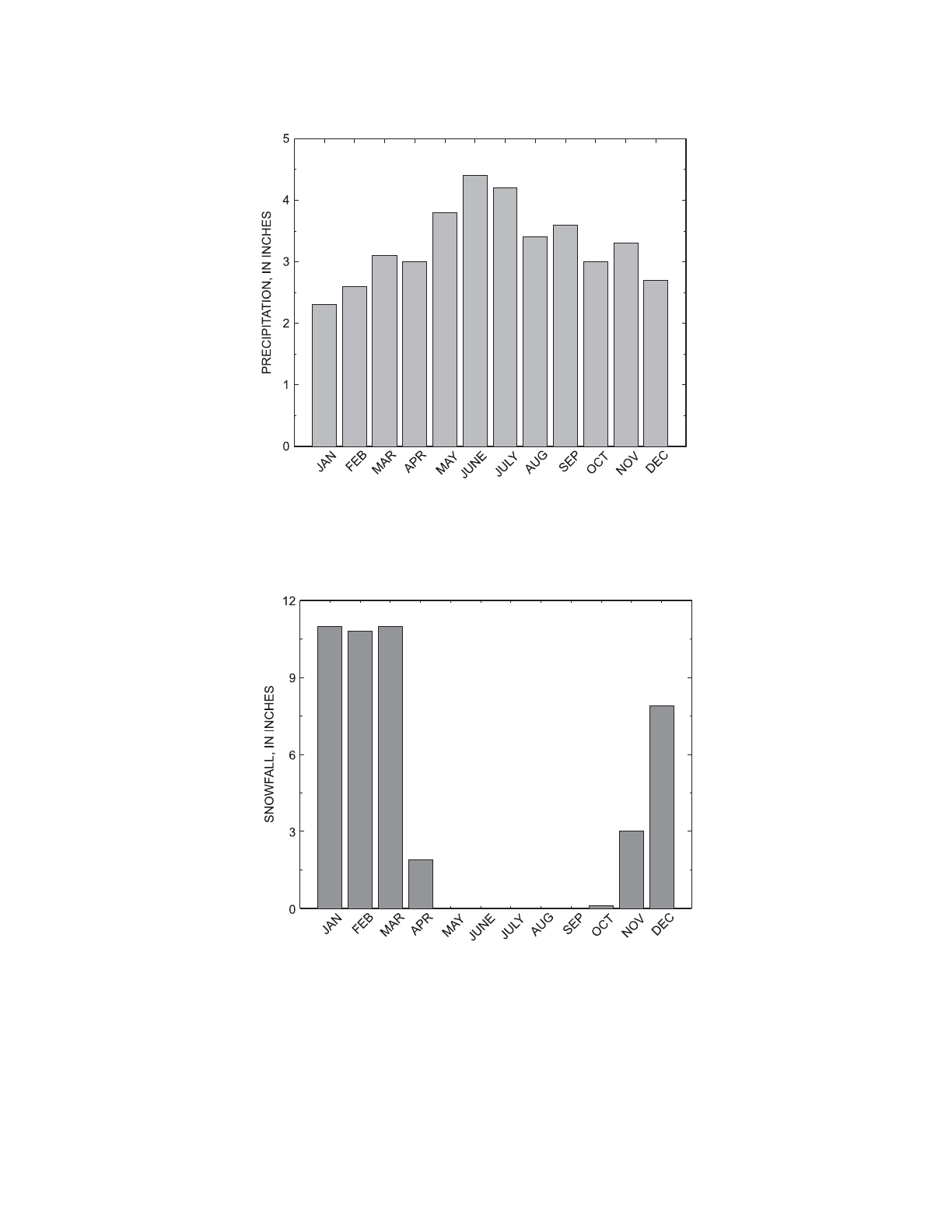
10 Hydrogeologic Setting and Conceptual Hydrologic Model of the Spring Creek Basin, Centre County, Pennsylvania
Figure 3. Average monthly precipitation for Centre County, Pennsylva-
nia (1961 through 1990) (National Oceanic and Atmospheric Administra-
tion, 2003).
Figure 4. Average monthly snowfall at State College, Pennsylvania (1926
through 1994) (Pennsylvania State Climatologist, 2005).

Physical Characteristics of Spring Creek Basin 11
Figure 5. Example of a 4-kilometer square cell grid of radar-derived precipitation data for the Spring Creek Basin, Centre County,
Pennsylvania.

12 Hydrogeologic Setting and Conceptual Hydrologic Model of the Spring Creek Basin, Centre County, Pennsylvania
Air Temperature
Air-temperature records are available for eight locations
(fig. 2 and table 3). Seven of those locations record daily mini-
mum and maximum temperatures, and one location records
hourly temperature. The average annual air temperature in State
College is 49.4°F. The highest monthly mean temperature is
71.7°F in July, and the lowest monthly mean temperature is
26.5°F in January (Pennsylvania State Climatologist, 2003).
The average daily minimum and maximum temperatures for the
period of record at State College are shown in figure 6.
Humidity
Humidity is a measure of water vapor in the air, and water
vapor is a significant source of latent heat. In the eastern United
States, humidity levels can be high enough to be a substantial
source of heat and, thus, warrant inclusion in a modeled snow-
melt process (George Leavesley, U.S. Geological Survey, writ-
ten commun., 2003). Hourly humidity data are available for one
location and daily humidity data are available for one location
within the Spring Creek Basin (table 3). The average annual rel-
ative humidity for Centre County is about 70 percent.
Solar Radiation
Modeling evapotranspiration (ET) and snowmelt gener-
ally requires estimates of energy inputs. In many instances,
solar radiation is the desired energy form. However, the avail-
ability of measured solar-radiation data is limited to observa-
tions collected at airports in the vicinity of the basin.
Hourly solar-radiation data from the airport near William-
sport, Pa., about 60 mi northeast of State College, are available
for the period January 1961 through December 31, 1990 (Penn-
sylvania State Climatologist, 2003). Solar-radiation data also
were collected at the Pennsylvania State University from 1952
to about 1985 and are archived as paper copies (Pennsylvania
State Climate Office, written commun., 2003). A new solar-
radiation measurement site was established in 1998 at the Penn-
sylvania State University Rock Springs agricultural research
farm as part of the National Oceanic and Atmospheric Admin-
istration (NOAA) SURFRAD Network (National Oceanic and
Atmospheric Administration, 2003). Solar-radiation data for
Rock Springs are available in 3-minute intervals for the period
beginning June 24, 1998.
Evaporation
In hydrologic modeling, ET is a major component of the
hydrologic budget. ET typically is either computed from other
meteorological inputs or estimated from measured evaporation
data. Pan evaporation is the most commonly collected type of
evaporation data.
Average growing season (May through October) pan evap-
oration at Raystown Lake, Huntingdon County, 30 mi south-
southwest of State College, Pa., is 30.8 in. (Pennsylvania State
Climatologist, 2003). Total annual pan-evaporation values are
somewhat greater than this value, although November through
April values generally are reduced compared to values mea-
sured during the growing season. Average daily pan-evapora-
tion data collected at Raystown Lake (fig. 2) for the May
through October growing season are listed in table 4. The
period of record for this data is from 1974 to 1984.
Computed daily evaporation data beginning May 2000 are
available from the Rock Springs meteorological station (Penn-
sylvania State Climatologist, 2003). Rock Springs is in Fergu-
son Township, about 2 mi southwest of the Spring Creek Basin.
Free water surface (FWS) evaporation is considered a bet-
ter estimate of potential ET than pan evaporation. FWS evapo-
ration typically is estimated by application of a pan coefficient
to pan-evaporation data. Farnsworth and others (1982) assigned
a pan coefficient of 0.76 to the area near Spring Creek Basin.
This coefficient is an average annual value. Monthly pan coef-
ficients would be preferred for modeling purposes.
Figure 6. Average minimum and maximum daily air temperature
at State College, Pennsylvania (Pennsylvania State Climatologist,
2005).

Physical Characteristics of Spring Creek Basin 13
Physiography
Spring Creek Basin is in the Ridge and Valley Physio-
graphic Province of the Appalachian Mountains and is juxta-
posed to the southern boundary of the Appalachian Plateaus
Physiographic Province. Bald Eagle Mountain and Tussey
Mountain form the northern and southern basin boundaries of
the Nittany Valley (fig. 7). Nittany Mountain bisects the eastern
half of Nittany Valley, which then becomes Penns Valley to the
south (Giddings, 1974).
Topography
Bald Eagle, Tussey, and Nittany Mountain ridges are the
most prominent topographic features in the basin (fig. 7). Relief
between the ridge crests and valley floor ranges from 600 to
1,000 ft. The Gatesburg Ridge adds 200 ft of relief to the Nitt-
any Valley floor. Stream channels have cut as deep as 300 ft
into the valley floor (Giddings, 1974). Topographic statistics
are summarized by subbasin in table 5. Mean subbasin slope
was calculated as the average of the set of grid cell slopes taken
from a 30-m digital elevation model. Mean aspect is the average
downslope direction calculated from the set of steepest downs-
lope directions for each grid cell in a 30-m digital elevation
model. The mean channel slope is the slope that is measured
between the 10-percent and 85-percent length of the channel.
Nittany and Penns Valley are characterized by karst topog-
raphy. The valley floors contain numerous features such as sur-
face depressions and sinkholes. These features and others such
as swallets or swallow holes capture surface-water runoff.
Swallets are openings to the subsurface conduit system.
They may occur in sinkholes or stream channels and provide
direct points of recharge to the underlying carbonate aquifers.
As a result, recharge to the unsaturated zone in the valley floor
could be bypassed. It is anticipated that recharge from swallets
is not perched but moves rapidly through mature karst terrain to
prescribed discharge points. The degree of hydraulic connec-
tion between the swallets and valley-floor aquifers is minimal.
David Yoxtheimer (Water Resources Monitoring Project,
Spring Creek Watershed Community Project, written commun.,
2003) provided a summary of features for the Julian, Pine
Grove, and State College quadrangles compiled by Kochanov
(1992). The GIS database (Appendix 1) includes coordinates
for four karst features—surface depressions, sinkholes, caves,
and surface mines. The complete data set is contained in Appen-
dix 1. A subset of the data is presented in table 6. The Julian,
Pine Grove, and State College quadrangles contain 4,906,
2,768, and 3,660 features, respectively.
Table 4. Average daily pan evaporation for the growing season,
in inches, at Raystown Lake, Huntingdon County, Pennsylvania.
[The period of record is from 1974 to 1984. --, no data]
Day May June July Aug. Sept. Oct.
1 -- 0.22 0.23 0.17 0.15 0.15
2 0.19 .22 .18 .20 .13 .09
3 .24 .18 .21 .21 .15 .09
4 .18 .16 .23 .19 .18 .13
5 .21 .19 .17 .16 .16 .11
6 .23 .25 .18 .17 .15 .11
7 .16 .13 .21 .18 .18 .11
8 .19 .24 .25 .19 .15 .10
9 .26 .14 .16 .19 .18 .08
10 .17 .25 .19 .20 .15 .09
11 .21 .19 .18 .19 .19 .07
12 .17 .20 .21 .19 .18 .08
13 .19 .25 .20 .14 .15 .10
14 .18 .20 .19 .16 .13 .13
15 .19 .22 .23 .20 .17 .10
16 .16 .22 .20 .15 .10 .13
17 .17 .21 .19 .22 .15 .08
18 .12 .25 .19 .18 .14 .07
19 .20 .19 .26 .20 .12 .07
20 .16 .20 .20 .20 .18 .11
21 .20 .17 .20 .21 .12 .06
22 .18 .21 .22 .17 .11 .11
23 .24 .22 .20 .19 .11 .11
24 .23 .21 .19 .16 .14 .09
25 .18 .18 .23 .21 .11 .05
26 .15 .17 .19 .20 .12 .10
27 .19 .23 .20 .20 .16 .07
28 .19 .23 .21 .17 .11 .07
29 .18 .15 .16 .20 .10 .08
30 .14 .17 .17 .17 .11 .10
31 .15 .21 .16 .10
Total 5.61 6.05 6.24 5.73 4.28 2.94

14 Hydrogeologic Setting and Conceptual Hydrologic Model of the Spring Creek Basin, Centre County, Pennsylvania
Table 5. Elevation, slope, and aspect, by subbasin, of the Spring Creek surface-water basin, Centre County, Pennsylvania.
[na, not applicable]
Subbasin
Drainage
area (square
miles)
Mean
elevation
(feet)
Mean
subbasin
slope
(percent)
Maximum
subbasin
slope
(percent)
Main
channel
length
(miles)
Mean
channel
slope
(percent)
Mean
aspect
(azimuth
degrees)
Big Hollow 17.1 1,201 2.3 12.6 7.2 0.7 166
Buffalo Run 27.3 1,245 6.0 35.5 13 .8 182
Cedar Run 17.5 1,321 3.8 28.2 3.2 .5 185
Galbraith Gap Run 5.13 1,767 9.3 27.4 4 3.1 199
Logan Branch 22.5 1,308 5.9 33.8 9.2 2.1 218
Roaring Run 4.72 1,580 8.2 29.7 4.2 3.3 242
Slab Cabin Run 16.8 1,240 3.8 26.2 9.9 1.5 199
Spring Creek - main channel 34.9 1,120 4.9 30.8 24.5 .4 202
Spring Creek - total surface-
water basin
146 1,262 5.0 35.5 75.2 na 195
Figure 7. Topography of Spring Creek Basin, Centre County, Pennsylvania.

Physical Characteristics of Spring Creek Basin 15
Land Use
Land-use patterns are influenced heavily by the physiogra-
phy of the basin. Bald Eagle, Tussey, and Nittany Mountain
ridges are forested, and the basin valley floor is predominantly
agriculture and urban (fig. 8). The headwaters area and
extended ground-water basin in the southwest part of the basin
also are primarily forested with limited agriculture or urban
land use. A summary of land cover derived from the USGS/U.S.
Environmental Protection Agency Multi-Resolution Land
Characteristics 1992 (MRLC1992) (U.S. Geological Survey,
1992) GIS data set (fig. 8) is presented by subbasin in table 7.
The scale of MRLC1992 is 1:100,000.
Higher-resolution GIS data are being developed by the
Centre County Planning Commission. These data, mapped at a
scale of 1:24,000, are based on digital orthophotography com-
pleted for Centre County in 1995 and 2001. Land-cover classes
in this data set are not identical to those in the MRLC1992. This
new data set will feature improved overall accuracy and defini-
tion of land cover.
Land-cover classes can be used as a primary guide for
assigning specific hydrologic/hydraulic characteristics to the
spatial framework of a hydrologic model. Not included in the
listed land-cover classifications is an accounting of pervious
and impervious areas. Models that simulate runoff/infiltration
from rainfall input typically apply rainfall to delineated pervi-
ous and impervious areas, allowing no infiltration in the imper-
vious areas. However, this approach may not adequately simu-
late situations where runoff from impervious areas is directed to
pervious areas. In the Spring Creek Basin, runoff from impervi-
ous areas commonly infiltrates into the subsurface.
Table 6. Selected data for surface depressions, sinkholes, caves,
and surface mines reported for the Julian quadrangle, Spring
Creek Basin, Centre County, Pennsylvania.
[Feature number is an arbitrary number assigned to a given surface depression,
sinkhole, or surface mine in tblJulian in Appendix 2]
Feature
number
Coordinates, in decimal
degrees
Type
Latitude Longitude
4821 -77.96700 40.82557 surface depression
4822 -77.96750 40.82700 surface depression
4823 -77.99110 40.81429 surface depression
4890 -77.93790 40.82632 sinkhole
4896 -77.88280 40.84131 sinkhole
4897 -77.88400 40.84384 sinkhole
4898 -77.87960 40.77607 surface mine
4901 -77.91550 40.76786 surface mine
4902 -77.98110 40.79649 surface mine
4903 -77.94620 40.80212 surface mine
4904 -77.99530 40.80707 cave
4905 -77.96280 40.82701 cave
4906 -77.93200 40.84132 cave

16 Hydrogeologic Setting and Conceptual Hydrologic Model of the Spring Creek Basin, Centre County, Pennsylvania
Table 7. Summary of multiresolution land-cover classes, by subbasin, in Spring Creek surface-water basin, Centre County, Pennsylvania.
[na, not applicable]
Multiresolution
land-characteristic
class
Big
Hollow
Buffalo
Run
Cedar
Run
Galbraith Gap
Run
Logan
Branch
Roaring
Run
Slab Cabin
Run
Spring
Creek
Total all
subbasins
Square
miles
Per-
cent
1
Square
miles
Per-
cent
1
Square
miles
Per-
cent
1
Square
miles
Per-
cent
1
Square
miles
Per-
cent
1
Square
miles
Per-
cent
1
Square
miles
Per-
cent
1
Square
miles
Per-
cent
1
Square
miles
Per-
cent
1
Bare: quarries na na 0.019 0.1 na na na na 0.237 1.1 na na 0.004 0 0.07 0.2 0.329 0.2
Bare: transitional na na .014 .1 0.015 0.1 na na .169 .7 na na .009 .1 .012 0 .219 .2
Deciduous forest 4.677 27.4 11.488 42.2 3.213 18.4 3.282 64 9.028 40.1 2.708 57.4 3.5 20.8 9.348 26.8 47.412 32.5
Emergent herba-
ceous wetland
.006 0 .072 .3 .014 .1 .008 .1 .009 0 na na .028 .2 .029 .1 .165 .1
Evergreen forest .474 2.8 .735 2.7 .11 .6 .82 16 1.121 5 .433 9.2 .417 2.5 .762 2.2 4.877 3.3
Hay/pasture 1.37 8 1.541 5.7 2.163 12.4 .031 .6 1.032 4.6 .208 4.4 1.498 8.9 2.817 8.1 10.656 7.3
High-intensity com-
mercial/
industrial
.346 2 .042 .2 .006 0 .002 0 .384 1.7 .001 0 .328 1.9 .49 1.4 1.596 1.1
High-intensity resi-
dential
.188 1.1 .023 .1 .001 0 na na .029 .1 na na .381 2.3 .222 .6 .844 .6
Low-intensity
developed
1.704 10 .238 .9 .043 .2 na na .747 3.3 .021 .4 2.238 13.3 2.352 6.7 7.33 5
Mixed forest 1.028 6 1.269 4.7 .377 2.2 .803 15.7 1.034 4.6 .476 10.1 .892 5.3 1.369 3.9 7.266 5
Other grass .321 1.9 na na .021 .1 na na na na na na .223 1.3 .161 .5 .728 .5
Row crops 6.935 40.6 11.714 43 11.457 65.6 .139 2.7 8.645 38.4 .871 18.5 7.324 43.5 16.934 48.5 64.011 43.9
Water .018 .1 .025 .1 .016 .1 .017 .3 .095 .4 .001 0 .006 0 .297 .8 .473 .3
Woody wetland .004 0 .023 .1 .001 0 .001 0 na na na na 0 0 .013 0 .044 0
1
Total percent of land-cover classes for an individual subbasin may not equal 100 percent because of rounding.
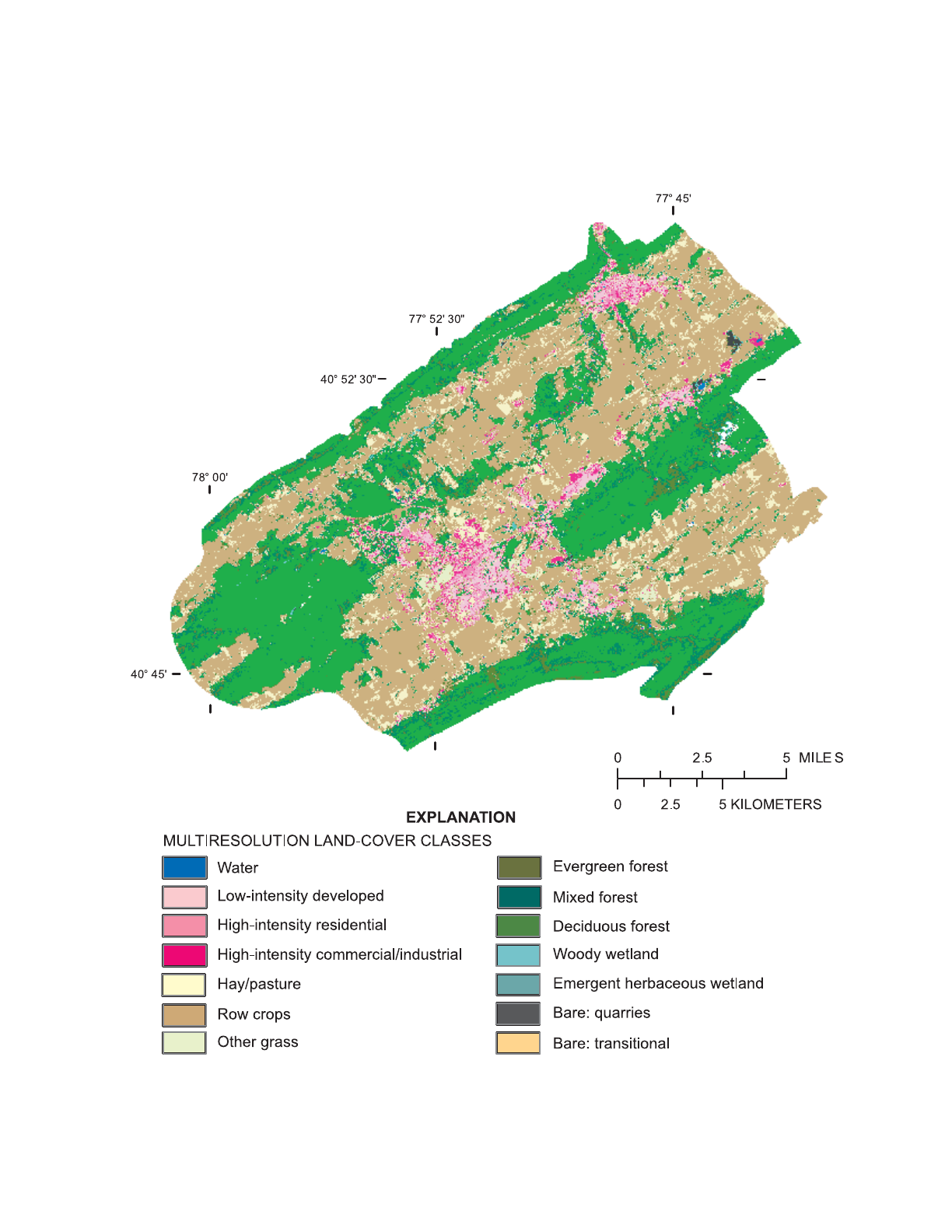
Physical Characteristics of Spring Creek Basin 17
Figure 8. Land use in the Spring Creek Basin, Centre County, Pennsylvania (U.S. Geological Survey, 1992).

18 Hydrogeologic Setting and Conceptual Hydrologic Model of the Spring Creek Basin, Centre County, Pennsylvania
Hydrogeologic Setting of Spring Creek Basin
Soils
Soils in Spring Creek Basin can be classified into two
generic groups on the basis of their origin. Residual soils are
those that have been formed in place, and transported soils are
those deposited some distance from their point of origin
(Parizek, 1984). Within these two broad classifications, numer-
ous subdivisions known as soil types or series exist (Braker,
1981). The occurrence and range of individual soil series in the
Spring Creek Basin are exceedingly complex. However, by
grouping soils of similar origin and characteristics, a general-
ized map of soils can be produced (fig. 9) (Braker, 1981). These
groups, called associations, tend to have uniformity in their pat-
tern of distribution but may exhibit considerable variation in
their characteristics (Braker, 1981).
The Berks-Weikert association consists of soils formed in
residual material weathered from shale of the Ridge and Valley
Physiographic Province. The Hagerstown-Opequon-Hubler-
burg, Morrison, Opequon-Hagerstown, and Murrill associa-
tions consist of soils formed in residual and colluvial materials
weathered primarily from limestone. The Hazleton-Laidig-
Andover and Ungers associations consist of soils formed in
residual and colluvial material weathered from sandstone. The
extents of the associations are listed by subbasin in table 8.
Together the Hagerstown-Opequon-Hublerburg and Hazleton-
Laidig-Andover associations cover 78 percent of the Spring
Creek Basin. Soils in the ground-water drainage basin, which
extends outside the surface-water basin, are listed in table 9.
In hydrologic modeling, soil properties and conditions
affect infiltration rates and soil-moisture storage capacity. A
listing of selected hydrologic properties and particle-size distri-
butions of the soil associations in the Spring Creek Basin is
shown in table 10. These characteristics are summarized from
the Conterminous United States (CONUS-soil) (Miller and
White, 1998) data set. The CONUS-soil data comprise a GIS
data set that contains data from the Natural Resources Conser-
vation Service State Soil Geographic (STATSGO) database
(U.S. Department of Agriculture, Natural Resources Conserva-
tion Service, 1994) structured for use in hydrologic and climate
models.
The STATSGO database was released in 1992 for use in
river basin, multi-county, and state resource planning.
STATSGO consists of georeferenced digital maps and attribute
data. Maps were compiled using USGS 1:250,000 topographic
quadrangles. The CONUS-soil data is a multi-layer soil-charac-
teristics database that provides soil physical and hydraulic prop-
erties for soil layers extending 2.5 meters below the surface and
includes soil-texture class and particle-size fractions, bulk den-
sity, porosity, depth to bedrock, rock-fragment volume, rock-
fragment class, available water capacity, permeability, plastic-
ity, pH, K-factor (erosion), hydrologic soil group, and curve
number (Experimental Climate Prediction Center, 2005). Soil
temperature and moisture data collected at the Pennsylvania
State University Rock Springs Agricultural Research Farm by
the Natural Resources Conservation Service are available start-
ing November 1999 (Natural Resources Conservation Service,
2003).
Geology
The geology of Spring Creek Basin has been described in
numerous studies. Key studies related to the geology and hydro-
geology of carbonate rocks include those by Butts and Moore
(1936), Caruccio (1963), Landon (1963), Clark (1965),
Flueckinger (1967), Konikow (1969), and Meiser (1971).
Detailed stratigraphic and petrologic information is available in
studies by Tuttle (1939), Pelto (1942), Folk (1952), Rones
(1955), Donaldson (1959), Thomson (1961), Smith (1966),
Parizek and others (1971), and Rauch (1972).
The Spring Creek Basin is underlain by 6,000 to 8,000 ft
of interbedded limestone, dolomite, and sandstone of Cam-
brian, Ordovician, Silurian, and Devonian age (table 11). The
strata are folded into anticlines and synclines, and numerous
normal, thrust, and strike-slip faults have offset the rocks in sev-
eral places. The Birmingham Thrust Fault is the major fault
extending through much of Nittany Valley. The geologic units
and location of major faults as mapped by Berg and others
(1980) are shown in figure 10.
Geologic sections across the Spring Creek Basin show
lithologic control on the topography of the basin. The resistant
quartzite of the Tuscarora Formation and the sandstone of the
Bald Eagle Formation form the double ridges of Bald Eagle
Mountain and the less-resistant Juniata Formation underlies the
small valleys between the double ridges (figs. 11 and 12). The
Nittany and Penns Valleys formed on less resistant carbonate
rocks of Cambrian and Ordovician age. The sections (figs. 11
and 12) show that the valleys formed on anticlines and the
mountains on synclinal structures.
The rocks in the Spring Creek Basin have been fractured
by many forces, principally those that formed the Appalachian
Mountains. Fractures include cleavage, bedding-plane partings,
joints, and faults. Some major fractures are expressed topo-
graphically and are referred to as fracture traces or lineaments.
Fracture traces are natural linear features consisting of topo-
graphic, vegetation, or soil-tonal alignments that are visible pri-
marily on aerial photographs, are greater than 1,000 ft in length,
and are less than 1 mi in length. Maps of fracture traces in the
State College area by Lattman and Parizek (1964) and Parizek
and Drew (1966) suggest that fracture traces are abundant and
tend to have north-south and east-west strikes, giving rise to
large, irregular, rectangular blocks. Areas of high-density frac-
ture traces are shown in figure 13. The location of the traces is
important because wells drilled on fracture traces in Spring
Creek Basin generally have higher yields than those drilled off
fracture traces (Lattman and Parizek, 1964; Parizek and Drew,
1966; Siddiqui, 1969).
Many fractures in the carbonate rocks beneath the valleys
of Spring Creek Basin have been enlarged by dissolution. These
enlarged fractures (vugs, solution cavities, sinkholes, and con-
duits) have a significant influence on the rate and direction of
ground-water flow.

Hydrogeologic Setting of Spring Creek Basin 19
Figure 9. Soil associations in the Spring Creek Basin, Centre County, Pennsylvania (Braker, 1981). (Note: Soil associa-
tions have been extended to the ground-water divide.)

20 Hydrogeologic Setting and Conceptual Hydrologic Model of the Spring Creek Basin, Centre County, Pennsylvania
Table 8. Inventory and extent of soil associations, by subbasin, in Spring Creek surface-water basin, Centre County, Pennsylvania (from Braker, 1981).
[—, no data]
Subbasin
Berks-Weikert
Hagerstown-
Opequon-
Hublersburg
Morrison
Opequon-
Hagerstown
Murrill
Hazleton-Laidig-
Andover
Ungers
Square
miles
Percent of
subbasin
Square
miles
Percent of
subbasin
Square
miles
Percent of
subbasin
Square
miles
Percent of
subbasin
Square
miles
Percent of
subbasin
Square
miles
Percent of
subbasin
Square
miles
Percent of
subbasin
Big Hollow — — 13.8 81 3.28 19 — — — — — — — —
Buffalo Run — — 17.9 66 6.04 22 — — — — 3.27 12 — —
Cedar Run 0.67 4 10.5 60 — — 4.66 26 1.33 8 .32 2 — —
Galbraith Gap Run .61 12 — — — — .02 0 — — 3.21 63 1.29 25
Logan Branch — — 5.6 25 — — — — 3.56 16 11.4 50 2.03 9
Roaring Run — — .47 10 — — — — — — 3.96 84 .29 6
Slab Cabin Run — — 11.7 69 — — — — .3 2 4.88 29 — —
Spring Creek (main
channel)
1.49 4 20.4 59 2.01 6 .74 2 3.04 9 6.81 20 .13 1
Total all subbasins 2.77 2 80.4 55 11.3 8 5.42 4 8.23 6 33.8 23 3.74 2
Table 9. Inventory and extent of soil associations in the ground-water drainage basin for Spring Creek, Centre County, Pennsylvania (from Braker, 1981).
[—, no data]
Berks-Weikert
Hagerstown-
Opequon-
Hublersburg
Morrison
Opequon-
Hagerstown
Murrill
Hazleton-Laidig-
Andover
Ungers
Square
miles
Percent
of
ground-
water
basin
Square
miles
Percent
of
ground-
water
basin
Square
miles
Percent
of
ground-
water
basin
Square
miles
Percent
of
ground-
water
basin
Square
miles
Percent
of
ground-
water
basin
Square
miles
Percent
of
ground-
water
basin
Square
miles
Percent
of
ground-
water
basin
Ground-water basin out-
side of surface-water
basin
0.22 1 12.5 39 17.1 53 — — 0.63 2 1.48 5 — —
Total ground-water basin 2.99 2 92.9 52 28.4 16 5.42 3 8.86 5 35.3 20 3.74 2

Hydrogeologic Setting of Spring Creek Basin 21
Table 10. Selected physical properties of soil associations in Spring Creek Basin, Centre County, Pennsylvania (from Miller and White, 1998).
[—, no data]
Association
Proportion
(percent)
1
1
Proportion of soil type listed in same order as named in association except last value which refers to other unnamed soil types in that association. For example, the proportions 51-13-36 for the Berks-Weikert
soil association suggests that the Berks soil is equivalent to 51 percent, the Weikert soil is equivalent to 13 percent, and unnamed soils are equivalent to 36 percent.
Available water
capacity
(inch per inch)
Permeability
(inches
per hour)
Porosity
Sand fraction
(percent)
Silt fraction
(percent)
Clay fraction
(percent)
Mini-
mum
Maxi-
mum
Mini-
mum
Maxi-
mum
Mini-
mum
Maxi-
mum
Mini-
mum
Maxi-
mum
Median
Mini-
mum
Maxi-
mum
Median
Mini-
mum
Maxi-
mum
Median
Berks-Weikert 51-13-36 0.04 0.14 0.4 3.6 0.13 0.5 27 34 32 47 58 51 15 19 17
Hazleton-Laidig-
Andover
28-23-16-33 .04 .2 4.8 8.5 .33 .5 46 53 49 34 38 34 13 20 15
Hagerstown-
Opequon-
Hublersburg
53-12-12-23 .1 .2 1.2 2.2 .45 .52 16 20 18 38 70 40 13 44 42
Morrison 80-20 .06 .16 3.7 5.0 .46 .51 51 55 54 33 35 34 12 14 13
Murrill 82-18 .08 .14 .6 2.0 — — — — — — — — — — —
Opequon-
Hagerstown
35-23-42 .1 .2 .6 2.0 — — — — — — — — — — —
Ungers 73-27 .06 .16 .6 6.0 — — — — — — — — — — —
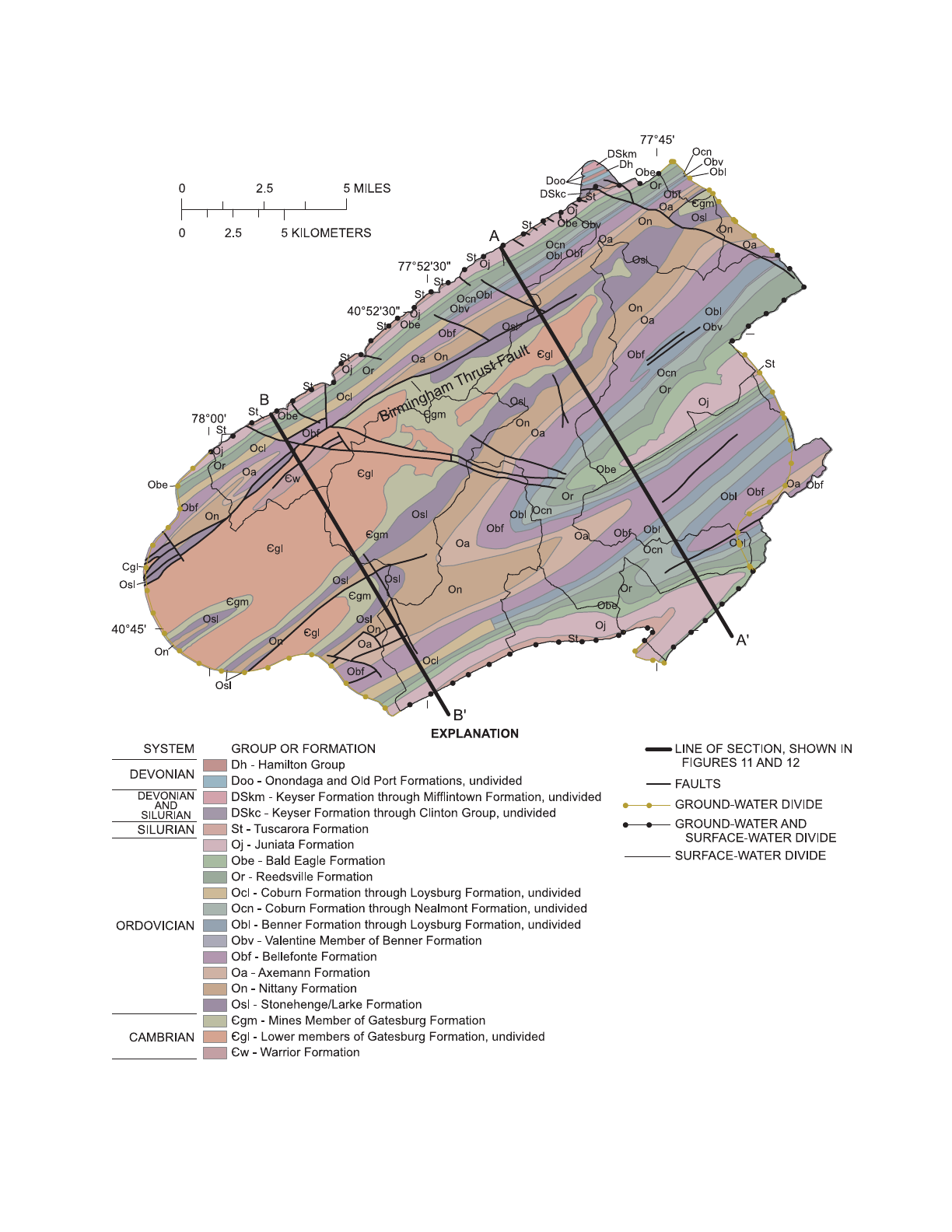
22 Hydrogeologic Setting and Conceptual Hydrologic Model of the Spring Creek Basin, Centre County, Pennsylvania
Figure 10. Geologic map of Spring Creek Basin, Centre County, Pennsylvania (modified from Berg and others, 1980).

Hydrogeologic Setting of Spring Creek Basin 23
Table 11. Stratigraphy and aquifer types for the Spring Creek Basin (modified from Siddiqui, 1969).
System Geologic unit
Thickness
(feet)
Lithologic description Aquifer type
Devonian Hamilton Group: Fracture-dominated siliciclastic
Mahantango Formation 610 Olive-green shale; thin fine-grained sandstone; 0 to 50 feet of gray
limestone and shale at top (Tully Member)
Fracture-dominated siliciclastic
Marcellus Formation 100 Black-fissile shale
Fracture-dominated siliciclastic
Onondaga Formation 0-50 Greenish-blue shale and dark-blue to black, medium-bedded limestone
Fracture-dominated siliciclastic
Old Port Formation: 225-280
Fracture-dominated siliciclastic
Ridgeley Member Coarse-grained, calcareous, brown to white, fossiliferous sandstone
Fracture-dominated siliciclastic
Shriver Member Thin-bedded siliceous limestone, shale, calcareous sandstone, and chert
Fracture-dominated siliciclastic
Corriganville Member Medium-gray limestone and light-gray chert
Fracture-dominated siliciclastic
New Creek Member Coarsely crystalline, medium-dark-gray, massive-bedded limestone
Fracture-dominated siliciclastic
Devonian
and Sil-
urian
Keyser Formation 150 Dark-gray, thick-bedded, crystalline to nodular limestone, thin-bedded
and shaly near the top
Fracture-dominated siliciclastic
Tonoloway Formation 400 Dark, thin-bedded limestone
Fracture-dominated siliciclastic
Wills Creek Formation 400 Olive-gray and yellow, calcareous shale
Fracture-dominated siliciclastic
Bloomsburg Formation 40-400 Red and gray shale
Fracture-dominated siliciclastic
Mifflintown Formation 400 Olive-gray and yellowish-brown shale, interbedded with medium-gray
top dark-gray limestone; interbedded sandstone and limestone at base
Fracture-dominated siliciclastic
Clinton Group Fossiliferous sandstone and hematitic, oolitic sandstone and shale
Fracture-dominated siliciclastic
Silurian Rose Hill Formation 800 Olive-gray shales weathering pale yellowish brown; interbedded thin
sandstone and limestone
Fracture-dominated siliciclastic
Tuscarora Formation 550 Hard, thick-bedded, white or gray quartzitic sandstone
Fracture-dominated siliciclastic

24 Hydrogeologic Setting and Conceptual Hydrologic Model of the Spring Creek Basin, Centre County, Pennsylvania
Ordovician Juniata Formation 500-1,000 Dominately red, fine-grained sandstone, siltstone, and shale Fracture-dominated siliciclastic (except
Oswego Sandstone of the Bald Eagle For-
mation, which has intergranular perme-
ability)
Bald Eagle Formation 700-800 Brown to gray, fine- to coarse-grained sandstone
Reedsville Formation
1
900-1,400 Dark-gray to brownish-gray shale; somewhat calcareous near the base;
sandy near the top
Fracture-dominated siliciclastic
Coburn Formation 300 Thin-bedded limestone containing shale interbeds Conduit-dominated carbonate
Salona Formation 180-300 Thin-bedded limestone containing shale partings Conduit-dominated carbonate
Nealmont Formation 70 Thin to thick impure limestone Conduit-dominated carbonate
Benner Formation: 150 Dark-gray laminated, thick- to thin-bedded limestone Conduit-dominated carbonate
Valentine Member
1
Dark-gray laminated, thick- to thin-bedded limestone Conduit-dominated carbonate
Snyder Formation 80 Medium-bedded limestone and dolomite Conduit-dominated carbonate
Hatter Formation 75 Medium-bedded limestone and laminated, argillaceous and arenaceous
dolomite
Conduit-dominated carbonate
Loysburg Formation 50-450 Laminated, medium- to thin-bedded limestone and dolomite Conduit-dominated carbonate
Bellefonte Formation 1,400 Light-gray, thick-bedded dolomite; some chert; sandstone bed in upper
part
Fracture-dominated carbonate
Axemann Formation
1
400-700 Blue, thin-bedded limestone; some dolomite layers Conduit-dominated carbonate
Nittany Formation
1
1,200 Blue, thick-bedded, coarsely crystalline dolomite Fracture-dominated carbonate
Stonehenge Formation 250-600 Blue, thin-bedded limestone; some dolomite Conduit-dominated carbonate
Cambrian Gatesburg Formation: 1,800 Conduit-dominated carbonate
Mines Member
1
Dark-gray, coarse-grained dolomite and subordinate light-gray fine-
grained dolomite; abundant oolitic chert
Fracture-dominated carbonate
upper sandy member
1
Dolomite and interbedded orthoquartzite and sandy dolomite Diffuse-flow-dominated carbonate aquifer
Ore Hill Member
1
Dark-gray dolomite Diffuse-flow-dominated carbonate aquifer
lower sandy member Dolomite and interbedded orthoquartzite and sandy dolomite Diffuse-flow-dominated carbonate aquifer
Warrior Formation 1,300 Blue, impure limestone and dolomite; thin sandy partings Fracture-dominated carbonate
1
Indicates geologic name not currently used by the U.S. Geological Survey. Conforms to usage by the Pennsylvania Geological Survey.
Table 11. Stratigraphy and aquifer types for the Spring Creek Basin (modified from Siddiqui, 1969).—Continued
System Geologic unit
Thickness
(feet)
Lithologic description Aquifer type
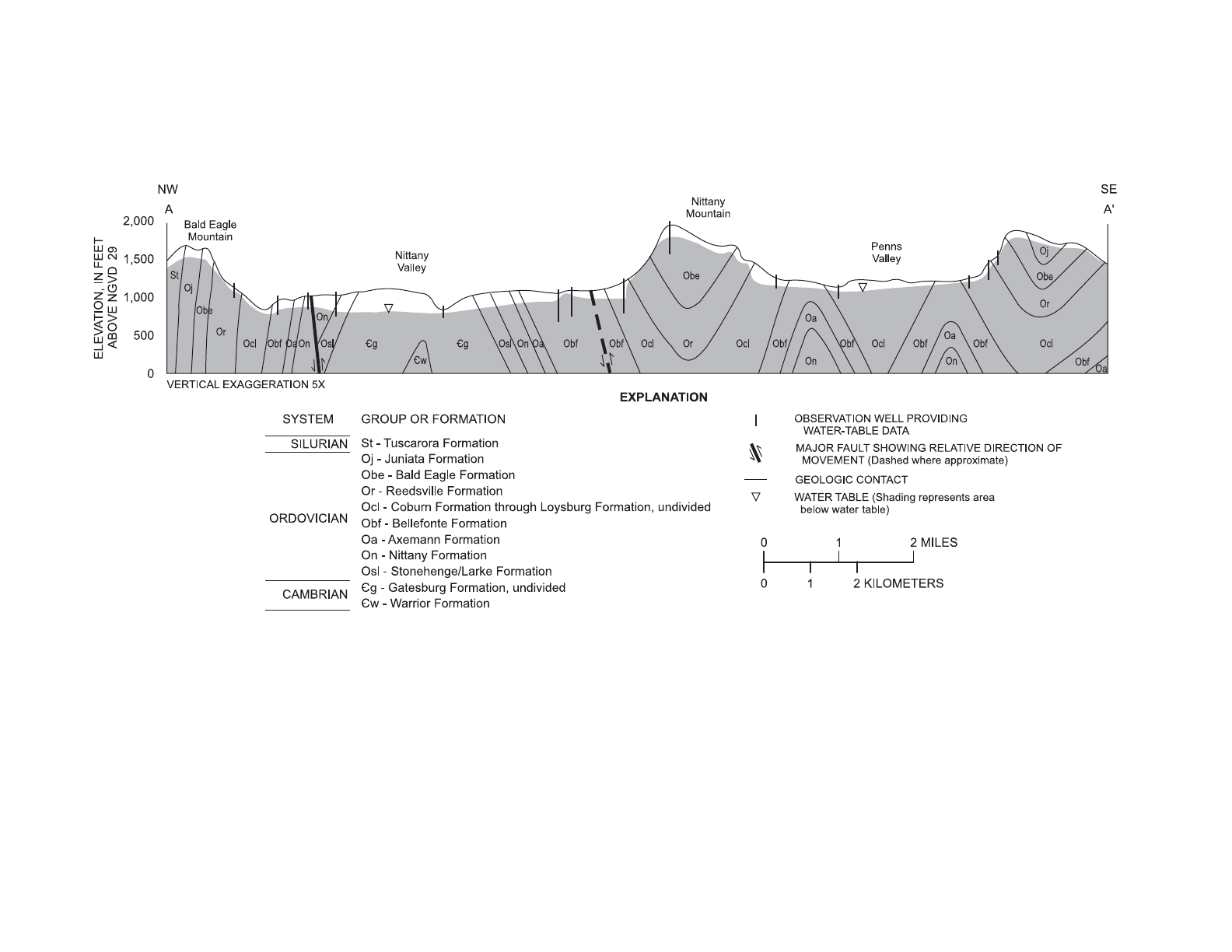
Hydrogeologic Setting of Spring Creek Basin 25
Figure 11. Geologic section and generalized water table through line A-A’, Spring Creek Basin and adjacent area (modified from Giddings, 1974; geology by Butts and Moore,
1936). Approximate location of section A-A’ is shown on figure 10. Some contacts differ between figures 10 and 11 because different geologic mapping sources were used.

26 Hydrogeologic Setting and Conceptual Hydrologic Model of the Spring Creek Basin, Centre County, Pennsylvania
Figure 12. Geologic section and generalized water table through line B-B’, Spring Creek Basin and adjacent area (modified from Giddings, 1974; geology by Butts
and Moore, 1936). Approximate location of section B-B’ is shown on figure 10. Some contacts differ between figures 10 and 12 because different geologic mapping
sources were used.

Hydrogeologic Setting of Spring Creek Basin 27
Figure 13. Areas of high-density fracture traces in the Spring Creek Basin, Centre County, Pennsylvania (from Nittany
Geoscience, Inc., 1989).

28 Hydrogeologic Setting and Conceptual Hydrologic Model of the Spring Creek Basin, Centre County, Pennsylvania
Surface Water
The Spring Creek surface-water basin drains 146 mi
2
via
Spring Creek and seven major named tributaries (fig. 14). The
surface-water drainage areas of the tributary subbasins range in
size from 4.72 to 34.9 mi
2
. Springs, many of which are large,
are the primary source of streamflow in the basin. A number of
small tributaries carry mountain runoff into basin-valley
streams. However, during low to moderate flow conditions,
most or all of this runoff enters sinkholes and fractures near the
base of the ridges that delimit Spring Creek Basin (Giddings,
1974). This lost runoff is discharged to surface waters through
the numerous springs on the valley floor of the basin. Spring
Creek flows northeast and discharges to Bald Eagle Creek,
north of Bald Eagle Mountain. Surface water in the extended
ground-water basin drains southwest into Spruce Creek, west of
Big Hollow and Slab Cabin Run subbasins.
Areas of Spring Creek Basin are subject to variable-source
hydrologic conditions. These areas, generally downslope of
areas with high infiltration rates and underlying bedrock of
reduced permeability, become sources rather than sinks of sur-
face-water runoff during sufficiently saturated soil conditions.
Snowmelt runoff is also an important contributor to surface run-
off.
Streamflow in Spring Creek Basin is recorded continu-
ously at three USGS streamflow-gaging stations, three Pennsyl-
vania Cooperative Fish and Wildlife Research Unit streamflow-
gaging stations, and six SCWCm streamflow-gaging stations
(fig. 14; table 12). At the USGS streamflow-gaging stations,
stream stage is recorded every 15 minutes. From the stage val-
ues, a daily mean streamflow is determined and is stored in the
USGS National Water Information System (NWIS) database,
which is available through the World-Wide Web (http://water-
data.usgs.gov/pa/nwis?). Stream stage at the Pennsylvania
Cooperative Fish and Wildlife Research Unit streamflow-gag-
ing stations are recorded hourly and computed streamflows are
stored in electronic format (R. Carline, Pennsylvania Coopera-
tive Fish and Wildlife Research Unit, oral commun., June 17,
2003). At the SCWCm streamflow-gaging stations, stream
stage is recorded every 30 minutes and computed streamflows
are stored in electronic format (K. Ombalski, ClearWater Con-
servancy, oral commun., April 2003).
Streamflow in Spring Creek has a large base-flow compo-
nent. Base flows at the three USGS streamflow-gaging stations
on Spring Creek were computed using the local-minimum
method hydrograph-separation technique (Pettyjohn and Hen-
ning, 1979; Sloto and Crouse, 1996). Period-of-record statistics
(table 13) show the greatest mean annual streamflow and mean
base-flow yield at the most downstream streamflow-gaging sta-
tion, Spring Creek at Milesburg. Base-flow yields increase
more than 40 percent from Axemann to Milesburg (fig. 14).
This large increase in base-flow yield has been attributed to
large springs that drain the high-yielding Gatesburg Formation
(Taylor, 1997) and to a total ground-water drainage area
approximately 19 percent larger than the surface-water drain-
age area at Milesburg (Giddings, 1974). The large percentage of
total streamflow contributed by base flow (table 13) remains
unusually constant over time. Taylor (1997) reported a mini-
mum base-flow percentage of 79 percent and a maximum of
93 percent for Spring Creek at Milesburg for the 27-year period
from 1968 to 1994.
A flow-duration plot (from October 1, 1968, through Sep-
tember 30, 2002) comparing base flow at the Milesburg stream-
flow-gaging station (drainage area = 142 mi
2
) to base flow for
a similar size watershed at Beech Creek at Monument, Pa.
(drainage area = 152 mi
2
), shows greater constancy of base flow
at Milesburg (fig. 15). Daily mean base flows are between 100
and 200 ft
3
/s (0.70 to 1.41 (ft
3
/s)/mi
2
) about 70 percent of the
time. During the same time period, base flows at Beech Creek
at Monument, Pa., ranged from 10 to about 280 ft
3
/s (0.07 to
1.84 (ft
3
/s)/mi
2
) about 70 percent of the time. In addition, high
base flows are lower at Milesburg, further reducing variation in
base flow compared to Beech Creek at Monument.
An inventory of permitted surface-water withdrawals and
discharges (as of November 30, 2003) is presented in table 14.
In the Spring Creek Basin, the total volume of surface-water
discharges exceeds surface-water withdrawals, because
ground-water withdrawals supply the majority of facilities hav-
ing surface-water discharges. Records of withdrawal volumes
are available for most facilities. Records of discharge volumes
generally do not exist. Small residential and commercial facili-
ties are not required to monitor discharge volumes. In many
instances, these facilities are permitted on the basis of an
expected volume for the stated type of discharge. Continuous or
partial records for some facilities (mostly larger dischargers)
are available from either the U.S. Environmental Protection
Agency Envirofacts Database or the facilities themselves.
Active and historic surface-water impoundment structures
in Spring Creek Basin include three dams and four reservoirs—
Milesburg Dam, McCoy Dam, Markles Gap Reservoir,
McBrides Gap Reservoir, Musser Gap Reservoir, Shingletown
Gap Reservoir, and Benner Spring Dam. Two impoundments,
the McBrides Gap and Shingletown Gap Reservoirs, currently
are used to supplement public water supplies. Markles Gap and
Musser Gap Reservoirs were formerly used as water-supply
sources but currently (2003) are out of service.
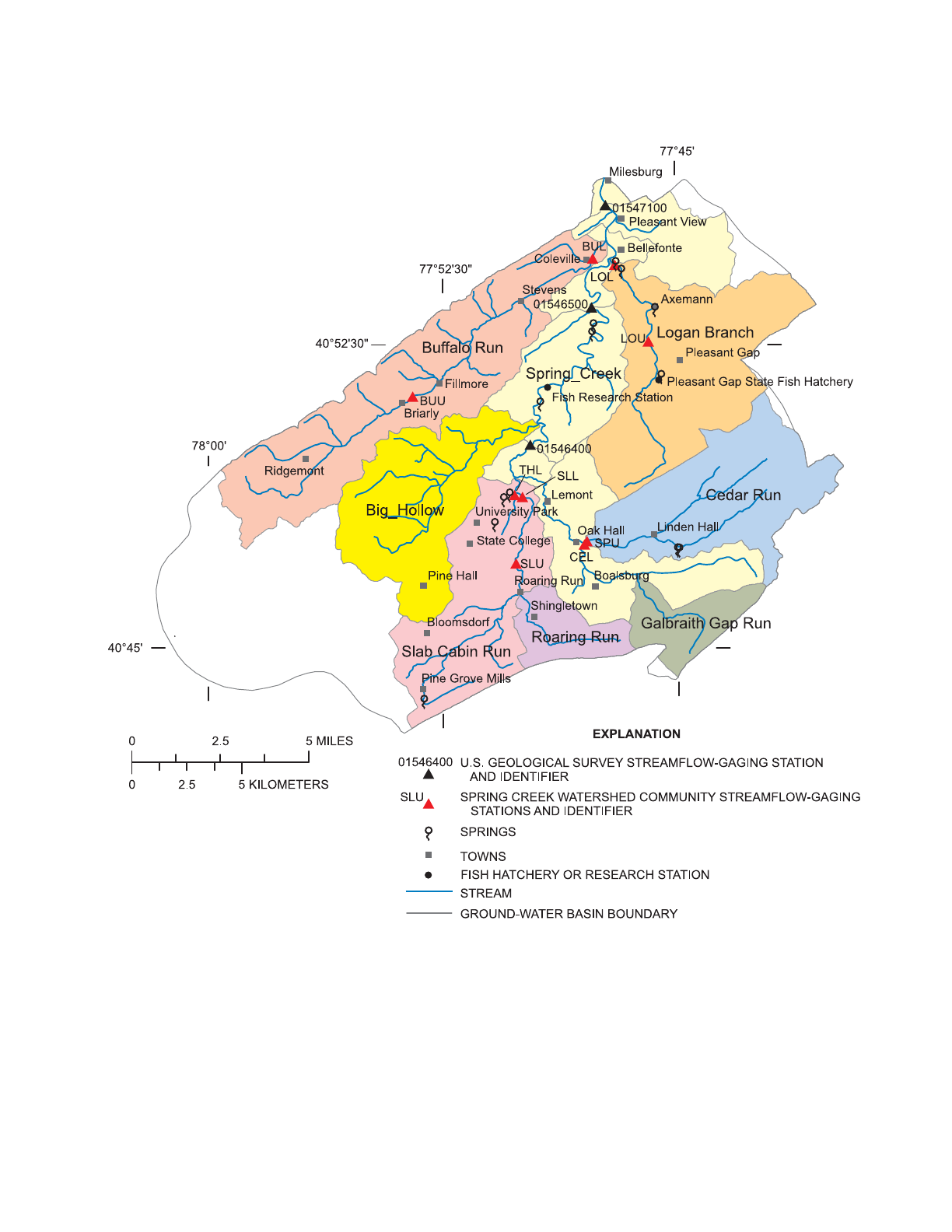
Hydrogeologic Setting of Spring Creek Basin 29
Figure 14. Location of streamflow-gaging stations and springs in the Spring Creek surface-water basin, Centre County, Pennsyl-
vania.

30 Hydrogeologic Setting and Conceptual Hydrologic Model of the Spring Creek Basin, Centre County, Pennsylvania
Table 12. Active streamflow-gaging stations in the Spring Creek Basin, Centre County, Pennsylvania.
[NAD 83, North American Datum of 1983; NAVD 88, North American Vertical Datum of 1988; na, not available]
U.S. Geological
Survey
streamflow-
gaging station
number
Station
abbreviation
Station
name
Annual mean
discharge
(cubic feet
per second)
Drainage
area
(square
miles)
Latitude
(degrees,
minutes,
seconds,
NAD 83)
Longitude
(degrees,
minutes,
seconds,
NAD 83)
Elevation
(feet in
NAVD 88)
Mean
drainage
area
slope
(percent)
Maximum
drainage
area
slope
(percent)
Period of
record
405435007747301 BUL Lower Buffalo Run na 14.2 405435 774738 748 6.3 35.5 August 1999 to present
405112007753301 BUU Upper Buffalo Run na 12.6 405112 775328 1,003 5.4 25.3 August 1999 to present
404739007747501 CEL Lower Cedar Run na 17.5 404739 774750 1,036 3.8 28.2 1990-1994, November 1998
to present
405426007746501 LOL Lower Logan Branch na 4.44 405426 774655 750 3.7 19.1 February 1999 to present
405233007745501 LOU Upper Logan Branch na 18.1 405233 774550 874 6.4 33.8 August 1999 to present
404844007749501 SLL Lower Slab Cabin Run na 1.96 404844 774955 944 2.8 9.5 June 1999 to present
404706007750101 SLU Upper Slab Cabin Run na 10 404706 775008 1,031 4.8 26.2 1990-1994, November 1998
to present
01546500 SPA Spring Creek near Axemann 93.7 87.2 405324 774740 786 4.4 30.8 October 1940 to present
01546400 SPH Spring Creek at Houserville 67.2 58.5 405002 774939 930 5.1 30.8 November 1984 to present
01547100 SPM Spring Creek at Milesburg 230 142 405554 774711 706 5.0 35.5 May 1967 to present
404734007747501 SPU Upper Spring Creek na 13.1 404734 774755 1,038 7.1 30.8 1990-1994, November 1998
to present
404847007750101 THL Lower Thompson Run na 3.88 404847 775010 939 1.7 7.7 June 1999 to present

Hydrogeologic Setting of Spring Creek Basin 31
Table 13. Period-of-record statistics for streamflow and base flow at U.S. Geological Survey streamflow-gaging stations in Spring Creek
Basin, Centre County, Pennsylvania.
U.S.
Geological
Survey
streamflow-
gaging
station
number
Station name
Drainage
area
(square
miles)
Period of record
Mean
annual
stream-
flow
(cubic
feet per
second)
Mean
annual
base flow
(cubic
feet per
second)
Mean
annual
base flow
(percent of
total
stream-
flow)
Mean
base-flow
yield
(cubic feet
per second
per square
mile)
Mean base-
flow yield for
common
period (cubic
feet per
second per
square mile)
1
01546400 Spring Creek at
Houserville, Pa.
58.5 November 1984 to
present
65.6 50.2 76.5 0.86 0.86
01546500 Spring Creek near
Axemann, Pa.
87.2 October 1940 to
present
93.2 76.9 82.5 .90 .93
01547100 Spring Creek at
Milesburg, Pa.
142 May 1967 to present 228 194 85.1 1.34 1.32
1
Common period: November 8, 1984, to September 30, 2002.
Figure 15. Stream base-flow exceedence probabilities at streamflow-gaging stations 01547100, Spring Creek at Milesburg, Pa., and
01547950, Beech Creek at Monument, Pa., for October 1, 1968, through September 30, 2002.

32 Hydrogeologic Setting and Conceptual Hydrologic Model of the Spring Creek Basin, Centre County, Pennsylvania
Table 14. Inventory of permitted surface-water withdrawals and discharges to Spring Creek Basin, Centre County, Pennsylvania (as of
November 30, 2003).
[Mgal/d, million gallons per day; ND, no data; STP, sewage treatment plant; INDWW, industrial wastewater; STMW, stormwater; GWC, ground-water cleanup;
CAFO, concentrated animal-feeding operation; TRTD GW, treated ground water]
Type Name Use Stream location Status
Permitted
volume
(Mgal/d)
Records
available
Withdrawal Oak Hall Water System, Markles Gap
Reservoir
Public Supply Tributary to Spring
Creek
Inactive ND Unknown
Withdrawal Rockview, Mcbrides Gap Reservoir Commercial Logan Branch Active ND Yes
Withdrawal State College Borough Water Author-
ity, Shingletown Gap Reservoir
Public Supply Roaring Run Active ND Yes
Withdrawal Pleasant Gap Fish Culture Station Commercial Logan Branch Active ND Yes
Withdrawal Upper Spring Creek Fish Culture Sta-
tion
Commercial Spring Creek Active ND Yes
Discharge Al Mar Acres Mobile Home Park STP Spring Creek Active 0.0105 Unknown
Discharge Atotech USA, Inc. INDWW Tributary to Big Hollow
Run
Active ND Unknown
Discharge Bellefonte Borough STP Spring Creek Active 2.4 Yes
Discharge Bellefonte Fish Culture Station INDWW Spring Creek Active 3.07 Yes
Discharge Burns, Pat STMW Buffalo Run Active .005 No
Discharge Centre Concrete Co. STMW Spring Creek Active ND No
Discharge Centre City Solid Waste Authority ND Tributary to Logan
Branch
Active ND Unknown
Discharge Cerro Metal Products INDWW,STMW,
GWC
Logan Branch Active .225 Unknown
Discharge Cerro Metal Products, Plant 5 ND Spring Creek Active ND Unknown
Discharge Con-lime, Inc. Quarry discharge Buffalo Run Active ND Unknown
Discharge Corning Asahi Video Products Co. INDWW Tributary to Logan
Branch
Active 1.97 Unknown
Discharge Daniel R. Hawbaker STP Tributary to Buffalo
Run
Active .0004 No
Discharge Gensimore Trucking, Inc. ND Tributary to Logan
Branch
Active ND Unknown
Discharge Graybec Lime, Inc. (Graymont) INDWW Buffalo Run Active ND Unknown
Discharge Gray's Vehicle Clinic STMW Logan Branch Active ND No
Discharge H.R. Bierly Auto Service STMW Tributary to Gap Run Active ND No
Discharge Hesser, Petronella STP Tributary to Spring
Creek
Active .0004 No
Discharge Hodes Industries, Inc. STMW Tributary to Logan
Branch
Active ND No
Discharge Milestone Materials, Neidighs Quarry Quarry discharge Spring Creek Active ND Unknown
Discharge Mowery Jr., Wayne STP Halfmoon Creek Active .0005 No
Discharge Murata Erie INDWW Tributary to Big Hollow
Run
Active ND Unknown
Discharge Pennsylvania Air National Guard
Station
STMW Tributary to Big Hollow
Run
Active ND Unknown
Discharge Pennsylvania Fish & Boat Commis-
sion-Benner Spring
INDWW Spring Creek Active 9.216 Yes
Discharge Pennsylvania State University INDWW Tributary to Slab Cabin
Run
Active ND Unknown

Hydrogeologic Setting of Spring Creek Basin 33
Discharge Pennsylvania State University GWC Big Hollow Run Active 0.0072 Unknown
Discharge Pennsylvania State University CAFO Buffalo Run/spring
Creek
Active ND Unknown
Discharge Pleasant Gap Fish Culture Station INDWW Logan Branch Active 5.508 Yes
Discharge Potter Township STP Cedar Run Active .035 Unknown
Discharge Ruetgers-nease Organics Corp. TRTD GW Tributary to Spring
Creek
Active .072 Unknown
Discharge Science Prk Recreation Association INDWW Tributary to Big Hollow
Run
Active ND Unknown
Discharge Smithbauer, Lawrence STP Tributary to Spring
Creek
Active .0004 No
Discharge Sms Sutton, Inc. STMW Spring Creek Active ND Unknown
Discharge Stewart Auto Parts STMW Tributary to Spring
Creek
Active ND Unknown
Discharge Superior Services of Pa., Inc. STMW Tributary to Spring
Creek
Active ND Unknown
Discharge Tolan, William STP Tributary to Buffalo
Run
Active .0004 No
Discharge University Area Joint Authority, Spring
Creek Pollution Control Facility
STP Spring Creek Active 6 Yes
Discharge United Parcel Service, Inc. STMW Tributary to Spring
Creek
Active ND Unknown
Discharge University Park Airport STMW Spring Creek and
Buffalo Run
Active ND Unknown
Discharge Upper Spring Creek Fish Culture Sta-
tion
INDWW Spring Creek Active .576 Yes
Table 14. Inventory of permitted surface-water withdrawals and discharges to Spring Creek Basin, Centre County, Pennsylvania (as of
November 30, 2003).—Continued
[Mgal/d, million gallons per day; ND, no data; STP, sewage treatment plant; INDWW, industrial wastewater; STMW, stormwater; GWC, ground-water cleanup;
CAFO, concentrated animal-feeding operation; TRTD GW, treated ground water]
Type Name Use Stream location Status
Permitted
volume
(Mgal/d)
Records
available

34 Hydrogeologic Setting and Conceptual Hydrologic Model of the Spring Creek Basin, Centre County, Pennsylvania
Ground Water
Ground water is important in the Spring Creek Basin
because it is the source of most water supplies and it sustains the
high-quality cold-water streamflow in Spring Creek. Wells and
springs where characteristics of the ground-water system have
been collected are shown in figure 16. The available data
include drilling logs, water levels, and water-quality data,
which have been partly compiled in Appendixes 1 and 2.
Aquifer Properties
Values for transmissivity and storativity were calculated
from aquifer tests in the Spring Creek Basin. References for the
aquifer-test data include Siddiqui (1969), Parizek and others
(1971), Nittany Geoscience Inc. (1988a, 1988b, 1990, 1991a,
1991b, 1991c, 1992a, and 1992b), Parizek (2000), and several
internal papers from the Pennsylvania State University Office
of Physical Plant (John Gaudlip, written commun., 2003).
Transmissivity and storativity values are presented in
figure 17 and table 15 for wells where sufficient documentation
of the aquifer test was available. The range of transmissivity
values for the Gatesburg Formation, the most productive car-
bonate-rock aquifer, is from about 40 to 35,000 ft
2
/d. The trans-
missivity values determined for the Bellefonte and Nittany For-
mations range from about 2 to 4,800 ft
2
/d, which are generally
less than values of the Gatesburg Formation. Only two trans-
missivity values are presented in table 15 for the siliciclastic-
rock aquifer, 9 and 30 ft
2
/d, which are from the Reedsville For-
mation.
Insight into the anisotropic conditions in the carbonate-
rock aquifers was provided by Siddiqui (1969) using analysis of
boundary conditions and image-well calculations for many of
the aquifer tests. Anisotropy with respect to hydraulic conduc-
tivity caused by fractures and faults oriented along the strike of
beds is probably a major influence on the area of influence and
source of water to wells withdrawing water from the carbonate-
rock aquifers in the valleys. The hydraulic conductivity along
strike in the valleys has been estimated to be three to eight times
greater than the hydraulic conductivity in the dip direction (Gid-
dings and Associates, 1995).
Well yields and specific-capacity data can be used to pro-
vide estimates of aquifer hydraulic conductivity and insights
into factors affecting its magnitude. Siddiqui (1969) and Sid-
diqui and Parizek (1971) related well yields in the Spring Creek
Basin to six hydrogeologic factors: bedrock lithology, dip of
strata, topographic setting, depth of water table, proximity of
wells to anticlinal or synclinal axes, and location of the wells
with respect to fracture traces or concentrations of fracture
zones. The researchers evaluated productivity of the wells,
defined as adjusted specific capacity per foot of prepumping
saturated thickness. Results showed that wells on or near frac-
ture traces were more productive than wells removed from frac-
ture traces. The median productivity for wells near fracture
traces was 0.079 (gal/min)/ft compared to a median productiv-
ity of 0.0014 (gal/min)/ft for wells removed from fracture
traces. Wells completed in sandy and coarse-grained dolomites,
such as the Gatesburg Formation, were the best producers
(median productivity was 0.12 (gal/min)/ft for the upper sandy
member of the Gatesburg Formation); wells tapping the Nittany
Formation had the second highest productivity
(0.068 (gal/min)/ft). Although no wells were analyzed that pen-
etrated highly cavernous limestone beds, rocks with significant
secondary and primary intergranular porosity and permeability,
such as the sandy dolomite rocks, were the best producers.
Other conclusions indicated by the work of Siddiqui
(1969) and Siddiqui and Parizek (1971) were:
• Wells in valley bottoms were more productive than
wells in valley slopes or uplands. (The carbonate rocks
of high primary and secondary permeability are all in
the valleys.)
• Wells near anticlinal axes were more productive than
wells near synclinal axes.
• Wells in bedrock that dip less than 15° had higher
yields than wells in bedrock with steeper dips.
• Wells with varying depth to water table were not sig-
nificantly different, but the highest well yields were
associated with the deepest and shallowest water table.
(Depth to the water table for wells open to the Gates-
burg Formation commonly is greater than 100 ft and
can be more than 400 ft.)
Few calculations of storage values have been made in the
Spring Creek Basin. Storativity values reported from a few
aquifer tests for State College Borough Water Authority wells
ranged from 0.0003 to 0.00072 for wells open to the upper
sandy member of the Gatesburg Formation. Specific yields
were calculated as about 1.5 percent for the entire Spring Creek
Basin that is underlain by 80 percent Cambro-Ordovician car-
bonate rocks and 20 percent Ordovician fine-grained lime-
stones, sandstones, and shales (Giddings, 1974). The Gatesburg
Formation alone is estimated to have a specific yield of 3 to
5 percent (Parizek and others, 1971). Specific yield for the
Ordovician mostly fine-grained limestones, sandstones, and
shales, including the residual soils, colluvium, and stream allu-
vium in the Nittany Valley area, was calculated by Konikow
(1969) to range from 1 to 2.5 percent.
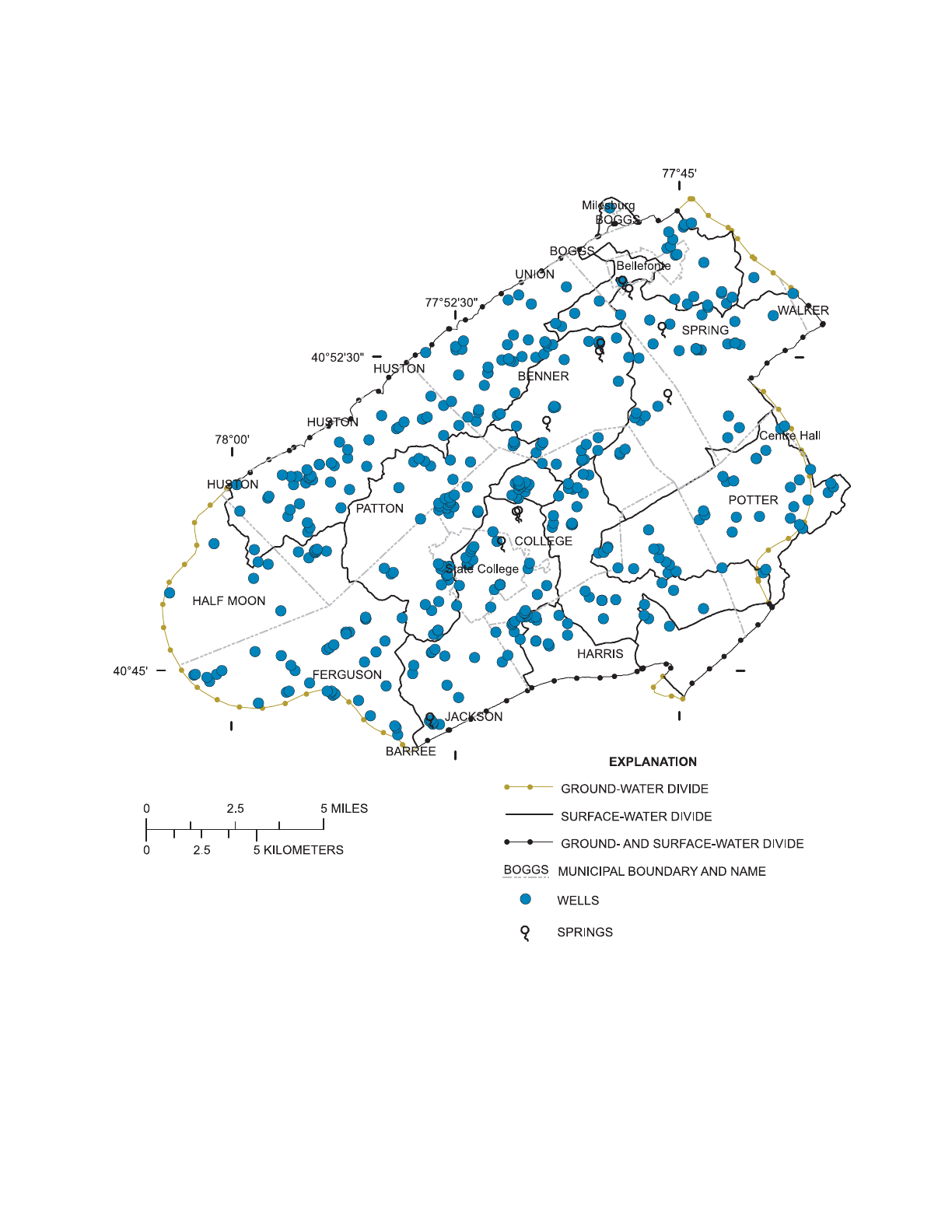
Hydrogeologic Setting of Spring Creek Basin 35
Figure 16. Locations of selected wells and springs in the Spring Creek Basin, Centre County, Pennsylvania.

36 Hydrogeologic Setting and Conceptual Hydrologic Model of the Spring Creek Basin, Centre County, Pennsylvania
Table 15. Transmissivity and storativity values for the carbonate- and siliciclastic-rock aquifers in the Spring Creek Basin,
Centre County, Pennsylvania (from Siddiqui, 1969; Parizek and others, 1971; Nittany Geoscience Inc., 1988a, 1988b, 1990, 1991a,
1991b, 1991c, 1992a, 1992b; Parizek, 2000; and John Gaudlip, Pennsylvania State University, Office of Physical Plant, written
commun., 2003)
[ft
2
/d, feet squared per day; ---, more than one value; nd, no data; —, only one value; Note, anisotropy ratios (Kx/Ky) vary from 4 to 8]
Local
well
number
Aquifer
Transmissivity,
(if only one
value reported)
(ft
2
/d)
Transmissivity,
minimum,
(ft
2
/d)
Transmissivity,
maximum,
(ft
2
/d)
Storativity
434 Bellefonte Formation --- 275 549 nd
420 Bellefonte Formation --- 8 23 nd
421 Bellefonte Formation --- 26 66 nd
422 Bellefonte Formation --- 724 1,340 nd
432 Bellefonte Formation --- 637 1,206 nd
442-A Bellefonte Formation --- 13 34 nd
433 Bellefonte Formation --- 2 8 nd
425 Bellefonte Formation --- 174 359 nd
426 Bellefonte Formation --- 39 96 nd
401 Nittany Formation --- 80 177 nd
402 Nittany Formation --- 19 49 nd
SC-22 Nittany Formation 4,783 — — nd
SC-24 Nittany Formation 2,358 — — nd
SC-25 Nittany Formation 708 — — nd
297 Reedsville Formation --- 13 30 nd
399 Reedsville Formation --- 9 24 nd
SC-63 upper sandy member, Gatesburg Formation 1,822 — — 0.00060
SC-64 upper sandy member, Gatesburg Formation 746 — — .00051
SC-65 upper sandy member, Gatesburg Formation 4,878 — — .00030
SC-19 lower sandy member, Gatesburg Formation 14,472 — — nd
SC-17 lower sandy member, Gatesburg Formation 34,974 — — nd
SC-78 Mines Member, Gatesburg Formation 4,109 — — nd
UN-2 upper sandy member, Gatesburg Formation --- 4,355 7,705 nd
413 upper sandy member, Gatesburg Formation --- 1,702 3,082 nd
UN-25 upper sandy member, Gatesburg Formation --- 224 462 nd
UN-3 upper sandy member, Gatesburg Formation --- 4,824 8,509 nd
UN-16 upper sandy member, Gatesburg Formation --- 851 1,568 nd
UN-17 upper sandy member, Gatesburg Formation --- 3,980 7,102 nd
UN-20 upper sandy member, Gatesburg Formation --- 42 99 nd
UN-24 upper sandy member, Gatesburg Formation --- 5,762 10,050 nd
SC-5 upper sandy member, Gatesburg Formation --- 14,606 24,924 nd
UN-14 upper sandy member, Gatesburg Formation --- 2,251 4,087 nd
SC-55 upper sandy member, Gatesburg Formation 1,876 — — .00049
SC-57 upper sandy member, Gatesburg Formation 1,876 — — .00049
SC-62 upper sandy member, Gatesburg Formation 32,294 — — .00072
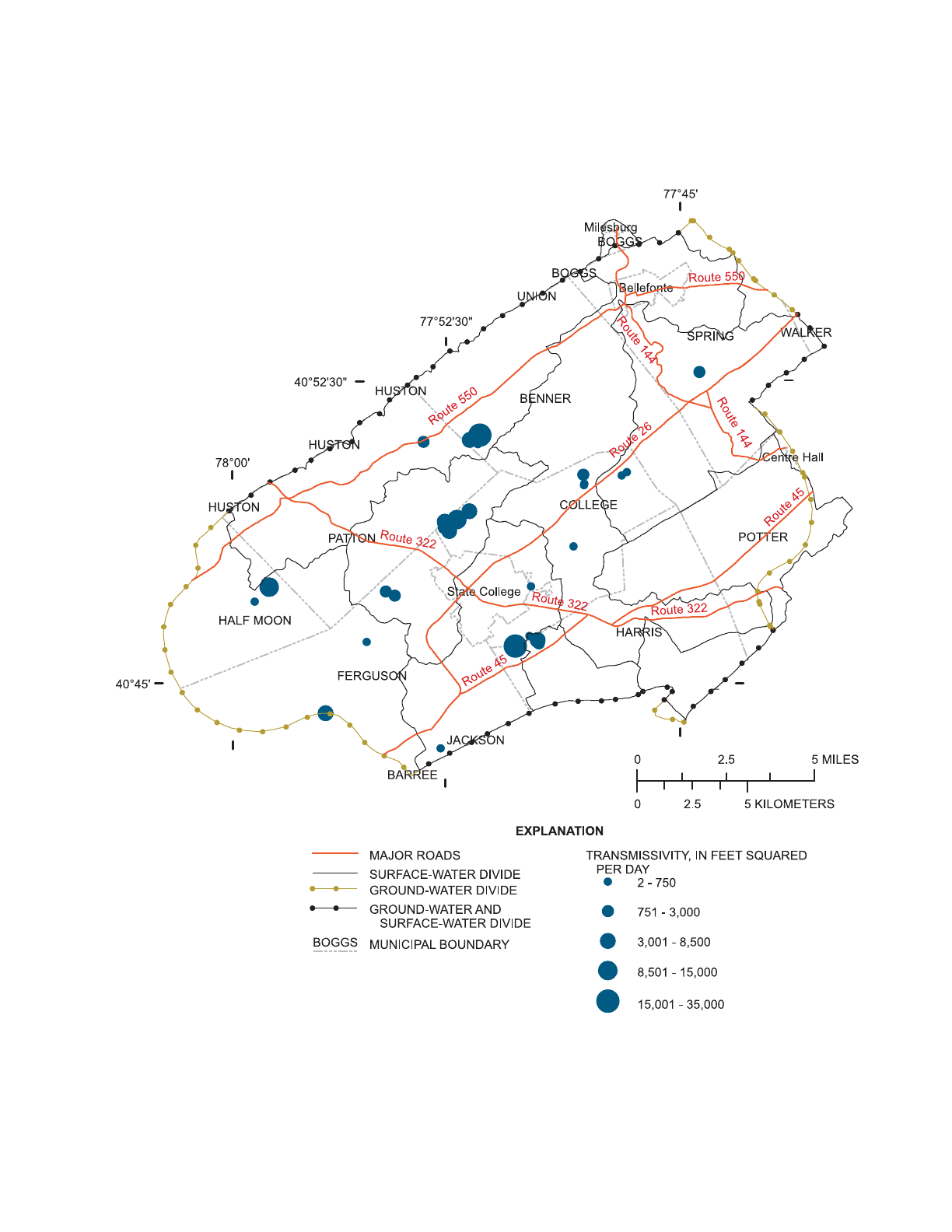
Hydrogeologic Setting of Spring Creek Basin 37
Figure 17. Transmissivity values determined from aquifer tests in the Spring Creek Basin, Centre County, Pennsylvania.

38 Hydrogeologic Setting and Conceptual Hydrologic Model of the Spring Creek Basin, Centre County, Pennsylvania
Water Levels
The maps of Giddings (1974), Wood (1980), and Taylor
(1997) show the configuration of the water table in the Spring
Creek Basin. Giddings (1974) showed that the extent of the
ground-water basin was distinct from the extent of the surface-
water drainage basin of Spring Creek (fig. 18) on the basis of
water levels from a network of more than 125 observation wells
during March 1969. Wood (1980) enhanced the Giddings’
water-table map by adding water-level data from wells beyond
the ground-water basin boundary to better define the ground-
water basin boundary; however, the data from beyond the
boundary were collected after March 1969. Taylor (1997) delin-
eated the extent of the ground-water basin from water levels
measured at 254 wells in October 1994, although some water-
level data are from time periods prior to October 1994 (fig. 19).
Taylor delineated a ground-water basin area smaller than Gid-
dings (1974) by about 10 mi
2
(about 165.6 mi
2
). The reason for
the difference is probably that the ground-water divide is
dynamic and influenced by precipitation. Two areas were iden-
tified where the ground-water basin is significantly different
from the surface-water basin: the southwestern part of the area,
which includes the barrens northeast of Half Moon Creek and
the region north of Fairbrook, and a smaller area south of Centre
Hall. The locations of these discrepancies correlate with the
presence of plunging anticlines in the bedrock. The ground-
water basin appears to be larger than the surface-water basin
where the direction of anticlinal plunge is toward the Spring
Creek Basin, and smaller where the opposite occurs. Other fac-
tors, such as bedrock permeability, also must have an influence
on the boundary of the ground-water basin (Taylor, 1997).
Wells and Springs
In the Spring Creek Basin, ground water principally dis-
charges to streams and springs. Many of the streams in the
Spring Creek surface-water basin are intermittent or disappear-
ing streams that reappear because of discharge from springs.
The locations and yields of several large springs are shown in
figure 20. Many of the spring locations are aligned with the
strike of the rocks in the valley. A number of the larger yielding
springs in the basin have been used as water sources by public
water suppliers, and water withdrawals average about
6.9 Mgal/d. An inventory of spring-water withdrawals for pub-
lic use is presented in table 16. Domestic and industrial users
also withdraw spring water, but records of these withdrawals
are not available.
Table 16. Inventory of water withdrawals for public use from springs in the Spring Creek Basin, Centre County, Pennsylvania.
Spring name
Local well
number
Use Establishment name
Reported
average use
(million
gallons per
day)
Year
reported
Bathgate #1 Spring CE SP2 Public supply Lemont Water Company 0.089 1994
Bathgate #2 Spring CE SP27 Public supply Lemont Water Company .089 1994
Big Spring CE SP5 Public/commercial supply Bellefonte Borough Water
Authority
5.909 2000
Benner Spring CE SP16 Public/institutional supply Rockview State Correction
Institute
.524 2000
Axemann Spring CE SP17 Public supply Spring Township Water
Authority
.149 1994
Unnamed CE SP15 Public supply Ferguson Township Authority .054 1994
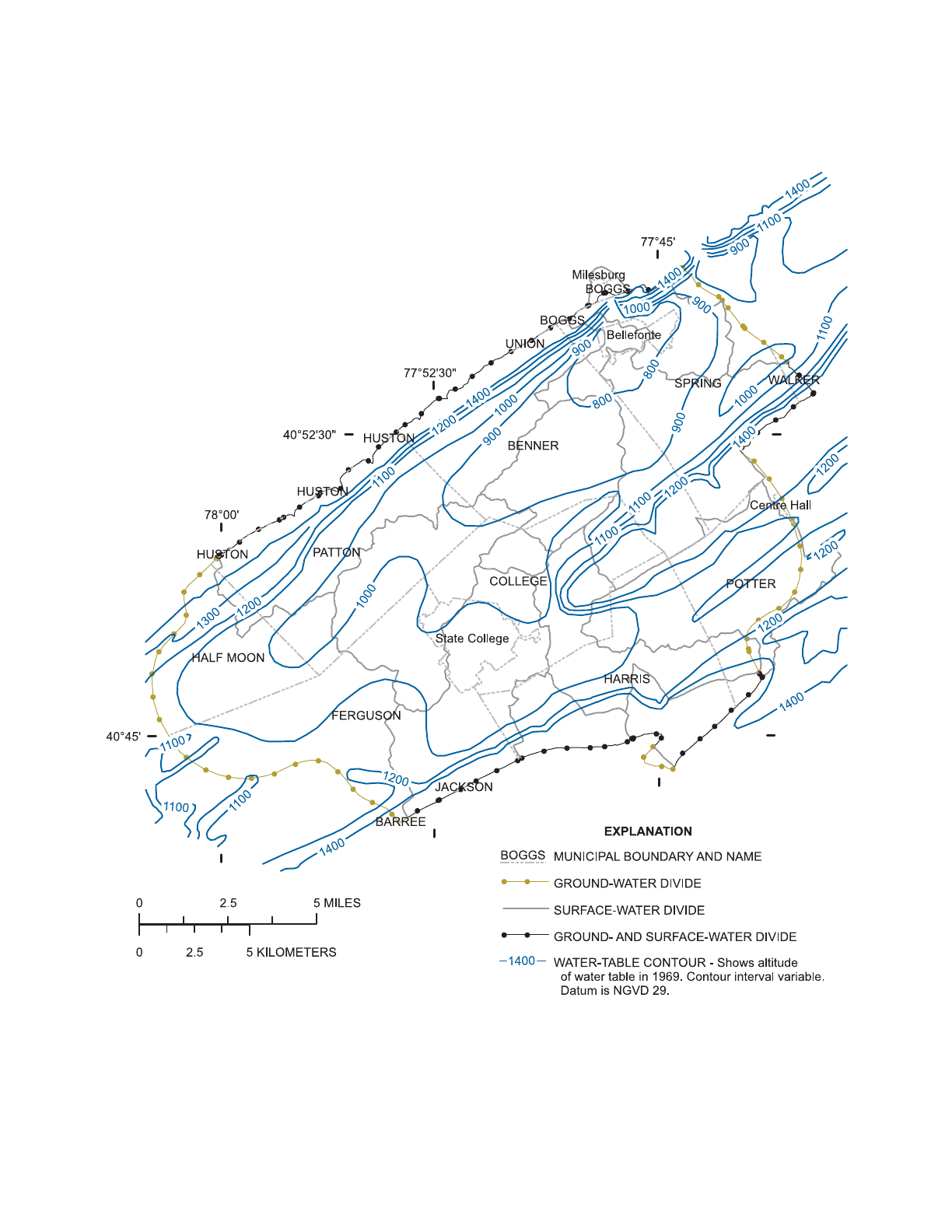
Hydrogeologic Setting of Spring Creek Basin 39
Figure 18. Water-table map of the Spring Creek Basin, Centre County, Pennsylvania, 1969 (from Wood, 1980). The ground-water
divide (from Giddings, 1974) does not agree with water-table contours in some areas because additional water-level data were
obtained by Wood (1980).

40 Hydrogeologic Setting and Conceptual Hydrologic Model of the Spring Creek Basin, Centre County, Pennsylvania
Figure 19. Water-table map of the Spring Creek Ba-
sin, Centre County, Pennsylvania, and generalized direction of ground-water flow, 1994 (from Taylor, 1997).

Hydrogeologic Setting of Spring Creek Basin 41
Figure 20. Location and average discharge of major springs in the Spring Creek Basin, Centre County, Pennsylvania (data
from Saad and Hippe, 1990; Pennsylvania Department of Environmental Protection, written commun., 2004).

42 Hydrogeologic Setting and Conceptual Hydrologic Model of the Spring Creek Basin, Centre County, Pennsylvania
Big Spring, in Bellefonte, has the greatest average dis-
charge rate in the ground-water basin at about 19 Mgal/d, and
5.9 Mgal/d of that is withdrawn for water supply. This spring is
downslope in the valley from the Birmingham Thrust Fault. The
discharge rate from 1986 to 2003 is plotted in figure 21. The
weir used to determine the discharge rate was improved in
2002, which accounts for the increase in measured discharge.
Springs that discharge from limestone and dolomite have
been classified into two types by Shuster and White (1971). In
diffuse springs, water flows at low velocities along joints, frac-
tures, and bedding planes, which are generally less than 1 in.
wide. In conduit springs, the flow commonly is turbulent and is
through solution openings ranging from 1 in. to 10 ft in diame-
ter. The conduit-flow springs respond quickly to precipitation (a
few days), and the diffuse-flow springs respond more slowly
(days to months) to precipitation (Wood, 1980).
Ground-water withdrawals for public supply have been
increasing in Spring Creek Basin over the past 22 years
(fig. 22). The pumpage shown includes average annual ground-
water withdrawal rates available from State College Borough
Water Authority during 1980-2002, from the Pennsylvania
State University during 1994-2002, and from College Town-
ship only during 2000-02 (Max Gill, State College Borough
Water Authority, written commun., 2003; John Gaudlip, Penn-
sylvania State University, written commun., 2003; Gary Will-
iams, College Township, written commun., 2003). These with-
drawal data are for public supply only and are presented in
table 17. Ground-water withdrawals for private supply have not
been compiled. Ground-water withdrawals for industrial or
manufacturing use may not all be included in the public-supply
numbers.
Table 17. Average annual base flow of Spring Creek at
Milesburg, Pennsylvania, 1968-2002, and average annual
ground-water withdrawals from public supply wells in the
Spring Creek Basin, 1980-2002 (from (Max Gill, State College Bor-
ough Water Authority, written commun., 2003; John Gaudlip, Penn-
sylvania State University, written commun., 2003; Gary Williams,
College Township, written commun., 2003).
[Mgal/d, million gallons per day; na, data not available]
Year
Annual base flow
(Mgal/d)
Average yearly
pumpage rate
(Mgal/d)
1968 88.0 na
1969 72.9 na
1970 116.6 na
1971 111.9 na
1972 136.1 na
1973 140.6 na
1974 126.2 na
1975 137.1 na
1976 139.3 na
1977 141.2 na
1978 158.0 na
1979 165.8 na
1980 131.0 3.1
1981 109.4 2.4
1982 134.0 2.4
1983 124.8 2.8
1984 159.7 2.8
1985 124.6 2.8
1986 114.4 3.0
1987 115.3 3.1
1988 98.4 4.6
1989 124.4 4.6
1990 137.2 4.4
1991 119.4 4.4
1992 97.4 4.4
1993 146.6 5.1
1994 154.7 5.6
1995 112.0 5.1
1996 168.5 5.2
1997 136.1 6.1
1998 155.8 5.1
1999 103.7 7.0
2000 103.8 8.3
2001 92.8 8.9
2002 105.0 9.1
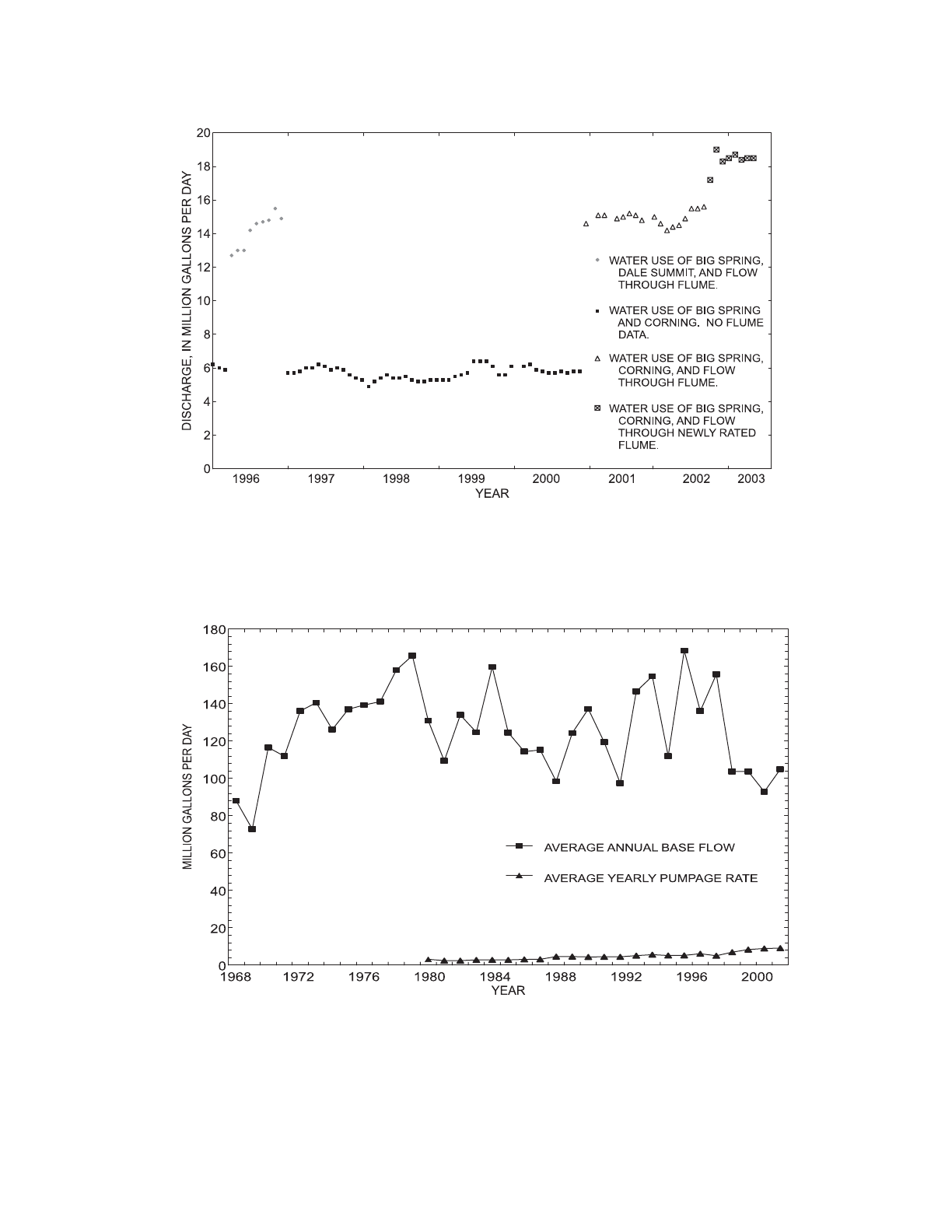
Hydrogeologic Setting of Spring Creek Basin 43
Figure 21. Discharge at Big Spring in Bellefonte, Pennsylvania (1996-2003) (from Ralph Stewart,
Bellefonte Borough, written commun., 2003).
Figure 22. Average annual rate of ground-water withdrawals for public supply and average annual
base-flow rate at Milesburg for Spring Creek Basin, Centre County, Pennsylvania. (The pumpage in-
cludes average annual ground-water withdrawal rates available from State College Borough Water
Authority during 1980-2002, from the Pennsylvania State University during 1994-2002, and from College
Township during 2000-2002.)
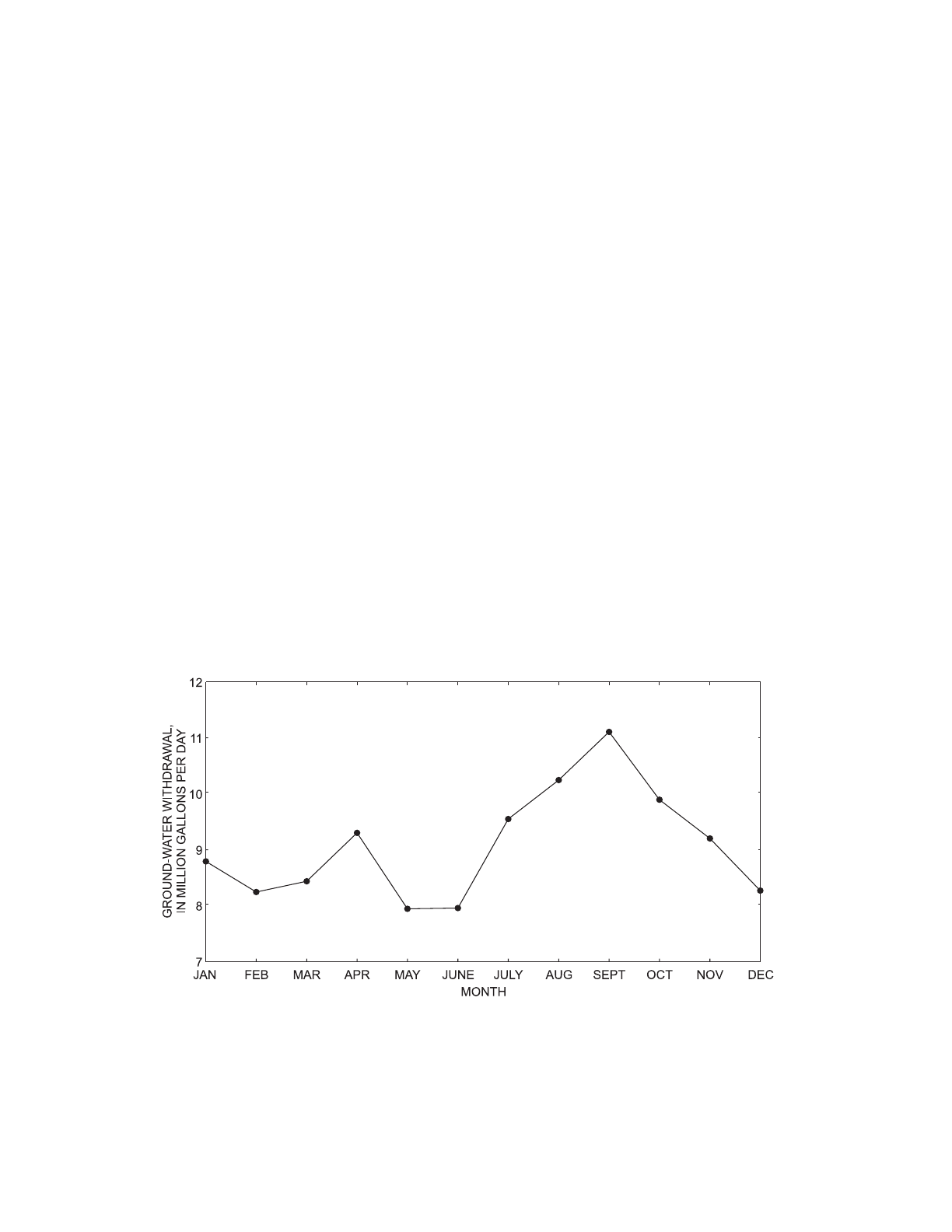
44 Hydrogeologic Setting and Conceptual Hydrologic Model of the Spring Creek Basin, Centre County, Pennsylvania
The ground-water withdrawals have increased from about
3 Mgal/d to over 9 Mgal/d in 2002. Because of the lack of with-
drawal data prior to 1994, withdrawals shown for pre-1994 are
incomplete estimates of total withdrawals. The withdrawals are
only about 7 percent of average ground-water recharge rate esti-
mated at 125 Mgal/d. Although the pumpage will result in low-
ered water levels locally, the total withdrawals are small com-
pared to total recharge rates. The total allocations of the water-
supply companies and authorities may result in a larger percent-
age of the recharge being used for supply. During years of low
precipitation, such as 1969, 1968, and 2001, the ground-water
recharge was much less (73, 87, and 92 Mgal/d, respectively).
The rate of ground-water withdrawal for 2001 (about
8.9 Mgal/d) was 9.6 percent of the average base flow of 2001.
As ground-water withdrawal rates increase, the percentage of
recharge extracted for supply will increase, and in future
drought years, the percentage of base flow used for water sup-
ply could be larger than at present. The effects of increased per-
centage of recharge used for supply during future drought years
would result in lowering of water levels below present levels,
and the recovery of water levels in deep ground-water-flow sys-
tems, such as in the Gatesburg Formation, may take much more
time than current recovery of water levels in nondrought years.
The timing of the withdrawals can have a notable effect on
water levels, and there is a seasonal pattern to the ground-water
withdrawals, as shown in figure 23. The withdrawals are great-
est in the summer and probably reflect greater usage of water
for irrigation and recreation. During the summer, the water-
level declines would be greater than in winter months because
of increased pumpage and also because of greatly reduced
recharge when evapotranspiration is high.
The pumpage in the Spring Creek Basin is distributed
throughout much of the study area but is concentrated in the
vicinity of State College and farther west in Nittany Valley
where the productive Gatesburg Formation aquifer is present.
The 2002 average annual pumpage rates for public supply are
illustrated in figure 24.
Water Quality
Water-quality data for the Spring Creek Basin have been
collected at various locations and for various constituents for
more than 50 years. The PaDEP, the SCWC, and the USGS
have accumulated the most comprehensive databases. Other
water-quality data have been collected by various water users,
dischargers, and students at the Pennsylvania State University.
Water-quality data of interest include surface- and ground-
water physical and chemical characteristics. Water-quality data
from spring discharges are also of importance because of the
large contribution to surface-water discharge from springs in
the Spring Creek Basin. A summary of the water-quality data is
presented in table 18 (at the back of the report).
Figure 23. Average monthly ground-water withdrawals for public supply in Spring Creek Basin,
Centre County, Pennsylvania, 1980-2002.
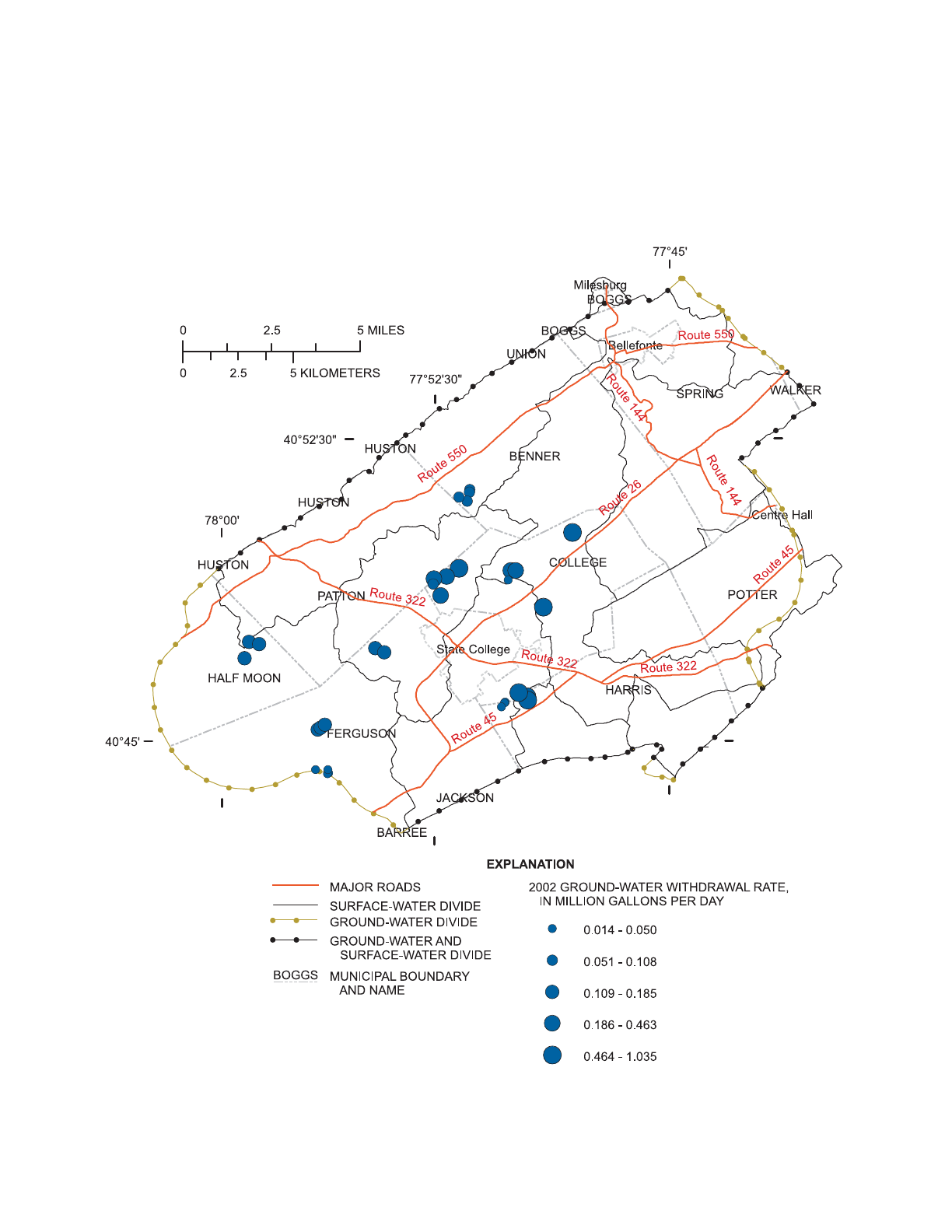
Hydrogeologic Setting of Spring Creek Basin 45
Figure 24. Ground-water withdrawal rates for public supply wells in Spring Creek Basin, Centre County, Pennsylvania, 2002.

46 Hydrogeologic Setting and Conceptual Hydrologic Model of the Spring Creek Basin, Centre County, Pennsylvania
Surface Water
Surface-water-quality data for Spring Creek Basin include
synoptic (collected as simultaneously as possible) data and peri-
odic sample data. These data include physical and chemical
water-quality characteristics from 12 locations in the basin
(table 18).
The longest period of record exists for the site on Spring
Creek near Axemann, Pa. Since 1950, the PaDEP has sampled
this site (WQN415) on a regular schedule as part of their Water
Quality Network (WQN). WQN415 is collocated with USGS
streamflow-gaging station 01546500 (fig. 14). Water quality at
this site also has been sampled by the SCWC (site SPA) and the
USGS. The suite of constituents sampled has changed over
time. An inventory of current (2003) and historical water-qual-
ity data at this site is listed in table 19 (at the back of the report).
Beginning in 1999, the SCWC began collecting compre-
hensive water-quality data at 12 locations in Spring Creek
Basin. Six of these sites are collocated with existing stream-
flow-gaging stations operated by the Pennsylvania Cooperative
Fish and Wildlife Research Unit or by the USGS. An inventory
of the constituents sampled is listed in table 19 and is the same
for all 12 sites.
The USGS has collected a limited amount of surface-
water-quality data in the basin. All but a few random samples
have been collected from Spring Creek near Axemann, Pa.
(USGS streamflow-gaging station 01546500) (table 19).
Ground Water
Water-quality data contained in the USGS database for
wells in the Spring Creek Basin are listed in tables 20
through 24 (at the back of the report). Water-quality data for
selected springs are shown in table 25 (at the back of the report).
Thirty of the 41 wells are open to the carbonate-rock aquifers
and 4 are screened in siliciclastic-rock aquifers. The water-qual-
ity data have not been correlated to the aquifer type.
As expected from ground-water samples from carbonate-
rock aquifers, calcium, magnesium, and bicarbonate concentra-
tions and pH values are high relative to concentrations in
ground water from siliciclastic-rock aquifers. Nitrate concen-
trations range from 0.05 to 12.7 mg/L; the mean and median
concentrations are 3.7 and 3.5 mg/L, respectively. Two of the
wells sampled contained nitrate concentrations greater than
10 mg/L, the maximum contaminant level permitted by the U.S.
Environmental Protection Agency drinking-water regulations
(U.S. Environmental Protection Agency, 2002). Radon was
reported in one well. Samples from three wells were analyzed
for organic pesticides. Acifluorfen, alachlor, atrazine, deethyl
atrazine, metalochlor, prometon, and simazine were detected in
the water from at least one well and some of the organics were
detected in all three wells. Samples from three wells were ana-
lyzed for Escherichia coli, enterrococci, and fecal streptococci
bacteria, and water from two of the three wells contained bacte-
ria colonies.
The PaDEP has investigated the presence of Perchloroeth-
ylene (PCE) in the State College area (Randy Farmerie, Penn-
sylvania Department of Environmental Protection, written
commun., 2004). Since the mid-1980s, PCE has been found in
several springs in the State College area at concentrations rang-
ing from 5 to 50 µg/L. PCE also has been found in four water-
supply wells in the State College area at concentrations ranging
from 1 to 8 µg/L. In the summer of 2002, the PaDEP drilled six
observation wells to monitor the PCE and try to determine the
source of the contamination, but only one well showed a very
low concentration of PCE and the other five wells showed no
PCE.

Conceptual Hydrologic Model of Spring Creek Basin 47
Conceptual Hydrologic Model of Spring
Creek Basin
A conceptual model is a simplified representation of the
hydrologic system that is to be modeled (Anderson and Woess-
ner, 1992). Karst conceptual models are physical in nature and
describe the hydrologic connectivity between recharge areas,
hydraulic properties, and geology that controls the way in
which water is added, stored, conveyed, and discharged through
the system (White, 2003). Because of the variability in land use
and the hydrologic complexity of the Spring Creek Basin, the
conceptual model must consider the integration of surface water
and ground water to (1) account for the physical exchange of
water, and (2) identify the processes that influence source
(recharge) and sink (water use) terms within a basin. This sim-
plification is necessary, because a complete accounting of water
is not possible. Traditionally, most hydrologic systems are ana-
lyzed as parts, rather than a single entity.
The Spring Creek Basin consists of two principal set-
tings—a forested, siliciclastic-bedrock upland and a carbonate-
bedrock valley with agricultural and urban land use (fig. 25).
Precipitation, runoff, and infiltration from the uplands provide
streamflow and ground-water recharge to the valley. The con-
ceptual model for the Spring Creek Basin can be described by
the processes of precipitation, runoff, infiltration, and stream-
flow that are common to the hydrology of the siliciclastic-bed-
rock upland and of the carbonate-bedrock valley. These con-
cepts are discussed below and illustrated in figure 26.
Figure 25. Major hydrologic settings, boundaries, and generalized direction of ground-water movement in Spring
Creek Basin, Centre County, Pennsylvania.
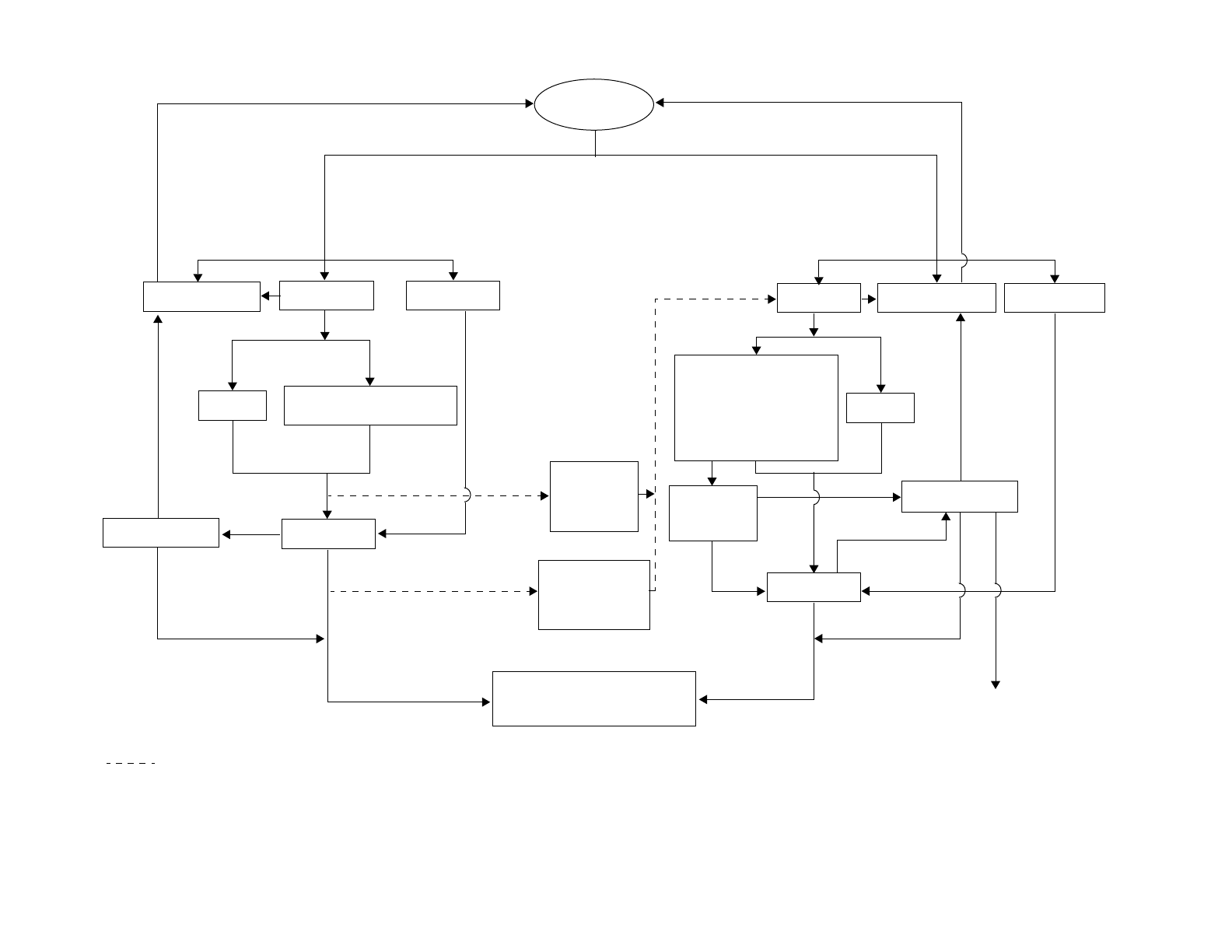
48 Hydrogeologic Setting and Conceptual Hydrologic Model of the Spring Creek Basin, Centre County, Pennsylvania
Figure 26. Water-budget components showing exchange of water from siliciclastic-bedrock uplands to carbonate-bedrock valley.
Carbonate-Bedrock Valleys
Siliciclastic-Bedrock Uplands
Infiltration
Evapotranspiration
Streamflow
Spring Creek at Milesburg
Interflow
Recharge
Streamflow
(includes tributaries and springs)
Unchanneled
EXPLANATION
EXCHANGE BETWEEN UPLANDS AND VALLEYS
Direct runoff
Streamflow loss
along mountain
fronts
Precipitation
runoff along
mountain
front
Consumptive Use
into sinkholes
Recharge
Interflow
1. Unsaturated zone storage
Infiltration
1. Swallets
2. Closed depressions
3. Epikarst
4. Perched catchments
5. Unsaturated zone storage
Springs
1. Underflow
2. Overflow
Direct runoff Evapotranspiration
Consumptive Use
Exported from basin

Conceptual Hydrologic Model of Spring Creek Basin 49
Precipitation, Runoff, Infiltration, and Streamflow
To conceptualize the hydrology of a basin, the relation
between precipitation and runoff must be established. From a
water-balance perspective, it is important to understand the
mechanics of how a basin responds to a precipitation event and
how streamflow is generated. This is particularly true in the
case of the Spring Creek Basin, where the geology, topography,
land use, soil cover, and vegetation are extremely variable from
one subbasin to another.
The three components that contribute to streamflow
include overland runoff, subsurface stormflow, and ground-
water flow. For the purposes of this section, only overland run-
off and subsurface stormflow are discussed below. Ground-
water contributions in the form of recharge and discharge will
be addressed in the siliclastic-bedrock upland and carbonate-
bedrock valley sections that follow.
Overland runoff is the product of either (1) infiltration
excess associated with a rainfall event where its intensity
exceeds the infiltration capacity of the soil or (2) saturation
excess where the soil above the water table or perched surface
becomes completely saturated and any additional precipitation
produces runoff. The former is known as partial source-area
contributions (PSAc) and the latter as variable source-area con-
tributions (VSAc) It is rare that overland runoff is created by
infiltration excess from vegetated cover in humid regions such
as the Spring Creek Basin, where vegetation protects the soil
from compaction and dispersion from precipitation. As a result,
the soil structure is maintained. In contrast, PSAc may develop
in areas where impervious cover is prevalent such as Bellefonte,
Centre Hall, Milesburg, and State College or in areas where thin
soil layers and low infiltration capacities dominate such as the
Hagerstown-Opequon-Hublersburg, Murrill, and Opequon-
Hagerstown soil groups, common to Nittany and Penns Valleys.
PSAc are fixed spatially and are reorganized as areas within the
basin that regularly contribute overland runoff.
Saturation excess related to VSAc occurs when the unsat-
urated zone is not capable of transmitting subsurface stormflow
(interflow), and the soil becomes saturated. If the rate of subsur-
face stormflow entering a saturated area from upslope exceeds
its capacity to be transmitted, the excess stormflow returns to
the surface as runoff. As precipitation continues, the saturated
area grows in extent, increasing the area capable of generating
runoff (Cornell University, Soil and Water Laboratory, 2005).
VSAc tend to expand and contract depending on the intensity
and duration of saturation. Runoff originates from small areas
within a basin, which constitute no more than 10 percent and
often as little as 1 to 3 percent of the total basin area (Freeze and
Cherry, 1979).
VSAc saturation excess is common in regions such as the
Spring Creek Basin that are humid and possess soils that are
thin, are well vegetated with large infiltration capacities, and are
underlain by low-permeability layers (bedrock and fragipan).
Subsurface flow (lateral flow within the unsaturated zone)
above the water-table surface also supplies water to streamflow.
Typically, runoff forms adjacent to drainage ways (near con-
verging topography), stream banks, shallow water tables, and at
the bottom of hill slopes such as Galbraith Gap Run, Logan
Bald Eagle, and Roaring Run. These saturated areas expand
along hollows or where the water table is close to the ground
surface (Larry Fennessey, Sweetland Engineering and Associ-
ates, written commun., 2005).
To quantify VSAc runoff, the following parameters are
needed: rainfall intensity and duration, unsaturated zone thick-
ness, available water-storage capacity, depth to bedrock, soil
hydraulic properties, water table or perched water depth,
hydrology of the upland-subbasin area, and local topography.
The eight subbasins within the Spring Creek surface-water
basin differ relative to their underlying geology, soil, slope,
vegetation cover, infiltration rate, and the distribution of rainfall
(intensity, duration, and depth). As a result, processes associ-
ated with streamflow generation can be complex and different
for each subbasin.
For example, subbasins such as Galbraith Gap Run, Logan
Run, and Roaring Run are well vegetated, are located along
steep slopes, and possess soil mantles that are thin with high
infiltration capacities. Runoff from these subbasins is produced
when subsurface flow saturates the soil above the water-table
surface near the bottom of hill slopes and near streambanks as
precipitation continues to fall on saturated soil.
Streamflow is produced by overland runoff and subsurface
stormflow. The exchange of water within the channel and the
underlying aquifer system must be established to provide a
proper accounting of the water budget for the Spring Creek
Basin. This is particularly true in subbasins that have permanent
streams within gaps (Buffalo Run, Roaring Run, and Galbraith
Gap Run) and receive mountain runoff. Water within the
streams may be lost by infiltration through the streambed.
Streamflow is discharged directly to sinkholes or flows into
tributaries to Spring Creek. Depending on the hydraulic head
differences between the underlying aquifer and the surface-
water elevation, the exchange could be substantial.
Siliciclastic-Bedrock Uplands
The siliciclastic-bedrock uplands within the Spring Creek
Basin include Bald Eagle (headwaters of Buffalo Run), Nittany
Mountain (headwaters of Cedar Run and Logan Branch), and
Tussey Mountain (headwaters of Slab Cabin Run, Roaring Run,
and Galbraith Gap Run) (fig. 25). The uplands were formed
from erosion-resistant sandstones of Ordovician and Silurian
age. Owing to their rugged topography, the uplands are predom-
inantly forested.
Hydrologic Boundaries
The siliciclastic-upland ridge lines form the physical and
hydrologic boundaries of the Spring Creek Basin along its
northwestern and southeastern margins. The configuration of
the water-table surface beneath these ridges indicates they will
act as ground-water divides (figs. 11 and 12). Because the

50 Hydrogeologic Setting and Conceptual Hydrologic Model of the Spring Creek Basin, Centre County, Pennsylvania
ridges are at significant distances from ground-water withdraw-
als, the location and orientation of the ground-water divides will
be fixed with time and can be conceptualized as no-flow bound-
aries.
Precipitation on the siliciclastic-bedrock uplands is first
intercepted by the forest canopy. Any water not lost to evapo-
transpiration falls through to the forest floor and is either lost to
evapotranspiration, moves overland as direct runoff, or infil-
trates to become subsurface interflow or ground-water recharge
(fig. 26). Direct runoff is produced by either (1) infiltration
excess or (2) saturation excess. Infiltration excess is rare in the
vegetated, humid uplands of the Spring Creek Basin except dur-
ing periods of rain on snow or frozen ground. Saturation excess
occurs when the unsaturated zone is not capable of transmitting
subsurface stormflow (interflow), and the soil becomes satu-
rated from below, thereby preventing additional infiltration.
Direct runoff in upland settings of the Spring Creek Basin is
probably generated from variable source areas caused by satu-
ration excess, especially in areas possessing thin soils with large
infiltration capacities, and that are underlain by low permeabil-
ity layers (bedrock and fragipan). Typically, these areas are
adjacent to streambanks, near converging topography, and at
the bottom of hill slopes.
Water that infiltrates into the soil can move laterally within
the unsaturated zone as interflow. It can reemerge on the surface
as direct runoff or move in the subsurface until discharging to a
nearby spring or stream. The portion of interflow (and direct
runoff) not directed to upland streams can move as unchanneled
runoff, becoming an important source of recharge to the
ground-water system in the carbonate-bedrock valley. In simi-
lar upland settings within the glaciated parts of the northeastern
United States, unchanneled runoff provides 13 to 57 percent of
recharge to valley-fill aquifer systems (Kontis and others,
2004). In the Spring Creek Basin, Konikow (in Parizek and oth-
ers, 1971, p. 83) identified about one-third of the siliciclastic-
bedrock uplands as having slopes where drainage is poorly inte-
grated and unchanneled runoff contributes to the ground-water
system of the carbonate-bedrock valley (fig. 27, recharge path-
way 4).
Surface Water
Streams in the siliciclastic-bedrock uplands lose part or all
of their flow to sinkholes near the margin of the carbonate-bed-
rock valley. Streamflow lost into sinkholes at the base along the
flanks of the mountain ridges provides recharge to the carbon-
ate-rock aquifers (fig. 27, recharge pathway 3). Konikow
(1969) showed that although the mountain ridges comprise
22 percent of the Spring Creek Basin, mountain runoff equaled
about 33 percent of the total Spring Creek discharge. Thus, the
mountain ridges yielded 50 percent more surface water per unit
area than the carbonate valleys.
Ground Water
Subsurface water becomes ground-water recharge when it
enters the saturated zone at the water table. The water-bearing
rocks beneath the uplands are generalized as a fracture-domi-
nated siliciclastic aquifer (Parizek, 1984), which includes all
rocks in the Spring Creek Basin of Silurian and Devonian age
along with the Juniata, Bald Eagle, and Reedsville Formations
of Ordovician age (fig. 28). The water-bearing properties of
these ridge-forming siliciclastic rocks were described by Koni-
kow (1969), Wood (1980), and Giddings and Associates
(1995); in general, these aquifers are the least productive in the
Spring Creek Basin. Most ground-water recharge to the frac-
ture-dominated siliciclastic aquifer probably occurs during
periods when evapotranspiration from the forest cover is small
(November through May) and the ground is not frozen. Ground-
water in the siliciclastic uplands moves downslope through
fractures in the bedrock, from areas of high hydraulic head (hill-
tops) to areas of low hydraulic head (valleys). Most flow is
through the shallow highly fractured part of the bedrock aquifer
within 200 ft of land surface, though some deep ground-water
movement has been hypothesized to depths of up to 1,000 ft
within permeable rock units such as the Dale Sandstone Mem-
ber of the Bellefonte Dolomite (Parizek and others, 1971,
p. 61). Ground water ultimately discharges to upland springs
and streams or moves as ground-water flow into the carbonate-
bedrock valley.
Carbonate-Bedrock Valleys
The carbonate-bedrock valleys within the Spring Creek
Basin include Nittany and Penns Valleys (fig. 25), which
include the main stem of Spring Creek and its major tributaries.
The valleys are formed on carbonate rocks that are less resistant
to weathering than the siliciclastic rocks of the uplands. Land
use in the valley is predominantly agricultural but in some areas
includes residential, commercial, and industrial activities,
except for the Gatesburg Ridge, which is mostly forested
(fig. 8). The valley is linked hydrologically to the adjacent
siliciclastic uplands by runoff and ground-water discharge from
the uplands. These provide a substantial amount of streamflow
and recharge to the valley, shown schematically in figure 27.
Hydrologic Boundaries
Hydrologic boundaries of the Spring Creek Basin within
the carbonate-bedrock valley are more difficult to delineate
than in the siliciclastic uplands. It has been well established that
the surface-water and ground-water divides are not coincident
for the Spring Creek Basin (fig. 25), resulting in surface-water
contributions from a basin of about 146 mi
2
and ground-water
contributions from a basin of about 175 mi
2
. The major differ-
ences between divides are in the carbonate-bedrock valley
where the divides may differ because of geologic structure and
ground-water withdrawals. The largest difference is in the
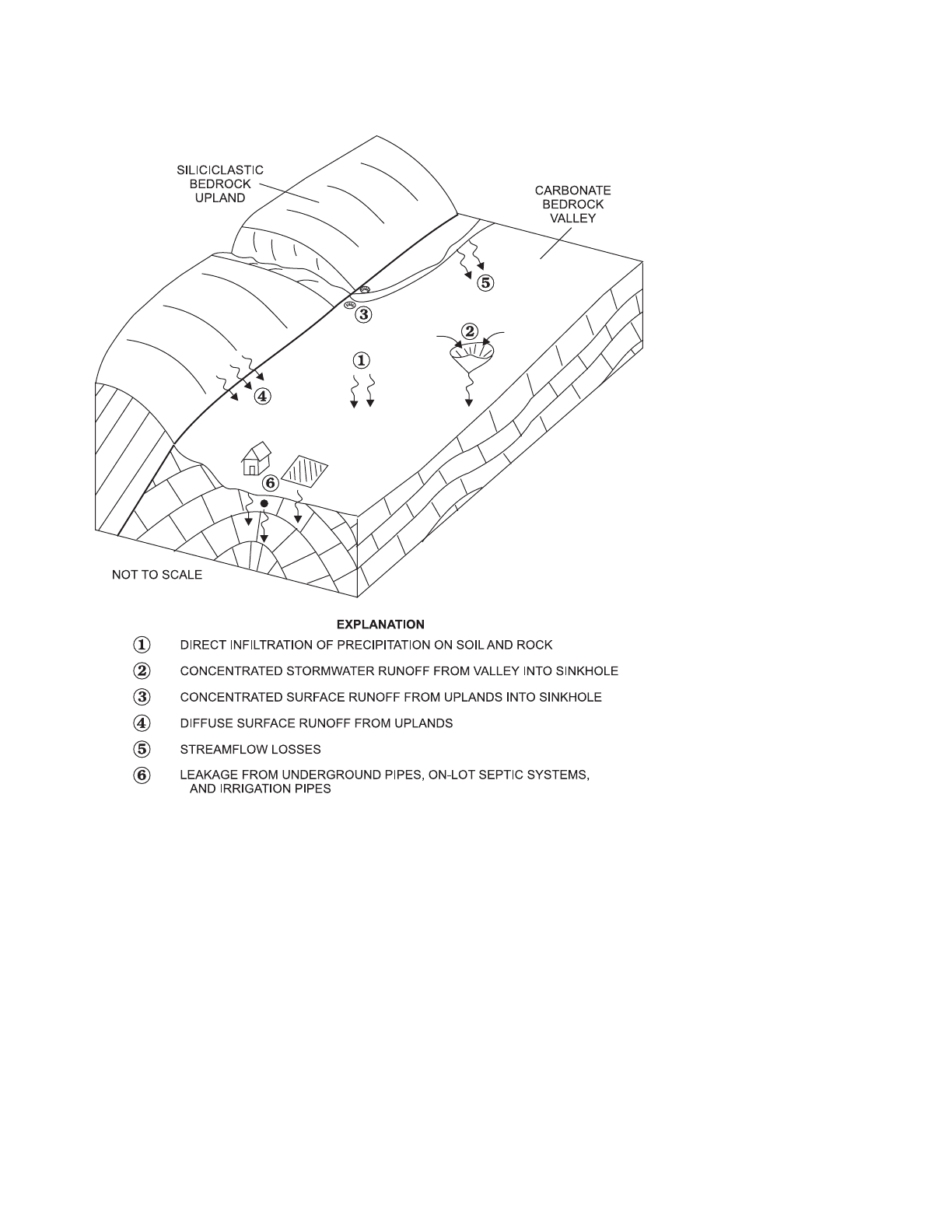
Conceptual Hydrologic Model of Spring Creek Basin 51
Gatesburg Ridge area, where the ground-water divide between
the Spring Creek and Spruce Creek watersheds extends as much
as 5 mi beyond the surface-water divide, but differences also
exist in Penns Valley at the headwaters of Cedar Run and along
the northeastern part of Nittany Valley (fig. 25). The area
between the Spring Creek surface-water and ground-water
divides in the Gatesburg Ridge area is termed the “extended
ground-water basin” in this report.
Conceptually, within the extended ground-water basin,
ground water will contribute to the water budget of Spring
Creek Basin but streams will convey water to the Spruce Creek
Basin. Surface water lost as infiltration through the streambed
presumably becomes ground-water recharge to the Spring
Creek Basin (fig. 29). The reverse is true for areas such as Penns
Valley, where the surface-water divide extends beyond the
ground-water divide. The budgeting of water in these areas is
further complicated by the fact that the ground-water divides
are not stationary, because they are influenced by pumping and
natural climatic changes. The differences in the positions of
ground-water divides mapped in 1969 and 1994 may be an
example of the variability of the divide location (fig. 19) but
also might be the result of the limited data available for contour-
ing in 1969 compared to 1994. Regardless, hydrologic bound-
aries in the extended ground-water basin and in other parts of
the valley need to be conceptualized as variable with respect to
location and flux. Numerical models of the hydrologic system
would need to include parts of Spruce Creek watershed to sim-
ulate the dynamic ground-water/surface-water relation in the
carbonate-bedrock valley.
The base of the Spring Creek Basin within the carbonate-
bedrock valley is conceptualized as a no-flow boundary at the
depth of active ground-water flow, as indicated by the depth
that permeability has been enhanced by weathering. The depth
of the weathering zone in the bedrock may extend to more than
Figure 27. Conceptualized major
sources of ground-water recharge to
the carbonate-bedrock valley.
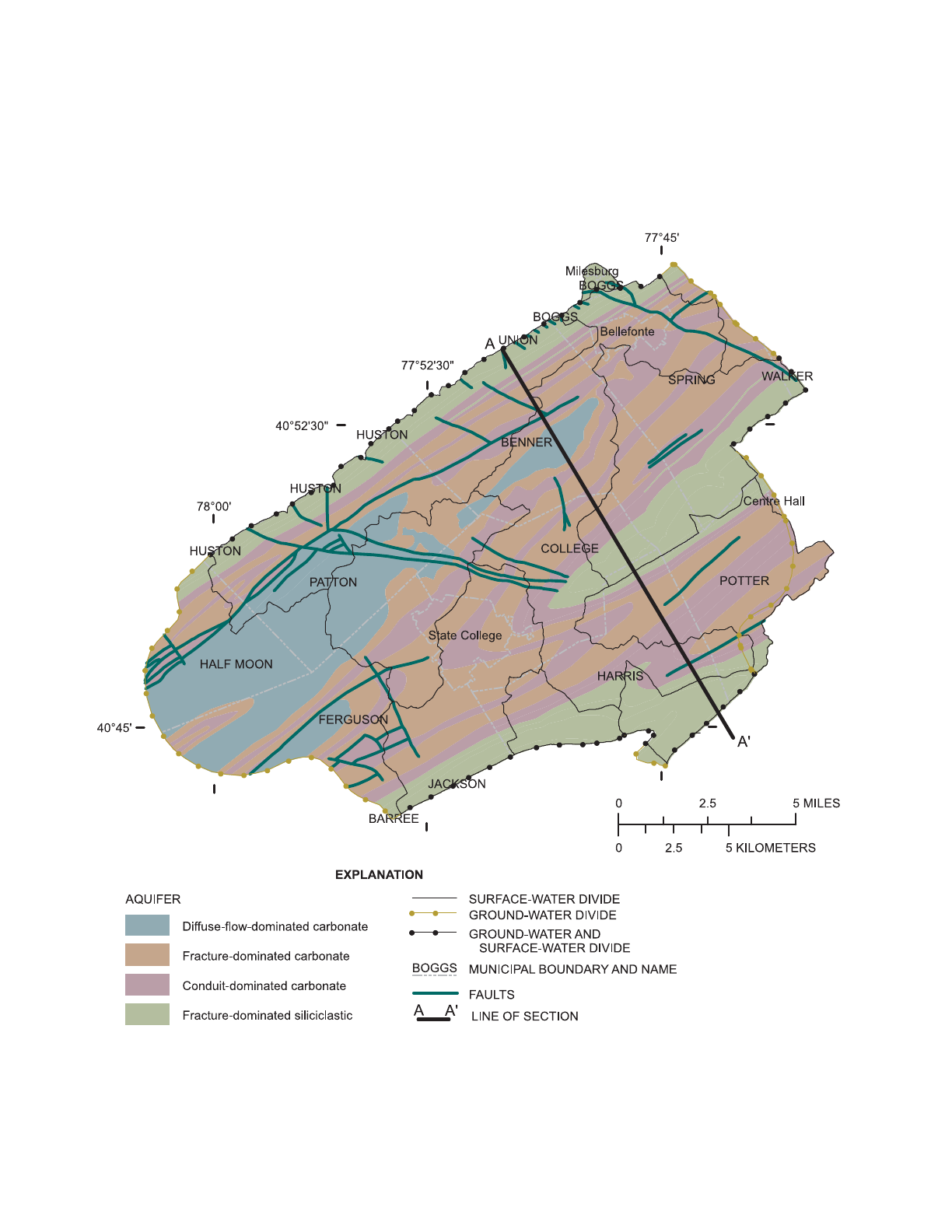
52 Hydrogeologic Setting and Conceptual Hydrologic Model of the Spring Creek Basin, Centre County, Pennsylvania
Figure 28. Generalized aquifer types in the Spring Creek Basin, Centre County, Pennsylvania (modified after Parizek and others,
1971; Parizek, 1984).
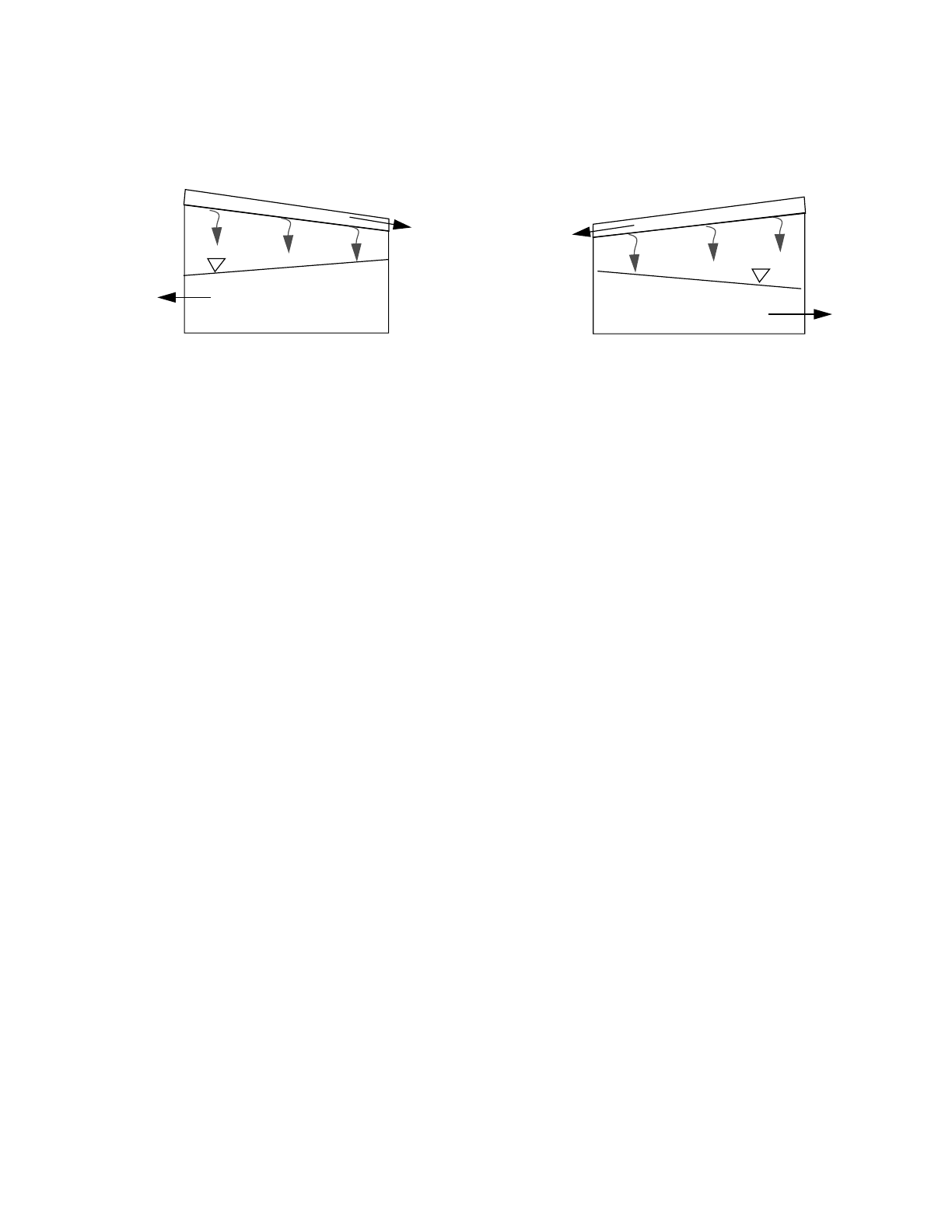
Conceptual Hydrologic Model of Spring Creek Basin 53
500 ft in the carbonate-bedrock aquifers in the study area. Inter-
granular and vugular permeability within the Gatesburg Forma-
tion potentially extends thousands of feet below the valley
(Parizek and others, 1971, p. 98). Conceptually, a lower bound-
ary between 500 and 1,000 ft. would most likely include most
of the active ground-water flow in the Spring Creek Basin.
Surface Water
Streamflow is sustained in Spring Creek and its major trib-
utaries in the carbonate-bedrock valley mostly by ground-water
discharge from the carbonate-bedrock aquifer. This is indicated
by base flow in Spring Creek at Milesburg, which averages
about 87 percent of streamflow. Ground-water discharge occurs
at several large springs (fig. 20) and along stream channels as
innumerable small springs and seeps. Because of the large
ground-water contribution to streamflow, the discharge and
quality of streamflow is controlled to a great extent by the
ground-water-flow system of the carbonate-bedrock aquifer.
Direct runoff may contribute to the streamflow hydrograph
during intense storms (or periods of rain on frozen ground or
snow) when precipitation rates exceed the infiltration capacity
on partial source areas. Direct runoff will develop mostly in
developed areas where impervious cover is prevalent such as
State College, Bellefonte, Centre Hall, and Milesburg or in
areas where soils are thin or have low infiltration capac-
ity—such as the Hagerstown-Opequon-Hublersburg, Murrill,
and Opequon-Hagerstown soil groups, which are present in Nit-
tany and Penns Valleys.
Ground Water
The carbonate-bedrock valley is underlain by approxi-
mately 6,000 to 8,000 ft of interbedded limestone and dolomite
that has been altered to differing degrees by dissolution along
bedding planes, high-angle fractures, and faults. The carbonate-
bedrock aquifers have been conceptualized according to the
nature of the openings creating permeability as described by
Parizek and others (1971) and Parizek (1984). On this basis,
three generalized aquifer types were delineated in the Spring
Creek Basin—(1) diffuse-flow-dominated carbonate, (2) frac-
ture-dominated carbonate, and (3) conduit-dominated carbon-
ate (fig. 28). The intergranular and conduit permeabilities serve
as end-members of the permeability conditions in the carbonate
rocks, and the fracture-dominated rocks represent a degree of
permeability between the two end-members. The three aquifer
types are capable of providing large quantities of ground water
to wells. The carbonate-rock aquifer types are composed mostly
of limestones and dolomites overlain in some areas with collu-
vial and alluvial deposits.
The distribution of generalized aquifer types is shown in
figures 28 and 30. The diffuse-flow-dominated carbonate aqui-
fer type includes the upper sandy member, Ore Hill Member,
and lower sandy member of the Gatesburg Formation. The
upper sandy member of the Gatesburg Formation has sandy
beds, vugs, and some fractures. The fracture-dominated carbon-
ate aquifer type includes the dolomite-rich Bellefonte and Nitt-
any Formations and the Mines Member of the Gatesburg For-
mation. Ground water moves predominately through fractures
that may be more or less interconnected depending on location.
These rocks are similar in terms of their geochemistry, ground-
water yields, and conditions encountered during drilling. Frac-
ture permeability is modified by solution so that fractures aper-
tures range from tenths or hundredths of inches to 0.4 in.
(White, 2003). The matrix porosity of many carbonates is very
low and commonly can be ignored (White, 2003). The conduit-
dominated carbonate aquifer type includes limestones of the
Axeman, Stonehenge, and Coburn through Loysburg Forma-
tions, which contain sinkholes and major networks of caves and
interconnected conduits that favor rapid recharge and move-
ment of ground water. Because limestone and dolomite differ in
solubility, voids in limestone generally are larger than in dolo-
mite and may reach cave proportions in competent, thick-bed-
ded, or shallow-dipping bedrock. Dolomite normally retains a
thicker residual soil cover than limestone, which delays and
dampens the water-table response to precipitation, particularly
water table
streamflow
water table
streamflow
Figure 29. Ground-water/surface-water relations in two areas within the carbonate-bedrock valley where surface-water and
ground-water divides do not coincide, Spring Creek Basin, Centre County, Pennsylvania.
Out to
Spring
Creek
Basin
Out to
Spruce
Creek
Basin
Out to
Spring
Creek
Basin
Out to
Penns
Creek
Basin
EXTENDED GROUND-WATER BASIN
(SPRING CREEK/SPRUCE CREEK)
AB
PENNS VALLEY
(SPRING CREEK/PENNS CREEK)
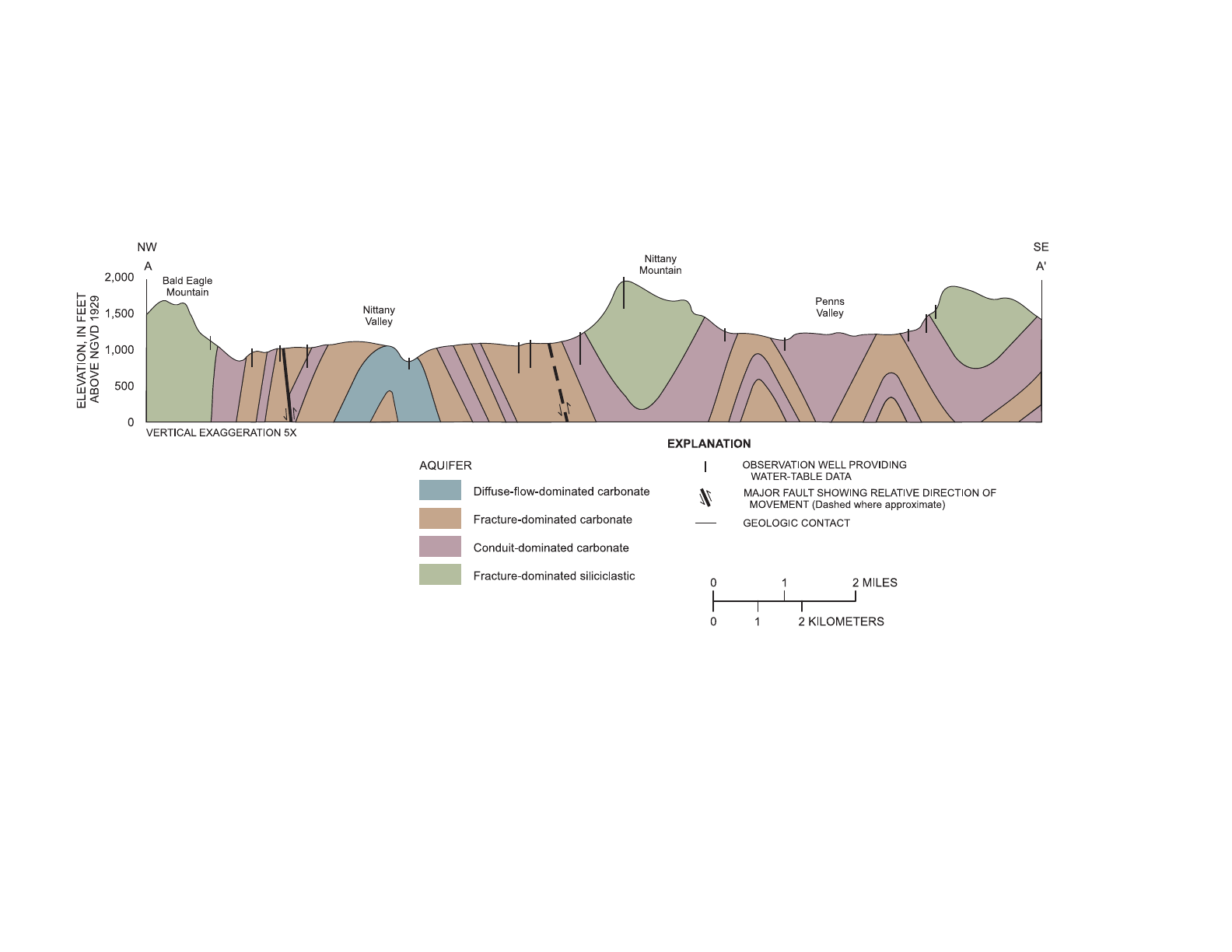
54 Hydrogeologic Setting and Conceptual Hydrologic Model of the Spring Creek Basin, Centre County, Pennsylvania
Figure 30. Geologic cross section A-A’ and generalized aquifer types, Spring Creek Basin, Centre County, Pennsylvania (modified from Giddings, 1974; geology by Butts and
Moore, 1936). Approximate location of section A-A’ is shown on figure 10.

Conceptual Hydrologic Model of Spring Creek Basin 55
in areas underlain by the Gatesburg Formation. Conduits can
range in size from about 0.25 in. to greater than tens of feet.
Hydrologically, they act as storm drains (White, 2003).
The four major aquifer types shown in cross section in fig-
ure 30 are conceptualized in figure 31 as they might be simu-
lated in a numerical model. This illustration shows the basin
represented as a four-layer model, in which each aquifer type is
represented as a model layer. Depending on the magnitude of
the head differences reported within the flow domain, it may be
necessary to subdivide the layers to more accurately simulate
vertical flow gradients. Also, additional information regarding
the hydrogeologic framework (including vertical orientation of
fractures, conduits, and aquifer properties) would be useful for
determining specifically how to best simulate geologic units
and boundary conditions within the Spring Creek Basin.
Ground water in the carbonate-bedrock aquifer is
recharged by differing mechanisms that affect its magnitude,
timing, and chemical characteristics. Six conceptual pathways
for ground-water recharge (after Parizek, 1984) are: (1) direct
infiltration of precipitation into soils and exposed bedrock,
(2) concentrated stormwater runoff from the valley into sink-
holes, (3) concentrated surface runoff from uplands into sink-
holes, (4) diffuse surface runoff from uplands, (5) streamflow
losses from perched or intermittent streams on karst terrain, and
(6) leakage from underground pipes, disposal of on-lot sewage
effluent, and irrigation (fig. 27).
The magnitude of ground-water recharge from all sources
has been estimated from hydrograph separation of the base flow
in Spring Creek. This approach for estimating recharge assumes
that base flow represents ground-water discharge and that
ground-water discharge is a good approximation of recharge.
Base flow for the entire 175 mi
2
Spring Creek Basin averaged
15.1 in. (125 Mgal/d) as computed from the local-minimum
method of hydrograph separation (Pettyjohn and Henning,
1979) using data from 1968 to 2002 at the streamflow-gaging
station Spring Creek at Milesburg, Pa. (01547100). This base
flow is about 87 percent of total streamflow measured at Miles-
burg. Using base flow as a surrogate for recharge may underes-
timate recharge because neither ground-water withdrawals nor
loss of ground water to evapotranspiration were included in the
calculation; however, the ground-water usage was likely not
highly consumptive because the wastewater-treatment plant
serving much of the area discharges back into Spring Creek
above the streamflow-gaging station near Axeman (01546500).
Also, base flow includes contributions from some large conduit
springs that are principally fed by streamflow lost into sink-
holes. Thus, water reemerging as springflow may never have
been part of the larger ground-water reservoir beneath the water
table; therefore, base flow may overestimate ground-water
recharge by an amount equal to the conduit springflow.
Runoff from the siliciclastic-bedrock uplands that partly
bound the Spring Creek Basin is a major source of recharge to
the carbonate-rock aquifers in the valley. Konikow (in Parizek
and others, 1971, p. 83) showed that runoff lost to sinkholes
from the uplands equaled about 33 percent of the flow of Spring
Creek during his study. Parizek (1984, p. 13) estimated that 50
to 60 percent of recharge to carbonate aquifers is from moun-
tain runoff. Conceptually, all of this apparent recharge may not
truly serve as recharge to the aquifer, but much of it may travel
rapidly through a conduit system above the water table—never
becoming recharge to the main ground-water reservoir of the
valley. Some recharge to the main ground-water reservoir of the
carbonate-bedrock valley is contributed from mountain runoff,
but the amount is unknown.
The general direction of ground-water movement can be
inferred from maps of Giddings (1974), Wood (1980), and Tay-
lor (1997) showing the configuration of the water table in the
Spring Creek Basin (figs. 19 and 25). Ground water flows from
the siliciclastic-bedrock uplands into the valley, generally
towards Spring Creek, and to the surface-water drainage low
point at the confluence of Spring Creek with Bald Eagle Creek
at Milesburg, Pa. Ground water from the southwestern part of
the valley in the ground-water extended basin (Gatesburg Ridge
area) flows to the northeast toward Bellefonte and Milesburg.
Structural geologic features may complicate any conceptu-
alization of ground-water movement by adding an unknown
degree of anisotropy (preferential direction of flow) parallel to
the strike of the carbonate-bedrock aquifers. Ground-water
flow, especially within the fracture-dominated and conduit-
dominated aquifers is altered by structural controls and second-
ary permeability features such as solution-enlarged fractures,
joints, and sinkholes. These features, and regional structures
such as the Birmingham Thrust Fault, enhance ground-water
movement parallel to strike and valley alignment. Ground-
water flow across the strike of beds is conceptualized as local-
ized along cross-cutting fracture zones, joints, and high-angle
faults.
The Birmingham Thrust Fault and solution channels
aligned with the base of the mountain ridges have been concep-
tualized as structures that influence regional ground-water flow
(Giddings, 1974). A regional ground-water trough has been
documented along and in the vicinity of the Birmingham Thrust
Fault (Parizek and others, 1971; Giddings, 1974). The Birming-
ham Thrust Fault, along with minor faults, controls the ground-
water-flow rates and the location of large springs. The effects of
the fault and other fracture traces add to the degree of anisot-
ropy in the flow regime. The very deep water table in the Gates-
burg Formation is the result of the development of solution con-
duits along the zone of the Birmingham Thrust Fault (fig. 10)
and underdrainage in dissolution-enhanced sandy bedrock
units.
Ground-water discharges from the carbonate-bedrock
aquifer to streams, springs, wells, and as evapotranspiration to
riparian vegetation. Little ground water is expected to leave the
basin as underflow because of the constriction caused by the
water gap at the outlet of the basin near Milesburg. Most ground
water discharges to streams and springs. Although withdrawals
from wells within the carbonate-bedrock valley are large and
provide the principal source of water supply, total withdrawals
in 2002 amounted to less than 9 percent of the base flow of
Spring Creek at Milesburg.
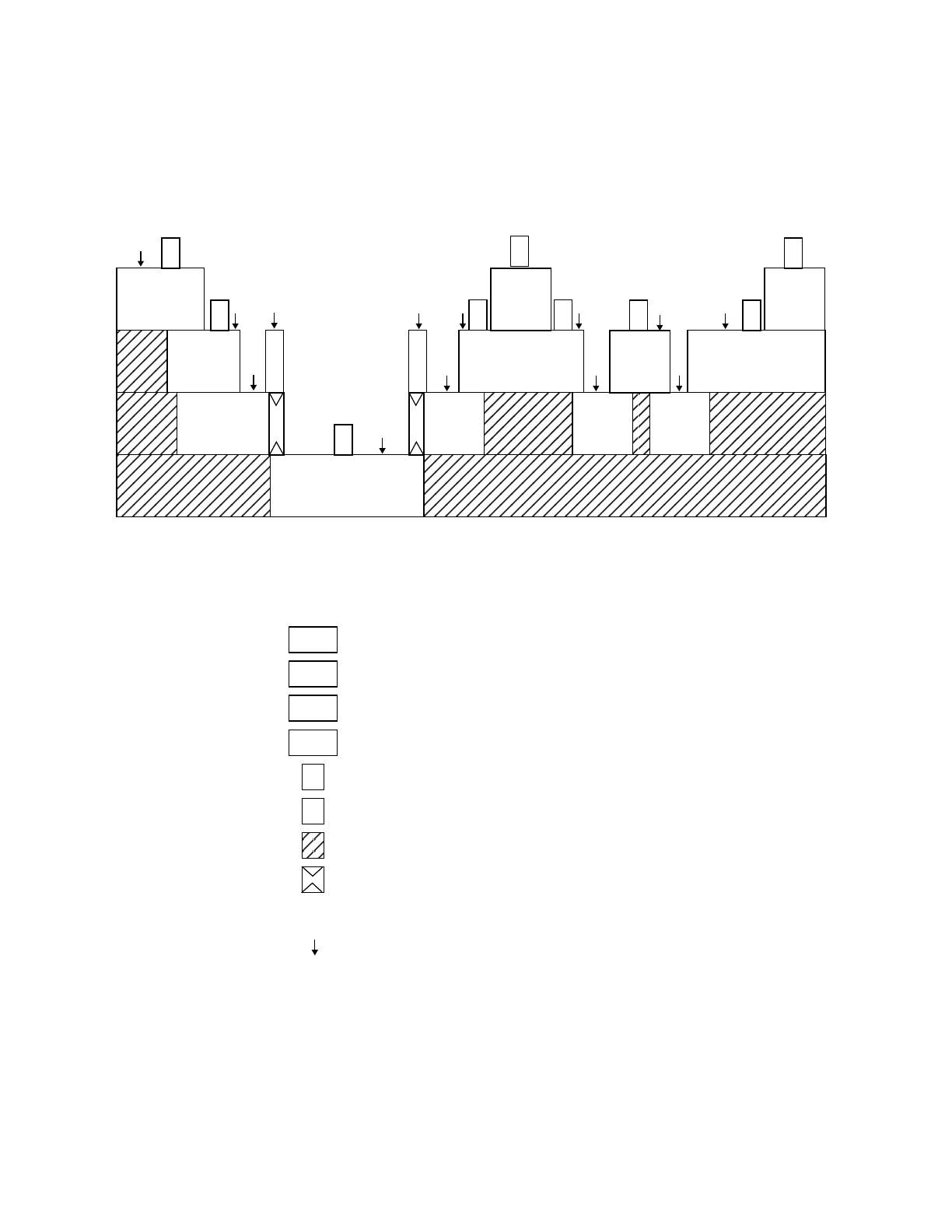
56 Hydrogeologic Setting and Conceptual Hydrologic Model of the Spring Creek Basin, Centre County, Pennsylvania
Figure 31. Schematic diagram of cross-valley section in the Spring Creek Basin. (Units not to scale. All outcrop units not
represented. Aquifers could be subdivided to represent vertical flow.)
CDCA
DDCA
R
R
R
R
FDCAFDCA
FDCA
CDCA
C
D
C
A
C
D
C
A
R
D
FDSA
DD
D
CDCA CDCA
FDSA
FDSA
FDCA
X
X
X
X
X
X
X
X
X
X
X
X
X
X
Bald Eagle
Mountain
Nittany
Mountain
T
ussey
Mountain
X X X X X X X X X X X X X X X X X X X X X X X X X X
FRACTURE-DOMINATED SILICICLASTIC AQUIFER
FDSA
CONDUIT-DOMINATED CARBONATE AQUIFER
CDCA
FRACTURE-DOMINATED CARBONATE AQUIFER
FDCA
DIFFUSE-FLOW-DOMINATED CARBONATE AQUIFER
DDCA
RIVER WITH STREAMBED LEAKAGE
R
DRAIN (SPRINGS)
D
AQUIFER NOT PRESENT OR NOT REPRESENTED
DIRECT HYDRAULIC CONNECTION, INTERVENING
UNIT NOT REPRESENTED
X
NO FLOW
RECHARGE
EXPLANATION

Suggestions for Future Work 57
Suggestions for Future Work
Based on the information collected to date, a number of
data gaps exist and would need to be addressed prior to devel-
opment of a numerical model. In this section, additional data-
collection needs are identified, and tasks are listed to further
define the interaction of surface water and ground water within
the basin.
1. Acquire paper or electronic form of well ID, latitude, lon-
gitude, and water-level elevation for the SRBC Spring
Creek data set.
2. Collect additional transmissivity and storage data,
particularly for mountain ridges. Some data from
Siddiqui (1969) cannot be located or are insufficient for
use.
3. Develop anisotropy values for bedrock units and bedrock
settings.
4. Investigate how transmissivity values have been
determined and select optimal values.
5. Review specific capacity and well-productivity results,
analysis of hydrogeologic boundaries, image-well
analysis, and anisotropic effects.
6. Obtain additional pumping data from 1994 to present
from all sources.
7. Determine values of hydraulic conductivity based on
available transmissivity data.
8. Determine if other major springs exist in addition to those
listed in Saad and Hippe (1990).
9. Confirm base-flow estimates from Spring Creek at
Milesburg streamflow-gaging station from 1994 to 2003.
10. Collect synoptic water levels from wells within the basin
representative of low- and high-base flow; reference
water-level data to the formation where the screen/open
hole is located.
11. Determine whether it is necessary to obtain the water-
level data collected in 1969 and 1994 and plot using
geostatistics (kriging); errors in converting the map
image to an electronic form may contain spatial errors.
12. Collect synoptic spring-flow data during low and high
base flow.
13. Prepare structural contour maps and hydrogeologic cross
sections illustrating the surface and base elevations for
each of the aquifer types reported for the basin. The
information could be used to better define the geometry
and spatial variability of the stratigraphic units within the
basin.
14. The importance of accurate spatial representation of
precipitation events cannot be overstated. Radar-derived
estimates of precipitation offer the best available data for
achieving the desired accuracy. However, available data
are limited to the period April 1995 to the present. In
addition, these data, which show about 35 percent
missing values, appear to lack continuity. It is not known
whether additional unprocessed data may be available to
resolve the missing data problem.
15. Snowfall data is available for the meteorological data-
collection stations listed in table 3, but radar-derived
estimates of snowfall are considered unreliable.
Snowpack depths and water equivalents are valuable for
calibrating the snowmelt process in a hydrologic model.
Snowpack depth data appear to be limited to reports from
four of the stations listed in table 3 (Clarence, Millheim,
Philipsburg 8 E, and State College). Water equivalents
for the snowpack data are not supplied. The areal extent
of a snowpack is also of value for model calibration. No
data on the areal extent of snowcover has been located.
16. Solar-radiation data from the immediate basin area is not
available for the period 1985 to 1998. The closest solar
data-collection station for this time period is near
Williamsport, Pa. The quality of the pre-1985 data
currently is unknown and may impact its usefulness;
however, values could be generated using a NOAA
weather-generator model.
17. An annual average pan evaporation coefficient is
available for the area (Farnsworth and others, 1982) but
monthly coefficients that factor in seasonal variation
would be preferred.
Summary and Conclusions
This study, which was conducted in cooperation with
ClearWater Conservancy, was undertaken to (1) compile base-
line data needed to assess the effects of rapid growth and devel-
opment on the high-quality water resources of Spring Creek
Basin, and (2) lay the groundwork needed to create a decision
tool that could be transferred to other basins. The Spring Creek
Basin lies entirely within Centre County and includes all or part
of the Boroughs of Bellefonte, Centre Hall, Milesburg, and
State College. The Spring Creek surface-water basin is approx-
imately 146 mi
2
in size, but its ground-water basin extends
beyond the surface-water basin and encompasses a larger
area—about 175 mi
2
. The ground-water-flow system is espe-
cially important in the Spring Creek Basin, because ground
water is the source of most water supplies and it sustains the
high-quality cold-water streamflow in Spring Creek.
This report describes the characteristics of the Spring
Creek Basin and includes the following: a compilation of avail-
able climatological, physiographic, geologic, and hydrologic
data; a summary of available water-quantity and quality data;
development of a conceptual hydrologic model for the basin;
and suggestions for additional data collection and other future
work that would enhance the development of a numerical model
for the basin. Available GIS and hydrologic data sets are sum-

58 Hydrogeologic Setting and Conceptual Hydrologic Model of the Spring Creek Basin, Centre County, Pennsylvania
marized in the body of the report and are provided in electronic
format as appendixes. The data presented could be used as base-
line data for development of predictive hydrologic models of
the basin that could serve as prototype models for other basins
in similar hydrogeologic settings.
The Spring Creek Basin is conceptualized as consisting of
two principal hydrologic settings—a forested, siliciclastic-bed-
rock upland and a carbonate-bedrock valley with agricultural
and urban land use. The two settings differ in physiography,
geology, and land use, but are linked hydrologically by runoff
and ground-water discharge from the uplands, which provides
streamflow and ground-water recharge to the valley. The silici-
clastic-bedrock uplands of Ordovician and Silurian age form
the physical and hydrologic boundaries of the Spring Creek
Basin along its northwestern and southeastern margins. The car-
bonate-bedrock valley is underlain by limestones and dolomites
of Ordovician age that have been variously folded, fractured,
and dissolved to produce highly productive aquifers. Within the
carbonate-bedrock valley, hydrologic boundaries of ground-
water and surface-water systems are not coincident everywhere
and ground-water divides may vary with changes in recharge
and pumping. The base of active ground-water flow in the
Spring Creek Basin is not well known, but based on depth of
weathering, a lower boundary between 500 and 1,000 ft. would
likely include most of the active ground-water flow in the
Spring Creek Basin.
The bedrock aquifers have been conceptualized according
to lithology and the nature of the openings creating permeability
as: (1) diffuse-flow-dominated carbonate, (2) fracture-domi-
nated carbonate, (3) conduit-dominated carbonate, and (4) frac-
ture-dominated siliciclastic aquifers. Recharge to the carbon-
ate-bedrock aquifer occurs along one of six conceptual
pathways (after Parizek, 1984): (1) direct infiltration of precip-
itation into soils and exposed bedrock; (2) concentrated storm-
water runoff from the valley into sinkholes; (3) concentrated
surface runoff from uplands into sinkholes; (4) diffuse surface
runoff from uplands; (5) streamflow losses from perched or
intermittent streams on karst terrain; and (6) leakage from
underground pipes, disposal of on-lot sewage effluent, and irri-
gation. Ground water discharges to streams, springs, wells, and
as evapotranspiration to riparian vegetation. Discharge to
springs and streams accounts for about 87 percent of the
streamflow of Spring Creek at Milesburg.
Suggestions for additional data collection and other future
work are provided that would enhance the development of
hydrologic simulation models of the Spring Creek Basin. For
example, collection of additional data would be needed to
define aquifer properties, additional synoptic stream and
spring-flow measurements would be needed for model calibra-
tion, and radar-derived precipitation estimates would be needed
to provide the best possible spatial distribution of precipitation.
These suggested efforts would help refine the conceptual under-
standing of the basin and would likely increase the accuracy of
hydrologic simulation models.
Acknowledgments
The Project Management Team (PMT) for this effort
includes groups that either contributed support or provided
some form of in-kind service. The PMT includes Centre County
Office of Planning, ClearWater Conservancy, Pennsylvania
Department of Environmental Protection, Pennsylvania State
University-Office of Physical Plant, State College Borough
Water Authority, University Area Joint Authority, and the U.S.
Geological Survey. The project is part of a Growing Greener
Grant awarded to ClearWater Conservancy by the Pennsylvania
Department of Environmental Protection.
We would like to thank the following groups and individ-
uals for contributing to the success of this study:
Bellefonte Borough, Centre County Office of Planning,
ClearWater Conservancy, Pennsylvania Department of
Environmental Protection, Pennsylvania State University-
Office of Physical Plant, State College Borough Water
Authority, and University Area Joint Authority.
Members of the Technical Steering Committee and peer
reviewers including Bob Crum, Bob Donaldson, Walter
Ebaugh, Barry Evans, Randy Farmerie, Larry Fennessey,
Chris Finton, John Gaudlip, Matt Genchur, Todd
Giddings, Max Gill, Bob Jacobs, Cory Miller, Mark
Ralston, Ralph Stewart, Steve Suder, Beth Thoma, Will
White, and Dave Yoxtheimer.
References Cited
Anderson, M.P., and Woessner, W.W., 1992, Applied ground-
water modeling—Simulation of flow and advective
transport: Academic Press, 381 p.
Berg, T.M., Edmunds, W.E., Geyer, A.R., and others, 1980
Geologic map of Pennsylvania (2nd ed.): Pennsylvania Geo-
logical Survey Map #1, scale 1:250,000, 2 sheets.
Braker, W.L., 1981, Soil survey of Centre County,
Pennsylvania: U.S. Department of Agriculture, Soil Conser-
vation Service, 162 p.
Butts, C., and Moore, E.S., 1936, Geology and mineral
resources of the Bellefonte Quadrangle, Pa.: U.S. Geologi-
cal Survey Bulletin 855, 111 p.
Caruccio, F.T., 1963, The hydrology of the sewage disposal
experiment area, northwest of State College,
Pennsylvania: University Park, Pa., The Pennsylvania State
University, M.S. thesis, 132 p.
Clark, J.H., 1965, The geology of the Ordovician carbonate for-
mations in the State College, Pennsylvania, area and their
relationships to the general occurrence and movement of
ground water: University Park, Pa., The Pennsylvania State
University, M.S. thesis, 114 p.
Commonwealth of Pennsylvania, 2001, Pennsylvania Code,
Title 25. Environmental Protection, Chapter 93, Water qual-
ity standards: Harrisburg, Pa., Department of Environmental
Protection, 226 p.

References Cited 59
Commonwealth of Pennsylvania, Fish and Boat Commission,
2005, 2005 Class A wild trout waters: Harrisburg, Pa.,
accessed July 20, 2005, at http://www.fish.state.pa.us.
Cornell University, Soil and Water Laboratory, 2005, Variable
source area hydrology: accessed April 25, 2005, at
http://www.bee.cornell.edu/swlab/SoilWaterWeb/research/
VSA/index.html
Donaldson, A.C., 1959, Stratigraphy of Lower Ordovician
Stonehenge and Larke Formations in Central
Pennsylvania: University Park, Pa., The Pennsylvania State
University, Ph.D. dissertation, 393 p.
Experimental Climate Prediction Center, 2005, GCIP Water
and energy budget synthesis (WEBS)—Physiography:
accessed April 25, 2005, at http://ecpc.ucse.edu/gcip/html/
chap2.htm
Farnsworth, R.K., Thompson, E.S., and Peck, E.L., 1982, Evap-
oration atlas for the contiguous 48 United States: National
Oceanic and Atmospheric Administration Technical Report
NWS 33, 26 p., 4 pl.
Flueckinger, L.A., 1967, Geology of a portion of the Allensville
15' Quadrangle, Pennsylvania: University Park, Pa., The
Pennsylvania State University, M.S. thesis, 69 p.
Folk, R.L., 1952, Petrology and petrography of the lower
Ordovician Beekmantown carbonate rocks in the vicinity of
State College, Pennsylvania: University Park, Pa., The
Pennsylvania State University, Ph.D. dissertation, 366 p.
Freeze, R.A., and Cherry, J.A., 1979, Groundwater:
Englewood Cliffs, N.J., Prenctice-Hall, Inc., 604 p.
Gannett Flemming, Inc., 2000, Spring Creek Watershed Sur-
face and Groundwater Boundary Map.
Giddings, M.T., 1974, Hydrologic budget of Spring Creek
Drainage Basin, Pennsylvania: University Park, Pa., The
Pennsylvania State University, Ph.D. dissertation, 76 p.,
2 pls., 13 figs.
Giddings and Associates, Inc., 1995, Validation, applications,
and predictions of the Bald Eagle Deep Mine ground-water
flow model: Todd Giddings and Associates, Inc., 55 p.
Kochanov, W.E., 1992, Sinkholes and karst-related features of
Centre County, Pennsylvania: Pennsylvania Geological Sur-
vey, Open-File Report 92-01, 8 p., 15 maps.
Konikow, L.F., 1969, Mountain runoff and its relation to pre-
cipitation, groundwater and recharge to the carbonate aqui-
fers of Nittany Valley, Pennsylvania: University Park, Pa.,
The Pennsylvania State University, M.S. thesis, 128 p.
Kontis, A.L., Randall, A.D., and Mazzaferro, D.L., 2004,
Regional hydrology and simulation of flow of stratified-drift
aquifers in the glaciated northeastern United States: U.S.
Geological Survey Professional Paper 1415-C, 156 p.
Landon, R.A., 1963, The geology of the Gatesburg Formation
in the Bellefonte Quadrangle, Pennsylvania, and its relation-
ship to general occurrence and movement of ground
water: University Park, Pa., The Pennsylvania State Univer-
sity, M.S. thesis, 88 p.
Lattman, L.H., and Parizek, R.R., 1964, Relationship between
fracture traces and the occurrence of ground water in carbon-
ate rocks: Journal of Hydrology, v. 2, p. 73-91.
Meiser, E.W., 1971, The geology and water resources of the
Bellefonte-Mingoville area, Pennsylvania: University Park,
Pa., The Pennsylvania State University, M.S. thesis, 113 p.
Miller, D.A., and White, R.A., 1998, A conterminous United
States multi-layer soil characteristics data set for regional cli-
mate and hydrology modeling: Earth Interactions, v. 2, no. 2,
p. 1-26.
National Weather Service, 2002, About the stage III
data: accessed May 8, 2003, at http://www.nws.noaa.gov/oh/
hrl/dmip/stageiii_info.htm
National Weather Service, 2005, Automated Flood Warning
System: Integrated Flood Observing and Warning System of
the National Weather Service, accessed August 27, 2005, at
http://www.afws.net/.
National Oceanic and Atmospheric Administration, 2003,
Climatology: National Weather Service, Middle Atlantic
River Forecast Center, accessed June 9, 2003,
at http://www.erh.noaa.gov/marfc/Climatology/index.htm.
National Oceanic and Atmospheric Administration, 2005,
Hydrometeorological Design Studies Center: Office of
Hydrologic Development, accessed August 27, 2005, at
http://dipper.nws.noaa.gov/hdsb/hdat/rfc_data.html.
Natural Resources Conservation Service, 2003: accessed May
8, 2005, at http://www.wcc.nrcs.usda.gov/scan/
site.pl?sitenum=2036&state=pa.
Nittany Geoscience Inc., 1988a, Hydrogeologic report: State
College Borough Water Authority Well Field No. 5 at Cir-
cleville, State College Borough Water Authority, 102 p.
Nittany Geoscience Inc., 1988b, State College Borough Water
Authority Well Field 5 at Circleville, Status Report, State
College Borough Water Authority, 28 p.
Nittany Geoscience, Inc., 1989, Fracture-trace analysis of ten
potential well-field areas in the Centre Region: State Col-
lege, Pa., State College Water Authority, 47 p.
Nittany Geoscience Inc., 1990, Hydrogeologic report, State
College Borough Water Authority well field 6 at Filmore
area, Benner Township, Pennsylvania, State College Bor-
ough Water Authority, 92 p.
Nittany Geoscience Inc., 1991a, Hydrogeologic report, State
College Borough Water Authority well field 2 at Grays
Woods, Halfmoon Township, Pennsylvania, 39 p.
Nittany Geoscience Inc., 1991b, Hydrogeologic report, State
College Borough Water Authority well 24 in the Harter well
field, Shingletown region, Harris Township, Pennsylvania,
12 p.
Nittany Geoscience Inc., 1991c, Hydrogeologic report for State
College Borough Water Authority well 22 in the Harter well
field, Shingletown region, Harris Township, Pennsylvania,
12 p.
Nittany Geoscience Inc., 1992a, Determination of wellhead
protection areas for the State College Borough Water
Authority Nixon well field, State College, Pennsylvania,
17 p.

60 Hydrogeologic Setting and Conceptual Hydrologic Model of the Spring Creek Basin, Centre County, Pennsylvania
Nittany Geoscience Inc., 1992b, Hydrogeologic report State
College Borough Water Authority well field 7 at the Kocher
property, Ferguson Township, Centre County, Pennsylvania,
53 p.
Parizek, R.R., 1978, Ground-water pollution potential from
land use adjacent to the Harter Well Field, Borough of State
College Water Authority, Consulting Hydrogeologist, 23 p.
Parizek, R.R., 1984, Pollution potential of aquifers within the
Centre Region, Centre County, Pennsylvania – Working ele-
ment 2:State College, PA, report submitted to the Centre
Regional Planning Commission, 71 p.
Parizek, R.R., 2000, Evaluation of well construction, produc-
tion testing, and water quality analysis for the Pennsylvania
State University Supply Well UN-14, Patton Township,
Centre County, Pennsylvania: Pennsylvania State Univer-
sity, 100 p.
Parizek, R.R., and Drew, L.J., 1966, Random drilling for water
in carbonate rock—Proceedings of a symposium and short
course on computers and operations research in mineral
industries: University Park, Pa., Mineral Industries Experi-
ment Station, v. 3, (Special Publication 2-65), The Pennsyl-
vania State University, p. 1-22.
Parizek, R.R., White, W.B., and Langmuir, Donald, 1971,
Hydrogeology and geochemistry of folded and faulted car-
bonate rocks of the central Appalachian type and related land
use problems: Pennsylvania State University Circular 82.
Pelto, C.R., 1942, Petrology of the Gatesburg Formation of cen-
tral Pennsylvania: University Park, Pa., The Pennsylvania
State University, M.S. thesis, 60 p.
Pennsylvania Department of Environmental Protection, 2003:
accessed January 15, 2004, at http://www.dep.state.pa.us/
dep/deputate/watermgt/WC/Subjects/WSNoteBks/ws09c.htm
Pennsylvania State Climatologist, 2003: University Park, Pa.,
Pennsylvania State University College of Earth & Mineral
Sciences, accessed June 24, 2003, at http://pasc.met.psu.edu/
PA_Climatologist/fod/index.html
Pennsylvania State Climatologist, 2005, Interactive data
archive: University Park, Pa., Pennsylvania State University
College of Earth & Mineral Sciences, accessed at
http://pasc.met.psu.edu/IA/.
Pennsylvania State Climatologist, 2005, State College,
Pa.: University Park, Pa., Pennsylvania State University
College of Earth & Mineral Sciences, accessed July 20, 2005,
at http://climate.met.psu.edu/data/city/cityhome.php.
Pennsylvania State University, 2005, Weather station:
University Park, Pa., Department of Meteorology, accessed
August 27, 2005, at http://bub2.meteo.psu.edu/WXSTN/
wxstn.htm.
Pettyjohn, W.A., and Henning, Rodger, 1979, Preliminary esti-
mate of ground-water recharge rates, related streamflow, and
water quality in Ohio: Ohio State University Resources
Center Project Completion Report 552, 323 p.
Rauch, H.W., 1972, The effects of lithology and other hydro-
geologic factors on the development of solution porosity in
the middle Ordovician carbonates of central
Pennsylvania: University Park, Pa., The Pennsylvania State
University, M.S. thesis, 530 p.
Rones, M., 1955, A litho-stratigraphic, petrographic and chem-
ical investigation of the Lower- Middle Ordovician and car-
bonate rocks in central Pennsylvania: University Park, Pa.,
The Pennsylvania State University, Ph.D. dissertation, 345 p.
Saad, D.A., and Hippe, D.J., 1990, Large springs in the Valley
and Ridge Physiographic Province of Pennsylvania: U.S.
Geological Survey Open-File Report 90-164, 17 p.
Shuster, E.T., and White, W.B., 1971, Seasonal fluctuations in
the chemistry of limestone springs--A possible means for
characterizing carbonate aquifers: Journal of Hydrology,
v. 14, p. 93-128.
Siddiqui, S.H., 1969, Hydrogeologic factors influencing well
yields and aquifer hydraulic properties of folded and faulted
carbonate rocks in central Pennsylvania: University Park,
Pa., The Pennsylvania State University, Ph.D. dissertation,
502 p.
Siddiqui, S.H., and Parizek, R.R., 1971, Hydrogeologic factors
influencing well yields in folded and faulted carbonate rocks
in central Pennsylvania: Water Resources Research, v. 7,
no. 5, p. 1295-1323.
Sloto, R.A., and Crouse, M.Y., 1996, HYSEP—A computer
program for hydrograph separation and analysis: U.S. Geo-
logical Survey Water-Resources Investigations Report 96-
4040, 46 p.
Smith, R.W., 1966, Petrographic properties influencing poros-
ity and permeability in the carbonate-quartz system as repre-
sented by the Gatesburg Formation: University Park, Pa.,
The Pennsylvania State University, Ph.D. dissertation, 196 p.
Taylor, L.E., 1997, Water budget for the Spring Creek
Basin: Harrisburg, Pa., Susquehanna River Basin Commis-
sion Publication 184, 19 p.
Thomson, R.R., 1961, Lithostratigraphy of the Middle Ordovi-
cian Salona and Colburn Formations of the Trenton Group in
central Pennsylvania: University Park, Pa., The Pennsylva-
nia State University, Ph.D. dissertation, 264 p.
Tuttle, O.F., 1939, Petrography and genesis of the Bellefonte
Sandstones: University Park, Pa., M.S. Thesis, The Pennsyl-
vania State University.
U.S. Department of Agriculture, Natural Resources Conserva-
tion Service, 1994, State soil geographic (STATSGO)
database: U.S. Department of Agriculture, accessed June 13,
2005, at http://www.ncgc.nrsc.usda.gov/products/datasets/
STATSGO/.
U.S. Department of Commerce, 2005, Climate data: National
Oceanic and Atmospheric Administration Satellite and Infor-
mation Service, National Climatic Data Center, accessed
August 27, 2005, at http://lwf.ncdc.noaa.gov/oa/climate/
climatedata.html.
U.S. Geological Survey, 1992, National land cover character-
ization project: accessed October 18, 2004, at http://land-
cover.usgs.gov/nationallandcover.asp

References Cited 61
U.S. Geological Survey, 2003, at http://water.usgs.gov/cgi-bin/
man_wrdapp?mf2k.
U.S. Environmental Protection Agency, 2002, Ground water
and drinking water: U.S. Environmental Proection Agency
EPA 816-F-02-013, accessed May 25, 2005,
at http://www.epa.gov/safewater/mcl.html#mcls.
White, W.B., 2003, Conceptual models for karstic
aquifers: Speleogenesis and Evolution of Karst Aquifers, v.
1, no. 1, 2 p., accessed April 25, 2005, at http://www.speleo-
genesis.info
Wood, C.R., 1980, Groundwater resources of Centre
County: Pennsylvania Geological Survey, 4th ser., Water
Resource Report 48, 60 p.

62 Hydrogeologic Setting and Conceptual Hydrologic Model of the Spring Creek Basin, Centre County, Pennsylvania
Table 18. Summary of surface-water quality data through May 2003 for the Spring Creek Basin, Centre County, Pennsylvania.
[n, number of samples; —, no data; <, less than; deg C, degrees Celsius; ft
3
/s, cubic feet per second; µS/cm, microsiemens per centimeter; mg/L, milligrams per
liter; µg/L, micrograms per liter; NTU, Nephelometric turbidity units; Data sources: Spring Creek Watershed Community, period ending February 2002; Penn-
sylvania Department of Environmental Resources, period ending May 2003; U.S. Geological Survey, period ending November 2002]
Constituent or characteristic
Para-
meter
code
Units
Data-collection site name
Lower Buffalo Run Upper Buffalo Run
n
Mini-
mum
Median
Maxi-
mum
n
Mini-
mum
Median
Maxi-
mum
Water temperature 00010 deg C 34 0.3 10.4 20.5 27 0.1 9.4 17.8
Discharge 00060 ft
3
/s — — — — — — — —
Discharge, instantaneous 00061 ft
3
/s — — — — — — — —
Specific conductance 00095 µS/cm — — — — — — — —
Dissolved oxygen 00300 mg/L 34 7.6 11.85 15 26 7 11.25 14.8
Biological oxygen demand 5-day 00310 mg/L — — — — — — — —
pH, field 00400 standard units 32 7.4 8.1 8.6 25 6.9 7.7 8.3
pH, laboratory 00403 standard units — — — — — — — —
Acid neutralizing capacity 00410 mg/L as CaCO
3
—— — — —— — —
Residue, filtered 00515 mg/L — — — — — — — —
Residue, total nonfilterable 00530 mg/L 38 <2 7 46 29 <2 6 84
Nitrogen, total 00600 mg/L as N — — — — — — — —
Ammonia, dissolved 00608 mg/L as N — — — — — — — —
Ammonia, total 00610 mg/L as N — — — — — — — —
Nitrite, total 00615 mg/L as N — — — — — — — —
Nitrite, dissolved 00618 mg/L as N 36 <.04 1.76 2.94 27 <.04 1.34 1.81
Nitrate, total 00620 mg/L as N 38 <.04 1.8 2.43 29 <.04 1.39 1.85
Ammonia + organic nitrogen 00625 mg/L as N — — — — — — — —
Phosphate, total 00650 mg/L as PO
4
—— — — —— — —
Orthophosphate, dissolved 00660 mg/L as PO
4
—— — — —— — —
Phosphorous, total 00665 mg/L as P — — — — — — — —
Orthophosphate, dissolved 00671 mg/L as P 37 <.01 <.01 .028 28 <.01 .012 .031
Organic carbon, total 00680 mg/L as C 38 <1.0 1.3 3.3 29 <1.0 1.4 2.9
Organic carbon, dissolved 00681 mg/L as C 38 <1.0 1.5 5.1 28 <1.0 1.45 2.7
Hardness, total 00900 mg/L as CaCO
3
—— — — —— — —
Calcium, dissolved 00915 mg/L — — — — — — — —
Calcium, total 00916 mg/L — — — — — — — —
Magnesium, dissolved 00925 mg/L — — — — — — — —
Magnesium, total 00927 mg/L — — — — — — — —
Chloride, dissolved 00940 mg/L 38 <1.0 14 22 29 <1.0 20 40
Sulfate, dissolved 00945 mg/L as SO
4
—— — — —— — —
Copper, dissolved 01040 µg/L 38 <4.0 <4.0 10 29 <4.0 <4.0 13
Copper, total 01042 µg/L 38 <4.0 <4.0 10 29 <4.0 <4.0 25
Iron, total 01045 µg/L — — — — — — — —
Iron, dissolved 01046 µg/L — — — — — — — —
Lead, dissolved 01049 µg/L 37 <1.0 <1.0 1 28 <1.0 <1.0 1
Lead, total 01051 µg/L 37 <1.0 <1.0 5.6 28 <1.0 <1.0 5.9
Manganese, total 01055 µg/L — — — — — — — —
Manganese, dissolved 01056 µg/L — — — — — — — —
Nickel, total 01067 µg/L — — — — — — — —
Zinc, dissolved 01090 µg/L 38 <10. <10. 108 29 <10 <10 17
Zinc, total 01092 µg/L 38 <10. <10. 20 29 <10 <10 37
Aluminum, total 01105 µg/L — — — — — — — —
Petroleum hydrocarbons, total 45501 µg/L 36 <5.0 <5.0 7 27 <5.0 <5.0 8.2
Orthophosphate, total 70507 mg/L as P 37 <.01 .014 .047 28 <.01 .02 .081
Nitrate, dissolved 71851 mg/L as NO
3
—— — — —— — —
Suspended sediment 80154 mg/L — — — — — — — —
Turbidity, total, laboratory 82079 NTU 37 <1.0 2.55 11 29 <1.0 2.47 17

Tables 63
Table 18. Summary of surface-water quality data through May 2003 for the Spring Creek Basin, Centre County, Pennsylvania.—Continued
[n, number of samples; —, no data; <, less than; deg C, degrees Celsius; ft
3
/s, cubic feet per second; µS/cm, microsiemens per centimeter; mg/L, milligrams per
liter; µg/L, micrograms per liter; NTU, Nephelometric turbidity units; Data sources: Spring Creek Watershed Community, period ending February 2002; Penn-
sylvania Department of Environmental Resources, period ending May 2003; U.S. Geological Survey, period ending November 2002]
Constituent or characteristic
Para-
meter
code
Units
Data-collection site name
Lower Cedar Run Lower Logan Branch
n
Mini-
mum
Median
Maxi-
mum
n
Mini-
mum
Median
Maxi-
mum
Water temperature 00010 deg C 35 0.4 10.8 20.4 35 7.6 10.9 13.6
Discharge 00060 ft
3
/s — — — — — — — —
Discharge, instantaneous 00061 ft
3
/s — — — — — — — —
Specific conductance 00095 µS/cm — — — — — — — —
Dissolved oxygen 00300 mg/L 35 10.1 11.8 15.4 35 10.1 11.1 13.3
Biological oxygen demand 5-day 00310 mg/L — — — — — — — —
pH, field 00400 standard units 34 7.1 8.1 8.4 33 7.1 7.7 8.3
pH, laboratory 00403 standard units — — — — — — — —
Acid neutralizing capacity 00410 mg/L as CaCO
3
—— — — —— — —
Residue, filtered 00515 mg/L — — — — — — — —
Residue, total nonfilterable 00530 mg/L 38 <2 6 70 36 <2 <2 94
Nitrogen, total 00600 mg/L as N 1 4.97 4.97 4.97 — — — —
Ammonia, dissolved 00608 mg/L as N 1 <.02 <.02 <.02 — — — —
Ammonia, total 00610 mg/L as N 2 <.02 <.02 .02 — — — —
Nitrite, total 00615 mg/L as N 2 <.01 <.01 <.01 — — — —
Nitrite, dissolved 00618 mg/L as N 35 <.04 4.26 5.15 34 <.04 2.74 3.26
Nitrate, total 00620 mg/L as N 39 <.04 4.3 5.41 36 <.04 2.77 3.58
Ammonia + organic nitrogen 00625 mg/L as N — — — — — — — —
Phosphate, total 00650 mg/L as PO
4
—— — — —— — —
Orthophosphate, dissolved 00660 mg/L as PO
4
—— — — —— — —
Phosphorous, total 00665 mg/L as P — — — — — — — —
Orthophosphate, dissolved 00671 mg/L as P 38 <.01 <.01 .018 35 <.01 .013 .043
Organic carbon, total 00680 mg/L as C 38 <1.0 1.1 1.8 36 <1.0 <1.0 1.8
Organic carbon, dissolved 00681 mg/L as C 37 <1.0 1.3 1.9 36 <1.0 <1.0 2.2
Hardness, total 00900 mg/L as CaCO
3
—— — — —— — —
Calcium, dissolved 00915 mg/L — — — — — — — —
Calcium, total 00916 mg/L — — — — — — — —
Magnesium, dissolved 00925 mg/L — — — — — — — —
Magnesium, total 00927 mg/L — — — — — — — —
Chloride, dissolved 00940 mg/L 38 <1.0 14 20 36 <1.0 19.5 26
Sulfate, dissolved 00945 mg/L as SO
4
—— — — —— — —
Copper, dissolved 01040 µg/L 38 <4.0 <4.0 16 36 <4.0 <4.0 10
Copper, total 01042 µg/L 38 <4.0 <4.0 14.5 36 4 4.45 28
Iron, total 01045 µg/L — — — — — — — —
Iron, dissolved 01046 µg/L — — — — — — — —
Lead, dissolved 01049 µg/L 38 <1.0 <1.0 1 35 <1.0 <1.0 1
Lead, total 01051 µg/L 38 <1.0 <1.0 1 35 <1.0 1.1 2.6
Manganese, total 01055 µg/L — — — — — — — —
Manganese, dissolved 01056 µg/L — — — — — — — —
Nickel, total 01067 µg/L — — — — — — — —
Zinc, dissolved 01090 µg/L 38 <10. <10. 12 36 <10 17 70
Zinc, total 01092 µg/L 39 <10. <10. 19 36 <10 20 81
Aluminum, total 01105 µg/L — — — — — — — —
Petroleum hydrocarbons, total 45501 µg/L 37 <5.0 <5.0 12.2 34 <5.0 <5.0 10.3
Orthophosphate, total 70507 mg/L as P 38 <.01 .014 .034 35 <.01 .015 .052
Nitrate, dissolved 71851 mg/L as NO
3
—— — — —— — —
Suspended sediment 80154 mg/L — — — — — — — —
Turbidity, total, laboratory 82079 NTU 37 <1.0 2.25 13.8 35 <1.0 1.43 5.23

64 Hydrogeologic Setting and Conceptual Hydrologic Model of the Spring Creek Basin, Centre County, Pennsylvania
Table 18. Summary of surface-water quality data through May 2003 for the Spring Creek Basin, Centre County, Pennsylvania.—Continued
[n, number of samples; —, no data; <, less than; deg C, degrees Celsius; ft
3
/s, cubic feet per second; µS/cm, microsiemens per centimeter; mg/L, milligrams per li-
ter; µg/L, micrograms per liter; NTU, Nephelometric turbidity units; Data sources: Spring Creek Watershed Community, period ending February 2002; Pennsyl-
vania Department of Environmental Resources, period ending May 2003; U.S. Geological Survey, period ending November 2002]
Constituent or characteristic
Para-
meter
code
Units
Data-collection site name
Upper Logan Branch Lower Slab Cabin Run
n
Mini-
mum
Median
Maxi-
mum
n
Mini-
mum
Median
Maxi-
mum
Water temperature 00010 deg C 34 5.9 13.1 20.1 36 1.5 12.1 24.9
Discharge 00060 ft
3
/s —— — — —— — —
Discharge, instantaneous 00061 ft
3
/s —— — — —— — —
Specific conductance 00095 µS/cm — — — — — — — —
Dissolved oxygen 00300 mg/L 34 8.2 10.25 13.6 36 6.8 11.75 16.5
Biological oxygen demand 5-day 00310 mg/L — — — — — — — —
pH, field 00400 standard units 32 7.1 7.8 8.2 34 7.1 7.8 8.3
pH, laboratory 00403 standard units — — — — — — — —
Acid neutralizing capacity 00410 mg/L as CaCO
3
—— — — —— — —
Residue, filtered 00515 mg/L — — — — — — — —
Residue, total nonfilterable 00530 mg/L 38 <2 4 66 40 <2 3 72
Nitrogen, total 00600 mg/L as N — — — — — — — —
Ammonia, dissolved 00608 mg/L as N — — — — — — — —
Ammonia, total 00610 mg/L as N — — — — — — — —
Nitrite, total 00615 mg/L as N — — — — — — — —
Nitrite, dissolved 00618 mg/L as N 36 <.04 2.65 3.85 37 <.04 1.73 4.01
Nitrate, total 00620 mg/L as N 38 <.04 2.69 5.82 40 <.04 1.83 4.56
Ammonia + organic nitrogen 00625 mg/L as N — — — — — — — —
Phosphate, total 00650 mg/L as PO
4
—— — — —— — —
Orthophosphate, dissolved 00660 mg/L as PO
4
—— — — —— — —
Phosphorous, total 00665 mg/L as P — — — — — — — —
Orthophosphate, dissolved 00671 mg/L as P 37 <.01 .045 .137 40 <.01 .014 .168
Organic carbon, total 00680 mg/L as C 38 <1.0 2 3.1 40 <1.0 1.7 4.5
Organic carbon, dissolved 00681 mg/L as C 38 <1.0 2 3 40 <1.0 1.9 4.4
Hardness, total 00900 mg/L as CaCO
3
—— — — —— — —
Calcium, dissolved 00915 mg/L — — — — — — — —
Calcium, total 00916 mg/L — — — — — — — —
Magnesium, dissolved 00925 mg/L — — — — — — — —
Magnesium, total 00927 mg/L — — — — — — — —
Chloride, dissolved 00940 mg/L 38 <1.0 31 61 40 <1.0 54.5 114
Sulfate, dissolved 00945 mg/L as SO
4
—— — — —— — —
Copper, dissolved 01040 µg/L 38 <4.0 <4.0 10 40 <4.0 <4.0 10
Copper, total 01042 µg/L 38 <4.0 <4.0 21.3 40 <4.0 <4.0 10
Iron, total 01045 µg/L —— — — —— — —
Iron, dissolved 01046 µg/L —— — — —— — —
Lead, dissolved 01049 µg/L 37 <1.0 <1.0 4.2 40 <1.0 <1.0 5.9
Lead, total 01051 µg/L 37 <1.0 3.1 5.3 40 <1.0 <1.0 1.4
Manganese, total 01055 µg/L —— — — —— — —
Manganese, dissolved 01056 µg/L —— — — —— — —
Nickel, total 01067 µg/L —— — — —— — —
Zinc, dissolved 01090 µg/L 38 <10. <10. 14 40 <10. <10. 14
Zinc, total 01092 µg/L 38 <10. <10. 3,180 40 <10. <10. 12
Aluminum, total 01105 µg/L —— — — —— — —
Petroleum hydrocarbons, total 45501 µg/L 37 <5.0 <5.0 8.2 38 <5.0 <5.0 12.9
Orthophosphate, total 70507 mg/L as P 37 <.01 .051 .133 40 <.01 .018 .21
Nitrate, dissolved 71851 mg/L as NO
3
—— — — —— — —
Suspended sediment 80154 mg/L — — — — — — — —
Turbidity, total, laboratory 82079 NTU 38 <1.0 3.06 8.6 40 <1.0 1.51 7.25

Tables 65
Table 18. Summary of surface-water quality data through May 2003 for the Spring Creek Basin, Centre County, Pennsylvania.—Continued
[n, number of samples; —, no data; <, less than; deg C, degrees Celsius; ft
3
/s, cubic feet per second; µS/cm, microsiemens per centimeter; mg/L, milligrams per
liter; µg/L, micrograms per liter; NTU, Nephelometric turbidity units; Data sources: Spring Creek Watershed Community, period ending February 2002; Penn-
sylvania Department of Environmental Resources, period ending May 2003; U.S. Geological Survey, period ending November 2002]
Constituent or characteristic
Para-
meter
code
Units
Data-collection site name
Upper Slab Cabin Run Spring Creek near Axemann
n
Mini-
mum
Median
Maxi-
mum
n
Mini-
mum
Median
Maxi-
mum
Water temperature 00010 deg C 20 1 11.35 22.6 418 0 10.9 31
Discharge 00060 ft
3
/s — — — — 404 2 73 600
Discharge, instantaneous 00061 ft
3
/s — — — — 233 2.04 76 613
Specific conductance 00095 µS/cm — — — — 343 225 488 665
Dissolved oxygen 00300 mg/L 20 3.4 10.6 13.7 382 2.8 10.8 16.6
Biological oxygen demand 5-day 00310 mg/L — — — — 5 2.1 3 4.5
pH, field 00400 standard units 20 7.1 7.5 8.22 380 6.4 7.9 9.5
pH, laboratory 00403 standard units — — — — 403 6.2 8.1 8.9
Acid neutralizing capacity 00410 mg/L as CaCO
3
— — — — 399 23 180 2,010
Residue, filtered 00515 mg/L — — — — 256 34 325 3,240
Residue, total nonfilterable 00530 mg/L 22 <2 13 192 283 <2 10 370
Nitrogen, total 00600 mg/L as N — — — — 11 3.77 4.2 6.01
Ammonia, dissolved 00608 mg/L as N 1 <.02 <.02 <.02 3 .05 .22 .25
Ammonia, total 00610 mg/L as N 1 .02 .02 .02 335 <.02 .08 10.1
Nitrite, total 00615 mg/L as N 1 .01 .01 .01 335 <.01 .038 2.394
Nitrite, dissolved 00618 mg/L as N 20 <.04 2.345 4.48 38 <.04 4.39 6.92
Nitrate, total 00620 mg/L as N 22 <.04 2.355 4.83 372 <.04 4.09 8.3
Ammonia + organic nitrogen 00625 mg/L as N — — — — 2 .62 .675 .73
Phosphate, total 00650 mg/L as PO
4
— — — — 11 .064 1.1 2.8
Orthophosphate, dissolved 00660 mg/L as PO
4
— — — — 8 .03 1.15 2
Phosphorous, total 00665 mg/L as P — — — — 334 .02 .12 4.4
Orthophosphate, dissolved 00671 mg/L as P 22 <.01 .0375 .325 39 <.01 .022 .048
Organic carbon, total 00680 mg/L as C 22 <1.0 2.1 10.2 234 <1.0 1.9 31
Organic carbon, dissolved 00681 mg/L as C 21 <1.0 2.1 8.4 38 <1.0 1.85 3.5
Hardness, total 00900 mg/L as CaCO
3
— — — — 360 41 203 384
Calcium, dissolved 00915 mg/L — — — — 16 18 51.6 67
Calcium, total 00916 mg/L — — — — 152 5.34 54.5 634
Magnesium, dissolved 00925 mg/L — — — — 16 .5 14.5 62.5
Magnesium, total 00927 mg/L — — — — 152 4.95 20.16 241
Chloride, dissolved 00940 mg/L 22 <1.0 25 57 243 <1.0 22 56
Sulfate, dissolved 00945 mg/L as SO
4
— — — — 243 <10 25.3 235
Copper, dissolved 01040 µg/L 22 <4.0 <4.0 10 41 <4.0 <4.0 10
Copper, total 01042 µg/L 22 <4.0 <4.0 11 43 <4.0 <4.0 10
Iron, total 01045 µg/L — — — — 13 80 180 450
Iron, dissolved 01046 µg/L — — — — 6 10 40 270
Lead, dissolved 01049 µg/L 22 <1.0 <1.0 1 39 <1.0 <1.0 1.1
Lead, total 01051 µg/L 22 <1.0 <1.0 3.6 43 <1.0 <1.0 8.1
Manganese, total 01055 µg/L — — — — 4 <10 <10 <10
Manganese, dissolved 01056 µg/L — — — — 5 30 30 40
Nickel, total 01067 µg/L — — — — 4 <50 <50 <50
Zinc, dissolved 01090 µg/L 22 <10 <10 11 41 <10 <10 47
Zinc, total 01092 µg/L 22 <10 <10 15 43 <10 <10 58
Aluminum, total 01105 µg/L — — — — 4 <200 <200 300
Petroleum hydrocarbons, total 45501 µg/L 22 <5.0 <5.0 9.2 38 <5.0 <5.0 10.2
Orthophosphate, total 70507 mg/L as P 22 .01 .0495 .4 42 <.01 .028 .057
Nitrate, dissolved 71851 mg/L as NO
3
— — — — 10 1.5 13 27
Suspended sediment 80154 mg/L — — — — 75 3 17 584
Turbidity, total, laboratory 82079 NTU 22 <1.0 3.14 53.8 39 <1.0 2.88 9.03

66 Hydrogeologic Setting and Conceptual Hydrologic Model of the Spring Creek Basin, Centre County, Pennsylvania
Table 18. Summary of surface-water quality data through May 2003 for the Spring Creek Basin, Centre County, Pennsylvania.—Continued
[n, number of samples; —, no data; <, less than; deg C, degrees Celsius; ft
3
/s, cubic feet per second; µS/cm, microsiemens per centimeter; mg/L, milligrams per li-
ter; µg/L, micrograms per liter; NTU, Nephelometric turbidity units; Data sources: Spring Creek Watershed Community, period ending February 2002; Pennsyl-
vania Department of Environmental Resources, period ending May 2003; U.S. Geological Survey, period ending November 2002]
Constituent or characteristic
Para-
meter
code
Units
Data-collection site name
Spring Creek at Houserville Spring Creek at Milesburg
n
Mini-
mum
Median
Maxi-
mum
n
Mini-
mum
Median
Maxi-
mum
Water temperature 00010 deg C 34 2.6 11.4 21.3 29 5.7 11.7 20
Discharge 00060 ft
3
/s — — — — 1 204 204 204
Discharge, instantaneous 00061 ft
3
/s —— — — —— — —
Specific conductance 00095 µS/cm — — — — 1 410 410 410
Dissolved oxygen 00300 mg/L 34 10.5 12.65 14.9 35 8.2 11.4 12.9
Biological oxygen demand 5-day 00310 mg/L — — — — 1 1.4 1.4 1.4
pH, field 00400 standard units 33 7.1 8 9 33 7.5 8.1 8.6
pH, laboratory 00403 standard units — — — — — — — —
Acid neutralizing capacity 00410 mg/L as CaCO
3
—— — — —— — —
Residue, filtered 00515 mg/L — — — — — — — —
Residue, total nonfilterable 00530 mg/L 38 <2 5 74 36 <2 <2 70
Nitrogen, total 00600 mg/L as N — — — — — — — —
Ammonia, dissolved 00608 mg/L as N — — — — 1 .08 .08 .08
Ammonia, total 00610 mg/L as N — — — — — — — —
Nitrite, total 00615 mg/L as N — — — — — — — —
Nitrite, dissolved 00618 mg/L as N 36 <.04 3.06 3.63 34 <.04 3.31 6.54
Nitrate, total 00620 mg/L as N 38 <.04 3.01 3.78 36 <.04 3.32 6.8
Ammonia + organic nitrogen 00625 mg/L as N — — — — 1 .41 .41 .41
Phosphate, total 00650 mg/L as PO
4
— — — — 1 .71 .71 .71
Orthophosphate, dissolved 00660 mg/L as PO
4
— — — — 1 .48 .48 .48
Phosphorous, total 00665 mg/L as P — — — — — — — —
Orthophosphate, dissolved 00671 mg/L as P 38 <.01 .011 .031 35 <.01 .023 .051
Organic carbon, total 00680 mg/L as C 38 <1.0 1.1 1.8 36 <1.0 1.3 2.4
Organic carbon, dissolved 00681 mg/L as C 38 <1.0 1.3 2 36 <1.0 1.4 2
Hardness, total 00900 mg/L as CaCO
3
—— — — —— — —
Calcium, dissolved 00915 mg/L — — — — — — — —
Calcium, total 00916 mg/L — — — — — — — —
Magnesium, dissolved 00925 mg/L — — — — — — — —
Magnesium, total 00927 mg/L — — — — — — — —
Chloride, dissolved 00940 mg/L 38 <1.0 33 42 36 <1.0 32.5 38
Sulfate, dissolved 00945 mg/L as SO
4
—— — — —— — —
Copper, dissolved 01040 µg/L 38 <4.0 <4.0 10 37 <4.0 <4.0 58
Copper, total 01042 µg/L 38 <4.0 <4.0 10 36 <4.0 <4.0 18.2
Iron, total 01045 µg/L —— — — —— — —
Iron, dissolved 01046 µg/L —— — — —— — —
Lead, dissolved 01049 µg/L 38 <1.0 <1.0 1 35 <1.0 <1.0 2.6
Lead, total 01051 µg/L 38 <1.0 <1.0 1.6 35 <1.0 <1.0 1.6
Manganese, total 01055 µg/L —— — — —— — —
Manganese, dissolved 01056 µg/L — — — — 1 20 20 20
Nickel, total 01067 µg/L —— — — —— — —
Zinc, dissolved 01090 µg/L 38 <10. <10 15 37 <10. <10. 498
Zinc, total 01092 µg/L 38 <10. <10 11 36 <10. 10 499
Aluminum, total 01105 µg/L —— — — —— — —
Petroleum hydrocarbons, total 45501 µg/L 37 <5.0 <5.0 9.6 35 <5.0 <5.0 9.3
Orthophosphate, total 70507 mg/L as P 37 <.01 .015 .042 35 <.01 .031 .053
Nitrate, dissolved 71851 mg/L as NO
3
—— — — 112 12 12
Suspended sediment 80154 mg/L — — — — — — — —
Turbidity, total, laboratory 82079 NTU 38 <1.0 1.915 8.14 36 <1.0 2.16 6.34

Tables 67
Table 18. Summary of surface-water quality data through May 2003 for the Spring Creek Basin, Centre County, Pennsylvania.—Continued
[n, number of samples; —, no data; <, less than; deg C, degrees Celsius; ft
3
/s, cubic feet per second; µS/cm, microsiemens per centimeter; mg/L, milligrams per li-
ter; µg/L, micrograms per liter; NTU, Nephelometric turbidity units; Data sources: Spring Creek Watershed Community, period ending February 2002; Pennsyl-
vania Department of Environmental Resources, period ending May 2003; U.S. Geological Survey, period ending November 2002]
Constituent or characteristic
Para-
meter
code
Units
Data-collection site name
Upper Spring Creek Lower Thompson Run
n
Mini-
mum
Median
Maxi-
mum
n
Mini-
mum
Median
Maxi-
mum
Water temperature 00010 deg C 35 5.3 10.4 13.6 34 7.4 12.2 16.2
Discharge 00060 ft
3
/s — — — — — — — —
Discharge, instantaneous 00061 ft
3
/s — — — — — — — —
Specific conductance 00095 µS/cm — — — — — — — —
Dissolved oxygen 00300 mg/L 35 8.5 10.6 13.8 34 10 11.8 16.1
Biological oxygen demand 5-day 00310 mg/L — — — — — — — —
pH, field 00400 standard units 33 6.7 7.3 7.8 33 6.9 7.9 8.4
pH, laboratory 00403 standard units — — — — — — — —
Acid neutralizing capacity 00410 mg/L as CaCO
3
—— — — —— — —
Residue, filtered 00515 mg/L — — — — — — — —
Residue, total nonfilterable 00530 mg/L 41 <2 8 86 38 <2 8 64
Nitrogen, total 00600 mg/L as N — — — — — — — —
Ammonia, dissolved 00608 mg/L as N 1 <.02 <.02 <.02 — — — —
Ammonia, total 00610 mg/L as N 1 <.02 <.02 <.02 — — — —
Nitrite, total 00615 mg/L as N 1 <.01 <.01 <.01 — — — —
Nitrite, dissolved 00618 mg/L as N 38 <.04 2.46 3.68 36 <.04 3.99 7.74
Nitrate, total 00620 mg/L as N 41 <.04 2.43 4.25 38 <.04 4.04 7.48
Ammonia + organic nitrogen 00625 mg/L as N — — — — — — — —
Phosphate, total 00650 mg/L as PO
4
—— — — —— — —
Orthophosphate, dissolved 00660 mg/L as PO
4
—— — — —— — —
Phosphorous, total 00665 mg/L as P — — — — — — — —
Orthophosphate, dissolved 00671 mg/L as P 41 <.01 <.01 .037 38 <.01 .019 .041
Organic carbon, total 00680 mg/L as C 41 <1.0 <1.0 3.4 38 <1.0 <1.0 2
Organic carbon, dissolved 00681 mg/L as C 40 <1.0 1 1.7 38 <1.0 1.1 2.9
Hardness, total 00900 mg/L as CaCO
3
—— — — —— — —
Calcium, dissolved 00915 mg/L — — — — — — — —
Calcium, total 00916 mg/L — — — — — — — —
Magnesium, dissolved 00925 mg/L — — — — — — — —
Magnesium, total 00927 mg/L — — — — — — — —
Chloride, dissolved 00940 mg/L 41 <1.0 15 19 38 <1.0 53 68
Sulfate, dissolved 00945 mg/L as SO
4
—— — — —— — —
Copper, dissolved 01040 µg/L 41 <4.0 <4.0 10 38 <4.0 <4.0 10
Copper, total 01042 µg/L 41 <4.0 <4.0 11.6 38 <4.0 <4.0 31
Iron, total 01045 µg/L — — — — — — — —
Iron, dissolved 01046 µg/L — — — — — — — —
Lead, dissolved 01049 µg/L 41 <1.0 <1.0 1 38 <1.0 <1.0 1
Lead, total 01051 µg/L 41 <1.0 <1.0 1 38 <1.0 <1.0 1.4
Manganese, total 01055 µg/L — — — — — — — —
Manganese, dissolved 01056 µg/L — — — — — — — —
Nickel, total 01067 µg/L — — — — — — — —
Zinc, dissolved 01090 µg/L 41 <10. <10. 10 38 <10. <10. 13
Zinc, total 01092 µg/L 41 <10. <10. 53 38 <10. <10. 16
Aluminum, total 01105 µg/L — — — — — — — —
Petroleum hydrocarbons, total 45501 µg/L 38 <5.0 <5.0 9 37 <5.0 <5.0 16.8
Orthophosphate, total 70507 mg/L as P 41 <.01 .01 .31 38 <.01 .023 .054
Nitrate, dissolved 71851 mg/L as NO
3
—— — — —— — —
Suspended sediment 80154 mg/L — — — — — — — —
Turbidity, total, laboratory 82079 NTU 41 <1.0 <1.0 4.9 38 <1.0 1.64 4.49

68 Hydrogeologic Setting and Conceptual Hydrologic Model of the Spring Creek Basin, Centre County, Pennsylvania
Table 19. Inventory of surface-water-quality data for the Spring Creek Basin, Centre County, Pennsylvania.
[PaDEP, Pennsylvania Department of Environmental Protection; USGS, U.S. Geological Survey; --, not applicable; BOD, biochemical oxygen demand; ft
3
/s, cu-
bic feet per second; JTU, Jackson turbidity unit; µg/L, micrograms per liter; mg/L, milligrams per liter; NTU, nephelometric turbidity units]
Sampling locations
Site identifier
(Spring Creek
Watershed
Community,
PaDEP, USGS)
Constituent
Parameter
code
Units of
measure
Period of
data
Comments
Spring Creek near
Axemann, Pa.
SPA, WQN415,
01546500
Water tempera-
ture
00010 degrees Celsius 5/22/1962 to
present
Streamflow, daily
mean
00060 ft
3
/s 3/22/1950 to
9/26/1994
Streamflow,
instantaneous
00061 ft
3
/s 8/7/1975 to
11/9/1999
Turbidity 00070 JTU 10/29/1975 to
7/27/1976
Specific conduc-
tance
00095 µS/cm 1/6/1970 to
present
Dissolved oxygen 00300 mg/L 5/22/1962 to
present
Sporadic: 10/3/1965
to 1/22/1978
BOD, 5-day 00310 mg/L 1/27/1970 to
6/19/1970
pH, field 00400 standard units 5/22/1962 to
present
Sporadic: 10/3/1965
to 6/19/1968
pH, laboratory 00403 standard units 3/22/1950 to
present
Sporadic: 10/3/1965
to 9/24/1970
Alkalinity 00410 mg/L as CaCO
3
3/22/1950 to
present
Sporadic: 10/3/1965
to 9/24/1971
Residue, total fil-
terable
00515 mg/L 11/16/1976 to
present
No data: 12/9/1987
to
9/19/1990
Residue, total
nonfilterable
00530 mg/L 5/22/1962 to
present
Sporadic: 10/3/1965
to 6/3/1992
Nitrogen, total 00600 mg/L as N 4/17/2002 to
present
Ammonia, total 00610 mg/L as N 10/2/1972 to
present
Nitrite, total 00615 mg/L as N 10/2/1972 to
present
Nitrate, total 00620 mg/L as N 10/2/1972 to
present
Nitrate, dissolved 71851 mg/L as NO
3
3/23/1968 to
11/10/1971
Sporadic, 10 samples
Phosphate, total 00650 mg/L as PO
4
1970, 2002 1970: 8 samples,
2002 4 samples
Orthophosphate,
dissolved
00660 mg/L as PO
4
1970 1970: 8 samples
Phosphorus, total 00665 mg/L as P 10/2/1972 to
present
Orthophosphate,
dissolved
00671 mg/L as P 4/6/1999 to
present
Orthophosphate,
total
70507 mg/L as P 4/6/1999 to
present

Tables 69
Organic carbon,
total
00680 mg/L as C 11/10/1971 to
Present
Sporadic: 11/10/
1971 to 1/12/1988
Hardness 00900 mg/L as CaCO
3
5/22/1962 to
Present
Calcium, dis-
solved
00915 mg/L 3/23/1968 to
7/27/1976
Sporadic
Calcium, total 00916 mg/L 11/29/1977 to
Present
No data: 11/4/1987
to 10/5/1998
Magnesium, dis-
solved
00925 mg/L 3/27/1968 to
7/27/1976
Sporadic
Magnesium, total 00927 mg/L 11/29/1977 to
Present
No data: 11/4/1987
to 10/5/1998
Chloride, dis-
solved
00940 mg/L 5/22/1962 to
12/8/1997
Sporadic: 5/22/1962
to 7/27/1976
Sulfate, dissolved 00945 mg/L as SO
4
3/22/1950 to
Present
Sporadic: 7/23/1965
to 9/24/1970
Copper, dissolved 01040 µg/L 4/6/1999 to
Present
Copper, total 01042 µg/L 4/6/1999 to
Present
Iron, total 01045 µg/L 10/29/1975 to
7/27/1976
Lead, dissolved 01049 µg/L 4/6/1999 to
Present
Lead, total 01051 µg/L 4/6/1999 to
Present
Zinc, dissolved 01090 µg/L 4/6/1999 to
Present
Zinc, total 01092 µg/L 4/6/1999 to
Present
Petroleum hydro-
carbons
45501 µg/L 4/6/1999 to
Present
Sediment, sus-
pended
80154 µg/L 10/3/1965 to
5/3/1968
Turbidity 82079 NTU 4/6/1999 to
Present
Lower Cedar Run CEL, --, -- Water tempera-
ture
00010 degrees Celsius 4/6/1999 to
Present
Upper Slab Cabin Run SLU, --, -- Dissolved oxygen 00300 mg/L 4/6/1999 to
Present
Upper Spring Creek SPU, --, -- pH, field 00400 standard units 4/6/1999 to
Present
Alkalinity 00410 mg/L as CaCO
3
4/6/1999 to
Present
Table 19. Inventory of surface-water-quality data for the Spring Creek Basin, Centre County, Pennsylvania.—Continued
[PaDEP, Pennsylvania Department of Environmental Protection; USGS, U.S. Geological Survey; --, not applicable; BOD, biochemical oxygen demand; ft
3
/s, cu-
bic feet per second; JTU, Jackson turbidity unit; µg/L, micrograms per liter; mg/L, milligrams per liter; NTU, nephelometric turbidity units]
Sampling locations
Site identifier
(Spring Creek
Watershed
Community,
PaDEP, USGS)
Constituent
Parameter
code
Units of
measure
Period of
data
Comments

70 Hydrogeologic Setting and Conceptual Hydrologic Model of the Spring Creek Basin, Centre County, Pennsylvania
Residue, total
nonfilterable
00530 mg/L 4/6/1999 to
Present
Nitrate, total 00620 mg/L as N 4/6/1999 to
Present
Orthophosphate,
dissolved
00671 mg/L as P 4/6/1999 to
Present
Orthophosphate,
total
70507 mg/L as P 4/6/1999 to
Present
Organic carbon,
total
00680 mg/L as C 4/6/1999 to
Present
Calcium, dis-
solved
00915 mg/L 4/6/1999 to
Present
Chloride, dis-
solved
00940 mg/L 4/6/1999 to
Present
Copper, dissolved 01040 µg/L 4/6/1999 to
Present
Copper, total 01042 µg/L 4/6/1999 to
Present
Lead, dissolved 01049 µg/L 4/6/1999 to
Present
Lead, total 01051 µg/L 4/6/1999 to
Present
Zinc, dissolved 01090 µg/L 4/6/1999 to
Present
Zinc, total 01092 µg/L 4/6/1999 to
Present
Petroleum
hydrocarbons
45501 mg/L 4/6/1999 to
Present
Turbidity 82079 NTU 4/6/1999 to
Present
Lower Buffalo Run BUL, --, -- Water tempera-
ture
00010 degrees Celsius 5/13/1999 to
Present
Upper Buffalo Run BUU, --, -- Dissolved oxygen 00300 mg/L 5/13/1999 to
Present
Lower Logan Branch LOL, --, -- pH, field 00400 standard units 5/13/1999 to
Present
Upper Logan Branch LOU, --, -- Alkalinity 00410 mg/L as CaCO
3
5/13/1999 to
Present
Lower Slab Cabin Run SLL, --, -- Residue, total
nonfilterable
00530 mg/L 5/13/1999 to
Present
Spring Creek at Houser-
ville, Pa.
SPH, --,
01546400
Nitrate, total 00620 mg/L as N 5/13/1999 to
Present
Spring Creek at Miles-
burg, Pa.
SPM, --,
01547100
Orthophosphate,
dissolved
00671 mg/L as P 5/13/1999 to
Present
Table 19. Inventory of surface-water-quality data for the Spring Creek Basin, Centre County, Pennsylvania.—Continued
[PaDEP, Pennsylvania Department of Environmental Protection; USGS, U.S. Geological Survey; --, not applicable; BOD, biochemical oxygen demand; ft
3
/s, cu-
bic feet per second; JTU, Jackson turbidity unit; µg/L, micrograms per liter; mg/L, milligrams per liter; NTU, nephelometric turbidity units]
Sampling locations
Site identifier
(Spring Creek
Watershed
Community,
PaDEP, USGS)
Constituent
Parameter
code
Units of
measure
Period of
data
Comments

Tables 71
Lower Thompson Run THL, --, -- Orthophosphate,
total
70507 mg/L as P 5/13/1999 to
Present
Organic carbon,
total
00680 mg/L as C 5/13/1999 to
Present
Calcium, dis-
solved
00915 mg/L 5/13/1999 to
Present
Chloride, dis-
solved
00940 mg/L 5/13/1999 to
Present
Copper, dissolved 01040 µg/L 5/13/1999 to
Present
Copper, total 01042 µg/L 5/13/1999 to
Present
Lead, dissolved 01049 µg/L 5/13/1999 to
Present
Lead, total 01051 µg/L 5/13/1999 to
Present
Zinc, dissolved 01090 µg/L 5/13/1999 to
Present
Zinc, total 01092 µg/L 5/13/1999 to
Present
Petroleum
hydrocarbons
45501 mg/L 5/13/1999 to
Present
Turbidity 82079 NTU 5/13/1999 to
Present
Table 19. Inventory of surface-water-quality data for the Spring Creek Basin, Centre County, Pennsylvania.—Continued
[PaDEP, Pennsylvania Department of Environmental Protection; USGS, U.S. Geological Survey; --, not applicable; BOD, biochemical oxygen demand; ft
3
/s, cu-
bic feet per second; JTU, Jackson turbidity unit; µg/L, micrograms per liter; mg/L, milligrams per liter; NTU, nephelometric turbidity units]
Sampling locations
Site identifier
(Spring Creek
Watershed
Community,
PaDEP, USGS)
Constituent
Parameter
code
Units of
measure
Period of
data
Comments

72 Hydrogeologic Setting and Conceptual Hydrologic Model of the Spring Creek Basin, Centre County, Pennsylvania
Table 20. Summary of inorganic ground-water-quality data for the Spring Creek Basin.
[mg/L, milligrams per liter; CaCO
3
, calcium carbonate; Ca, calcium; Mg, magnesium; K, potassium; Na, sodium; Br, bromine; Cl, chlorine; F, fluorine; SO
4
, sulfate; N, nitrogen; P, phosphorus; CO
2
, carbon di-
oxide; DOC, dissolved organic carbon; C, carbon; TOC, total organic carbon; —, no data; <, less than]
Well
number
Date
sampled
Well
depth
(feet)
Noncar-
bonate
hard-
ness
(mg/L
as
CaCO
3
)
Total
hard-
ness
(mg/L
as
CaCO
3
)
Ca
(mg/L)
Mg
(mg/L)
K
(mg/L)
Na
(mg/L)
Br
(mg/L)
Cl
(mg/L)
F
mg/L)
SO
4
(mg/L)
Dis-
solved
solids
(mg/L)
Nitro-
gen
(mg/L
as N)
Nitrate
(mg/L
as N)
Phos-
phate
(mg/L
as P)
CO
2
(mg/L
as CO
2
)
DOC
(mg/L
as C)
TOC
(mg/L
as C)
CE 12 07/16/34 110 18 150 32 17 — — — 0.8 0.1 20 — — 0 — — — —
CE 25 06/14/34 301 5 51 14 3.8 0.7 1.3 — .6 0 6.3 60 — .05 — — — —
06/10/85 210 — 230 60.5 18.7 .9 15.1 — 66 <.1 < 10 — — 10.3 0.003 15 — —
CE 46 06/14/34 365 37 230 49 27 1.2 5.4 — 10 0 12 249 — 4.5 — — — —
CE 47 06/14/34 609 28 190 43 21 1.1 3.5 — 4.8 0 9.4 208 — 4.1 — — — —
CE 99 06/20/68 310 10 110 — — — — — 2.5 — 6.5 — — .8 — 6.2 — —
CE 133 06/12/68 219 20 290 — — — — — 10 — 9.5 — — 1.3 — 33 — —
CE 214 09/09/69 29 20 33 — — — — — 8 0 2 — — 4.5 .03 32 — —
CE 216 07/12/67 75 0 20 — — — — — 2 0 1.5 — — 0 0 61 — —
06/17/85 65 — 290 66.7 29 8.7 2.6 — 18 <.1 26 396 — 12.7 .003 38 — —
CE 258 10/08/80 326 — 260 52 32 .9 1.1 — 4 <.1 10 258 — 1.9 — 19 — —
CE 291 10/22/80 326 — 180 33 23 1 2.5 — 10 .2 10 191 — 2 — 13 — 8
CE 296 10/21/80 210 — 240 64 39 1.3 5.1 — 16 .3 15 323 — 5.9 — 10 — 3
CE 299 06/18/85 180 — 290 66.8 29 1.5 4.5 — 21 .2 32 334 — 6.6 .003 15 — —
CE 324 10/22/80 135 — 200 58 35 2 10 — 29 <0.1 20 316 — 4 — 1.8 — 1
CE 326 10/22/80 83 — 220 — 17 2 2.1 — 11 .2 95 — — 1.5 — 3.9 — —
03/23/71 278 21 190 — — — — — 8 0 6 — — 2.4 — 6.6 — —
CE 334 10/23/80 205 — 110 22 12 2 2.3 — 2 .1 15 116 — .1 — 4.9 — 1
CE 396 11/30/00 — — — — — — ————————————
CE 410 06/12/85 218 — 270 68.8 23.7 .9 12.8 — 4 .1 < 10 — — 1.4 .002 3.5 — —
CE 411 06/12/85 145 — 130 32.2 11.5 .9 7.4 — 27 <.1 17 256 — 5.5 .002 14 — —
CE 414 06/20/85 125 — 260 66.7 23.1 .3 5.9 — 17 .1 31 304 — 3.5 .002 15 — —
CE 418 06/20/85 300 — 270 60.2 29 <.1 1.7 — 5 .2 27 — — 1.3 .002 20 — —
CE 421 06/19/85 173 — 220 66.7 13.2 .3 1.5 — 6 <.1 28 252 — 3.5 <.002 12 — —
CE 426 06/19/85 166 — 280 65.2 29 .2 7 — 66 .1 59 329 — 1.5 <.002 6.2 — —
CE 438 06/12/85 150 — 300 64.5 34.7 1.17 13.3 — 42 .1 37 363 — 5.06 .003 15 — —
CE 447 06/20/85 150 — 140 45.5 5.3 <0.1 1.6 — 2 0.1 22 — — 1.1 0.002 5.1 — —

Tables 73
06/10/85 223 — 140 39.4 9.1 .7 .3 — 5 .1 < 10 — — 8.4 .003 .8 — —
CE 494 06/27/85 201 — 330 70.4 36.4 .6 12.3 — 30 .1 38 377 — 3.7 .005 28 — —
CE 531 05/02/67 322 48 72 — — — — — 5 0 42 — — .3 0 1.8 — —
07/16/80 210 — 200 52 20 — 1 — 8 <.1 20 — — 5.1 — 6.1 — 26
08/09/94 210 — 260 62 25 1.4 3.5 0.01 11 .2 18 290 — — <.01 11 0.3 —
11/16/71 130 5 100 22 11 1.1 2.5 — 1.9 .1 1.9 104 — .11 .04 1.9 — —
CE 640 06/18/85 206 — 290 66.7 29 .7 1.4 — 10 .2 50 366 — 7.9 <.002 18 — —
CE 655 09/12/90 206 — 310 72 32 1.2 13 — 44 .2 23 356 4.8 — — 16 — .3
CE 657 09/12/90 115 — 310 72 31 1.9 13 — 35 .2 24 347 5.5 — — 18 — .4
CE 659 09/12/90 67 — 380 82 42 2.8 24 — 71 .2 57 473 9.4 — — 25 — .7
CE 661 09/12/90 45 — 270 72 21 1.1 7.9 — 18 .3 23 295 3.9 — — 12 — .7
CE 681 08/03/98 290 — — — — — ————————————
CE 683 08/04/98 299 — — — — — ————————————
CE 685 09/20/00 273 — — — — — ————————————
Table 20. Summary of inorganic ground-water-quality data for the Spring Creek Basin. —Continued
[mg/L, milligrams per liter; CaCO
3
, calcium carbonate; Ca, calcium; Mg, magnesium; K, potassium; Na, sodium; Br, bromine; Cl, chlorine; F, fluorine; SO
4
, sulfate; N, nitrogen; P, phosphorus; CO
2
, carbon di-
oxide; DOC, dissolved organic carbon; C, carbon; TOC, total organic carbon; —, no data; <, less than]
Well
number
Date
sampled
Well
depth
(feet)
Noncar-
bonate
hard-
ness
(mg/L
as
CaCO
3
)
Total
hard-
ness
(mg/L
as
CaCO
3
)
Ca
(mg/L)
Mg
(mg/L)
K
(mg/L)
Na
(mg/L)
Br
(mg/L)
Cl
(mg/L)
F
mg/L)
SO
4
(mg/L)
Dis-
solved
solids
(mg/L)
Nitro-
gen
(mg/L
as N)
Nitrate
(mg/L
as N)
Phos-
phate
(mg/L
as P)
CO
2
(mg/L
as CO
2
)
DOC
(mg/L
as C)
TOC
(mg/L
as C)

74 Hydrogeologic Setting and Conceptual Hydrologic Model of the Spring Creek Basin, Centre County, Pennsylvania
Table 21. Summary of metals and radon concentrations in ground water for the Spring Creek Basin.
[µg/L, micrograms per liter; Al, aluminum; As, arsenic; Ba, barium; Cd, cadmium; Cr, chromium; Cu, copper; Fe, iron; Pb, lead; Mn, manganese; Ni, nickel; Sr, strontium; Zn, zinc;
pCi/L, picocuries per liter; —, no data; <, less than]
Well
number
Date
sampled
Well
depth
(feet)
Al
(µg/L)
As
(µg/L)
Ba
(µg/L)
Cd
(µg/L)
Cr
(µg/L)
Cu
(µg/L)
Fe
(µg/L)
Pb
(µg/L)
Mn
(µg/L)
Ni
(µg/L)
Sr
(µg/L)
Zn
(µg/L)
Radon
(pCi/L)
CE 12 07/16/34 110 —————————————
CE 25 06/14/34 301 —————— 10——————
06/10/85 210 < 35 < 500 22 < 10 < 50 — 90 < 45 < 10 < 25 < 10 < 10 —
CE 46 06/14/34 365 —————— 30——————
CE 47 06/14/34 609 —————— 30——————
CE 99 06/20/68 310 —————— 40——— ———
CE 133 06/12/68 219 ——————400——————
CE 214 09/09/69 29 — — — 0 0 — 40 — 10 — — 20 —
CE 216 07/12/67 75 —————— 0——————
06/17/85 65 < 35 < 500 49 < 10 < 50 — < 10 < 45 < 10 < 25 < 10 < 10 —
CE 258 10/08/80 326 60 < 5 — < 1 < 10 10 30 < 5 10 < 10 — < 10 —
CE 291 10/22/80 326 80 < 5 — < 1 < 10 — 10 < 5 < 10 — — 10 —
CE 296 10/21/80 210 20 < 5 — < 1 < 10 80 60 < 5 10 — — 140 —
CE 299 06/18/85 180 < 35 < 500 53 < 10 < 50 — 50 < 45 < 10 25 < 10 < 10 —
CE 324 10/22/80 135 30 < 5 — < 1 < 10 10 50 < 5 — < 10 — 10 —
CE 326 10/22/80 83 60 < 5 — < 1 < 10 — 30 < 5 — — — 160 —
03/23/71 278 ——————300— 10————
CE 334 10/23/80 205 50 — — < 1 — — 60 — 10 — — 20 —
CE 396 11/30/00 — —————————————
CE 410 06/12/85 218 < 35 < 500 65 10 < 50 — 30 < 45 < 10 < 25 < 10 < 10 —
CE 411 06/12/85 145 < 35 8.8 63 — < 50 — 30 — < 10 — < 10 20 —
CE 414 06/20/85 125 < 35 < 500 47 < 10 < 50 — < 10 < 45 < 10 < 25 < 10 < 10 —
CE 418 06/20/85 300 < 35 < 500 53 < 10 < 50 — 50 < 45 < 10 < 25 < 10 < 10 —
CE 421 06/19/85 173 < 35 < 500 12 < 10 < 50 — 150 < 45 < 10 < 25 < 10 < 10 —
CE 426 06/19/85 166 < 35 < 500 67 < 10 < 50 — 140 < 45 < 10 < 25 < 10 < 10 —
CE 438 06/12/85 150 < 35 < 500 30 < 10 < 50 — < 10 < 45 < 10 < 25 < 10 < 10 —
CE 447 06/20/85 150 < 35 < 500 26 < 10 < 50 — 1070 < 45 < 10 < 25 < 10 < 10 —
06/10/85 223 < 35 < 500 16 < 10 < 50 — 240 < 45 < 10 < 25 < 10 < 10 —
CE 494 06/27/85 201 < 35 < 500 83 < 10 < 50 — < 10 < 45 < 10 < 25 440 < 10 —
CE 531 05/02/67 322 —————— 0——————

Tables 75
07/16/80 210 10 < 10 — < 3 < 10 — 220 < 50 — — — 30 —
08/09/94 210 —————— < 3— < 1— 40—430
11/16/71 130 —————— 20— 0————
CE 640 06/18/85 206 < 35 < 500 33 < 10 < 50 — 370 < 45 < 10 < 25 < 10 30 —
CE 655 09/12/90 206 ——————————110——
CE 657 09/12/90 115 ——————————240——
CE 659 09/12/90 67 ——————————110——
CE 661 09/12/90 45 ——————————570——
CE 681 08/03/98 290 —————————————
CE 683 08/04/98 299 —————————————
CE 685 09/20/00 273 —————————————
Table 21. Summary of metals and radon concentrations in ground water for the Spring Creek Basin.—Continued
[µg/L, micrograms per liter; Al, aluminum; As, arsenic; Ba, barium; Cd, cadmium; Cr, chromium; Cu, copper; Fe, iron; Pb, lead; Mn, manganese; Ni, nickel; Sr, strontium; Zn, zinc;
pCi/L, picocuries per liter; —, no data; <, less than]
Well
number
Date
sampled
Well
depth
(feet)
Al
(µg/L)
As
(µg/L)
Ba
(µg/L)
Cd
(µg/L)
Cr
(µg/L)
Cu
(µg/L)
Fe
(µg/L)
Pb
(µg/L)
Mn
(µg/L)
Ni
(µg/L)
Sr
(µg/L)
Zn
(µg/L)
Radon
(pCi/L)

76 Hydrogeologic Setting and Conceptual Hydrologic Model of the Spring Creek Basin, Centre County, Pennsylvania
Table 22. Summary of organic pesticides measured in ground water for the Spring Creek Basin.
[ft, feet; µg/L, micrograms per liter; <, less than; E, estimated; —, no data]
Well number
Date
sampled
Well
depth
(ft)
Acifluorfen
(µg/L)
Alachlor
(µg/L)
Atrazine
(µg/L)
Metolachlor
(µg/L)
Prometon
(µg/L)
Simazine
(µg/L)
CE 531 08/09/94 210 0.04 0.023 0.122 < 0.002 E 0.01 0.006
CE 681 08/03/98 290 — .002 .052 <.002 .04 .013
CE 683 08/04/98 299 — .002 .117 .008 <.02 .021

Tables 77
Table 23. Summary of general ground-water-quality data for the Spring Creek Basin.
[ft, feet; mg/L, milligrams per liter; °C, degrees Celsius; —, no data; <, less than]
Well
number
Date
sampled
Well depth
(ft)
Dissolved
oxygen
(mg/L)
pH, field
(standard
units)
Specific
conductance
at 25
°C
Temperature
(°C)
CE 12 07/16/34 110 — — — —
CE 25 06/14/34 301 — — — —
06/10/85 210 — 7.4 640 10.5
CE 46 06/14/34 365 — — — 11.7
CE 47 06/14/34 609 — — — —
CE 99 06/20/68 310 — 7.5 — 10
CE 133 06/12/68 219 — 7.2 — 12
CE 214 09/09/69 29 9 5.9 60 9.5
CE 216 07/12/67 75 — 6 — —
06/17/85 65 — 7.2 750 11
CE 258 10/08/80 326 — 7.4 310 9.5
CE 291 10/22/80 326 — 7.4 430 —
CE 296 10/21/80 210 — 7.7 650 10
CE 299 06/18/85 180 — 7.5 610 11
CE 324 10/22/80 135 — 8.4 430 14
CE 326 10/22/80 83 — 7.9 430 14
03/23/71 278 — 7.7 — —
CE 334 10/23/80 205 — 7.6 230 12
CE 396 11/30/00 — 11.7 7.5 298 11.8
CE 410 06/12/85 218 — 7.9 308 10
CE 411 06/12/85 145 — 7.5 565 10
CE 414 06/20/85 125 — 7.5 575 11
CE 418 06/20/85 300 — 7.4 515 11
CE 421 06/19/85 173 — 7.5 455 11
CE 426 06/19/85 166 — 7.7 620 11
CE 438 06/12/85 150 — 7.5 670 11
CE 447 06/20/85 150 — 7.7 285 11
06/10/85 223 — 8.5 320 10
CE 494 06/27/85 201 — 7.3 690 10.5
CE 531 05/02/67 322 — 7.4 — —
07/16/80 210 — 7.8 420 10.5
08/09/94 210 7.5 7.6 520 12.5
11/16/71 130 — 8 186 —
CE 640 06/18/85 206 — 7.5 660 11
CE 655 09/12/90 206 — 7.5 676 10.1
CE 657 09/12/90 115 — 7.4 660 10.2
CE 659 09/12/90 67 — 7.3 872 10.1
CE 661 09/12/90 45 — 7.5 546 9.5
CE 681 08/03/98 290 5.3 7.1 714 11.7
CE 683 08/04/98 299 10.5 7.4 630 11.5
CE 685 09/20/00 273 6.6 7.1 1360 12.9

78 Hydrogeologic Setting and Conceptual Hydrologic Model of the Spring Creek Basin, Centre County, Pennsylvania
Table 24. Summary of fecal-indicator bacteria measured in ground water for the
Spring Creek Basin.
[ft, feet; MPN/100 mL; most probable number per 100 milliliters; col/100 mL, colonies per
100 milliliters; —, no data; E, estimated; <, less than]
Well
number
Date
sampled
Well
depth
(ft)
Escherichia
coli
(MPN/
100 mL)
Entero-
cocci
(MPN/
100 mL)
Fecal
strepto-
cocci
(col/100 mL)
CE 396 11/30/00 — — 22 —
CE 531 08/09/94 210 — — E 6
CE 685 09/20/00 273 < 1 < 1 —

Tables 79
Table 25. Summary of water-quality data for selected springs in the Spring Creek Basin, Centre County, Pennsylvania.
[ft, feet; gal/min, gallons per minute; µS/cm, microsiemens per centimeter; mg/L, milligrams per liter; µg/L, micrograms per liter; >, greater than; —, no data; <, less than]
Local
identifi-
cation
number
Name Date Time Aquifer
Depth
below
land
surface
(ft)
(P72019)
Elevation
of land
surface
(ft)
(P72000)
Flow rate
(gal/min)
(P00059)
Field pH
(standard
units)
(P00400)
Lab pH
(standard
units)
(P00403)
CE SP1 Thompson Spring 11/9/1971 1230 Axemann Formation 0 1,010 5,060 7.8 —
CE SP11 Blue Shutgart Spring 8/13/1985 1820 Loysburg Formation — 900 — 7.5 6.9
CE SP12 Blue Shutgart Spring 11/9/1971 1530 Loysburg Formation 0 900 — 7.7 —
CE SP16 Forked Spring or Paradise Spring 11/10/1971 1230 Gatesburg Formation 0 830 — 7.7 —
CE SP16 Forked Spring or Paradise Spring 8/12/1944 1200 Gatesburg Formation 0 830 2,580 7.6 —
CE SP17 Axemann Spring 11/10/1971 1415 Nittany Formation 0 840 2,030 7.8 —
CE SP17 Axemann Spring 8/8/1985 1200 Nittany Formation — 840 — 7.4 7.6
CE SP18 Benner (Rock) Spring 8/12/1944 1200 Miners Member of Gatesburg Formation 0 910 7,300 7.8 —
CE SP18 Benner (Rock) Spring 11/10/1971 1000 Miners Member of Gatesburg Formation 0 910 — 7.7 —
CE SP18 Benner (Rock) Spring 8/15/1985 1200 Miners Member of Gatesburg Formation — 910 — 7.5 7
CE SP19 Kelly Spring 8/12/1944 1200 Nittany Formation 0 765 3,000 7.7 —
CE SP19 Kelly Spring 11/10/1971 1545 Nittany Formation 0 765 — 7.9 —
CE SP19 Kelly Spring 8/8/1985 1015 Nittany Formation — 765 — 8 7.8
CE SP2 5/10/1963 1200 Nittany Formation 0 1,000 520 7.6 —
CE SP2 11/9/1971 1100 Nittany Formation 0 1,000 7.9 —
CE SP27 Bathgate #2 Spring 5/21/1969 1200 Nittany Formation 0 970 500 7.2 —
CE SP32 8/7/1985 1445 Nealmont Formation Undifferentiated — 1,125 — 7.6 7.2
CE SP5 Big Spring 11/11/1971 0800 Axemann Formation 0 740 — 7.8 —
CE SP5 Big Spring 7/10/1934 1200 Axemann Formation 0 740 18 — —
CE SP5 Big Spring 2/7/1968 1220 Axemann Formation 0 740 12,000 7.5 —

80 Hydrogeologic Setting and Conceptual Hydrologic Model of the Spring Creek Basin, Centre County, Pennsylvania
Table 25. Summary of water-quality data for selected springs in the Spring Creek Basin, Centre County, Pennsylvania.—Continued
[ft, feet; gal/min, gallons per minute; µS/cm, microsiemens per centimeter; mg/L, milligrams per liter; µg/L, micrograms per liter; >, greater than; —, no data; <, less than]
Local
identifi-
cation
number
Specific
conduct-
ance
(µS/cm)
(P00095)
Water
temper-
ature
(°C)
(00010)
Noncarbonate
(mg/L as CaCO
3
)
(P00902)
Potassium,
dissolved
(mg/L as
K)
(P00900)
Magnesium,
dissolved
(mg/L as
Mg)
(P00915)
Calcium,
dissolved
(mg/L as
Ca)
(P00925)
Hardness,
total
(mg/L as
CaCO
3
)
(P00935)
Sodium +
potassium
(mg/L as
Na)
(P00933)
Sodium,
dissolved
(mg/L as
Na)
(P00930)
Alkalinity
(P90410)
Alkalinity
(P00410)
CE SP1 475 12 — 220 57 18.6 0.33 — 1.55 198 —
CE SP11 446 10 25 210 51 21 — 5.5 — — 189
CE SP12 — — 30 260 — — — — — — 225
CE SP16 572 11 39 260 60 26 — 8.7 — — 218
CE SP16 — 12 47 260 — — — 2.3 — — 213
CE SP17 287 10 10 150 37 14 — 2.9 — — 140
CE SP17 345 10 66 160 46 12 — 2.1 — — 98
CE SP18 395 12 — 170 40.2 16.9 .63 — 3.8 156 —
CE SP18 450 11 — 210 64.9 11.7 .72 — 4.36 172 —
CE SP18 468 10 0 140 39 11 — 40 — — 163
CE SP19 468 10 28 210 51 20 — 8.5 — — 182
CE SP19 367 11.5 13 190 46 19 — 4.1 — — 180
CE SP19 535 10 52 280 67 27 — 1.4 — — 226
CE SP2 600 12 — 290 67.4 30.6 .63 — 4.3 242 —
CE SP2 272 — 5 140 32 14 — 4.8 — — 132
CE SP27 299 — 0 110 27 11 — 23 — — 130
CE SP32 310 12 — 130 29.2 13.9 .4 — 3.31 132 —
CE SP5 262 10 6 120 27 13 — 8.7 — — 115
CE SP5 — — 10 120 27 13 1 5.7 4.7 — 111
CE SP5 — 11.7 0 120 — — — 19 — — 144

Tables 81
Table 25. Summary of water-quality data for selected springs in the Spring Creek Basin, Centre County, Pennsylvania.—Continued
[ft, feet; gal/min, gallons per minute; µS/cm, microsiemens per centimeter; mg/L, milligrams per liter; µg/L, micrograms per liter; >, greater than; —, no data; <, less than]
Local
identifi-
cation
number
Alka-
linity
(P00440)
Alka-
linity
(P00445)
Chloride,
dissolved
(mg/L as
Cl)
(P00940)
Fluoride,
dissolved
(mg/L as
F)
(P00950)
Silica,
dissolved
(mg/L as
SiO
2
)
(P00955)
Sulfate,
dissolved
(mg/L as
SO
4
)
(P00945)
Residue,
dissolved
(mg/L)
(P00515)
Residue,
dissolved at
180°C
(mg/L)
(P70300)
Nitrogen,
nitrate
(mg/L as
N)
(P00618)
Nitrate +
nitrite,
dissolved
(mg/L as
N)
(P00631)
Nitrogen,
nitrite
(mg/L as
N)
(P00613)
Phosphate,
ortho
(mg/L as
PO
4
)
(P00660)
CE SP1 — — 8 <0.1 — — 366 — 5.06 5.06 <0.001 0.006
CE SP11 230 0 7.3 — — 14 — — 3.4 — — .03
CE SP12 274 0 9 — — — — 300 — — — —
CE SP16 266 0 7.9 — — 28 — — 5.2 — — .03
CE SP16 260 — 16 .1 — 20 — 295 2.8 — — —
CE SP17 171 0 1.9 0 5.4 5.8 — 162 2.1 — — —
CE SP17 120 0 33 — 11 — — 3.4 — — 0
CE SP18 — — 14 <.1 — <10 218 — 4.2 4.2 <.001 .012
CE SP18 — — 13 <.1 — 26 274 — 5.46 5.46 <.001 .006
CE SP18 199 0 1.8 — 51 — — 3.2 — — .28
CE SP19 222 0 5.3 — 20 — — 5.1 — — 1
CE SP19 220 0 2.5 .1 6.4 11 — 207 1.7 — —
CE SP19 276 0 3 — — 28 — — 6.2 — — .03
CE SP2 — — 16 <.1 — 28 252 — 7.92 7.92 <.001 .006
CE SP2 161 0 4.5 1 6 5.8 — 150 .93 — —
CE SP27 158 0 13 — — 7.2 — — 1.7 — — 0
CE SP32 — — 10 <.1 — <10 452 — 1.88 1.88 <.001 .006
CE SP5 140 0 11 — — 6.3 — — .9 — — 0
CE SP5 135 0 6.2 .2 11 7.7 — — .54 — — —
CE SP5 176 — 6.2 0 — 9 — 200 — — — —

82 Hydrogeologic Setting and Conceptual Hydrologic Model of the Spring Creek Basin, Centre County, Pennsylvania
Table 25. Summary of water-quality data for selected springs in the Spring Creek Basin, Centre County, Pennsylvania.—Continued
[ft, feet; gal/min, gallons per minute; µS/cm, microsiemens per centimeter; mg/L, milligrams per liter; µg/L, micrograms per liter; >, greater than; —, no data; <, less than]
Local
identifi-
cation
number
Ortho-
phosphate
(mg/L as P)
(P00671)
Carbon
dioxide
(mg/L as
CO
2
)
(P00405)
Carbon,
total
organic
(mg/L as C)
(P00680)
Aluminum,
dissolved
(µg/L as Al)
(P01106)
Arsenic,
dissolved
(µg/L as As)
(P01000)
Barium,
dissolved
(µg/L as
Ba)
(P01005)
Cadmium,
dissolved
(µg/L as
Cd)
(P01025)
Chromium,
dissolved
(µg/L as
Cr)
(P01030)
Copper,
dissolved
(µg/L as
Cu)
(P01040)
Iron,
dissolved
(µg/L as
Fe)
(P01046)
Lead,
dissolved
(µg/L as
Pb)
(P01049)
Manganese,
dissolved
(µg/L as
Mn)
(P01056)
CE SP1 0.002 9.6 — <35 <1,000 39 <10 <50 — <10 <45 <10
CE SP11 .01 5.8 1.5 — — — — — — — — —
CE SP12 — 11 — — — — — — — 0 — —
CE SP16 .01 5.4 6.5 — — — — — — — — —
CE SP16 — 26 — — — — — — — 0 — —
CE SP17 — 4.3 — — — — — — — 20 — —
CE SP17 0 3.8 2 — — — — — — — — —
CE SP18 .004 9.5 — <35 <1,000 22 <10 <50 — <10 <45 <10
CE SP18 .002 11 — <35 <1,000 48 <10 <50 — 30 <45 <10
CE SP18 .09 6.4 — — — — — — — — — —
CE SP19 .33 7.1 2.5 — — — — — — — — —
CE SP19 — 8.8 — — — — — — — 20 — —
CE SP19 .01 7 2 — — — — — — — — —
CE SP2 .002 19 — <35 <1,000 32 <10 <50 — <10 <45 <10
CE SP2 — 5.1 — — — — — — — 80 — —
CE SP27 0 3.2 2 — — — — — — — — —
CE SP32 .002 2.5 — <35 <1,000 23 <10 <50 — <10 <45 <10
CE SP5 0 3.6 1.5 — — — — — — — — —
CE SP5 — — — — — — — — — — — —
CE SP5 — 8.9 — — — — — 10 0 20 — —

Tables 83
Table 25. Summary of water-quality data for selected springs in the Spring Creek Basin, Centre County, Pennsylvania.—Continued
[ft, feet; gal/min, gallons per minute; µS/cm, microsiemens per centimeter; mg/L, milligrams per liter; µg/L, micrograms per liter; >, greater than; —, no data; <, less than]
Local
identifi-
cation
number
Nickel,
dissolved
(µg/L as
Ni)
(P01065)
Strontium,
dissolved
(µg/L as
Sr)
(P01080)
Zinc,
dissolved
(µg/L as
Zn)
(P01090)
Alachlor, total
(µg/L)
(P77825)
Atrazine, total
(µg/L)
(P39630)
Cyanazine
(µg/L)
(P81757)
Metolachlor
(µg/L)
(P39356)
Propazine
(µg/L)
(P39024)
Simazine, total
(µg/L)
(P39055)
Toxaphene,
total
(µg/L)
(P39400)
CE SP1 <25 90 <10 <0.1 0.1 <0.2 <0.1 <0.2 <0.2 <1
CE SP11 — — — — — — — — — —
CE SP12 — — — — — — — — — —
CE SP16 — — — — — — — — — —
CE SP16 — — — — — — — — — —
CE SP17 — — — — — — — — — —
CE SP17 — — — — — — — — — —
CE SP18 <25 <10 <10 — — — — — — —
CE SP18 <25 210 <10 — — — — — — —
CE SP18 — — — — — — — — — —
CE SP19 — — — — — — — — — —
CE SP19 — — — — — — — — — —
CE SP19 — — — — — — — — — —
CE SP2 <25 30 <10 M .3 <.2 <.1 <.2 <.2 <1
CE SP2 — — — — — — — — — —
CE SP27 — — — — — — — — — —
CE SP32 <25 <10 <10 — — — — — — —
CE SP5 — — — — — — — — — —
CE SP5 — — — — — — — — — —
CE SP5 0 — 0 — — — — — — —
